
Types of Sailboats: A Complete Guide

Learning the different types of sailboats can help you identify vessels and choose the right boat.
In this article, we'll cover the most common kinds of sailboats, their origins, and what they're used for. We'll also go over the strengths and weaknesses of each design, along with when they're most useful.
The most common kind of sailboat is the sloop, as it's simple to operate and versatile. Other common sailboat types include the schooner, cutter, cat, ketch, schooner, catamaran, and trimaran. Other sailboat variations include pocket cruisers, motorsailers, displacement, and shoal-draft vessels.
The information found in this article is sourced from boat reference guides, including A Field Guide to Sailboats of North America by Richard M. Sherwood and trusted sources in the sailing community.
Table of contents

Distinguishing Types of Sailboats
In this article, we'll distinguish sailboats by traits such as their hull type, rig, and general configuration. Some sailboats share multiple characteristics with other boats but fall into a completely different category. For example, a sailboat with a Bermuda rig, a large engine, and a pilothouse could technically be called a sloop, but it's more likely a motorsailer.
When discerning sailboat type, the first most obvious place to look is the hull. If it has only one hull, you can immediately eliminate the trimaran and the catamaran. If it has two or more hulls, it's certainly not a typical monohull vessel.
The next trait to consider is the rig. You can tell a lot about a sailboat based on its rig, including what it's designed to be used for. For example, a long and slender sailboat with a tall triangular rig is likely designed for speed or racing, whereas a wide vessel with a complex gaff rig is probably built for offshore cruising.
Other factors that determine boat type include hull shape, overall length, cabin size, sail plan, and displacement. Hull material also plays a role, but every major type of sailboat has been built in both wood and fiberglass at some point.
Sailboat vs. Motorsailer
Most sailboats have motors, but most motorized sailboats are not motorsailers. A motorsailer is a specific kind of sailboat designed to run efficiently under sail and power, and sometimes both.
Most sailboats have an auxiliary engine, though these power plants are designed primarily for maneuvering. These vessels cannot achieve reasonable speed or fuel-efficiency. Motorsailers can operate like a powerboat.
Motorsailers provide great flexibility on short runs. They're great family boats, and they're popular in coastal communities with heavy boat traffic. However, these features come at a cost. Motorsailers aren't the fastest or most efficient powerboats, and they're also not the most agile sailboats. That said, they make an excellent general-purpose sailing craft.
Monohull vs. Multi-hull: Which is Better?
Multihull sailboats are increasingly popular, thanks to advances and lightweight materials, and sailboat design. But are they better than traditional sailboats? Monohulls are easier to maintain and less expensive, and they offer better interior layouts. Multihulls are more stable and comfortable, and they're significantly easier to control. Multihull sailboats also have a speed advantage.
Monohull Sailboats
A monohull sailboat is a traditionally-shaped vessel with a single hull. The vast majority of consumer sailboats are monohulls, as they're inexpensive to produce and easy to handle. Monohull sailboats are proven and easy to maintain, though they lack the initial stability and motion comfort of multi-hull vessels.
Monohull sailboats have a much greater rig variety than multi-hull sailboats. The vast majority of multihull sailboats have a single mast, whereas multi-masted vessels such as yawls and schooners are always monohulls. Some multi-hull sailboats have side-by-side masts, but these are the exception.
Catamaran Sailboats
The second most common sailboat configuration is the catamaran. A catamaran is a multihull sailboat that has two symmetrical hulls placed side-by-side and connected with a deck. This basic design has been used for hundreds of years, and it experienced a big resurgence in the fiberglass boat era.
Catamarans are fast, efficient, and comfortable. They don't heel very much, as this design has excellent initial stability. The primary drawback of the catamaran is below decks. The cabin of a catamaran is split between both hulls, which often leaves less space for the galley, head, and living areas.
Trimaran Sailboats
Trimarans are multi-hull sailboats similar to catamarans. Trimarans have three hulls arranged side-by-side. The profile of a trimaran is often indistinguishable from a catamaran.
Trimarans are increasingly popular, as they're faster than catamarans and monohulls and considerably easier to control. Trimarans suffer from the same spatial limitations as catamarans. The addition of an extra hull adds additional space, which is one reason why these multi-hull vessels are some of the best-selling sailboats on the market today.
Sailboat Rig Types
Rigging is another way to distinguish sailboat types. The rig of a sailboat refers to it's mast and sail configuration. Here are the most common types of sailboat rigs and what they're used for.
Sloops are the most common type of sailboat on the water today. A sloop is a simple single-mast rig that usually incorporates a tall triangular mainsail and headsail. The sloop rig is easy to control, fun to sail, and versatile. Sloops are common on racing sailboats as they can sail quite close to the wind. These maneuverable sailboats also have excellent windward performance.
The sloop rig is popular because it works well in almost any situation. That said, other more complex rigs offer finer control and superior performance for some hull types. Additionally, sloops spread their entire sail area over just to canvases, which is less flexible than multi-masted rigs. The sloop is ideal for general-purpose sailing, and it's proven itself inland and offshore.
Sloop Features:
- Most popular sailboat rig
- Single mast
- One mainsail and headsail
- Typically Bermuda-rigged
- Easy to handle
- Great windward performance
- Less precise control
- Easier to capsize
- Requires a tall mast
Suitable Uses:
- Offshore cruising
- Coastal cruising
Cat (Catboat)
The cat (or catboat) is a single-masted sailboat with a large, single mainsail. Catboats have a thick forward mast, no headsail, and an exceptionally long boom. These vessels are typically gaff-rigged, as this four-edged rig offers greater sail area with a shorter mast. Catboats were popular workboats in New England around the turn of the century, and they have a large following today.
Catboats are typically short and wide, which provides excellent stability in rough coastal conditions. They're hardy and seaworthy vessels, but they're slow and not ideal for offshore use. Catboats are simple and easy to control, as they only have a single gaff sail. Catboats are easy to spot thanks to their forward-mounted mast and enormous mainsail.
Catboat Features:
- Far forward-mounted single mast
- Large four-sided gaff sail
- Short and wide with a large cockpit
- Usually between 20 and 30 feet in length
- Excellent workboats
- Tough and useful design
- Great for fishing
- Large cockpit and cabin
- Not ideal for offshore sailing
- Single sail offers less precise control
- Slow compared to other rigs
- Inland cruising
At first glance, a cutter is difficult to distinguish from a sloop. Both vessels have a single mast located in roughly the same position, but the sail plan is dramatically different. The cutter uses two headsails and often incorporates a large spar that extends from the bow (called a bowsprit).
The additional headsail is called a staysail. A sloop only carries one headsail, which is typically a jib. Cutter headsails have a lower center of gravity which provides superior performance in rough weather. It's more difficult to capsize a cutter, and they offer more precise control than a sloop. Cutters have more complex rigging, which is a disadvantage for some people.
Cutter Features:
- Two headsails
- Long bowsprit
- Similar to sloop
- Gaff or Bermuda-rigged
- Fast and efficient
- Offers precise control
- Superior rough-weather performance
- More complex than the sloop rig
- Harder to handle than simpler rigs
Perhaps the most majestic type of sailboat rig, the schooner is a multi-masted vessel with plenty of history and rugged seaworthiness. The schooner is typically gaff-rigged with short masts and multiple sails. Schooners are fast and powerful vessels with a complex rig. These sailboats have excellent offshore handling characteristics.
Schooners have a minimum of two masts, but some have three or more. The aftermost large sail is the mainsail, and the nearly identical forward sail is called the foresail. Schooners can have one or more headsail, which includes a cutter-style staysail. Some schooners have an additional smaller sale aft of the mainsail called the mizzen.
Schooner Features:
- At least two masts
- Usually gaff-rigged
- One or more headsails
- Excellent offshore handling
- Precise control
- Numerous sail options (headsails, topsails, mizzen)
- Fast and powerful
- Complex and labor-intensive rig
- Difficult to adjust rig single-handed
- Offshore fishing
Picture a ketch as a sloop or a cutter with an extra mast behind the mainsail. These vessels are seaworthy, powerful, excellent for offshore cruising. A ketch is similar to a yawl, except its larger mizzen doesn't hang off the stern. The ketch is either gaff or Bermuda-rigged.
Ketch-rigged sailboats have smaller sails, and thus, shorter masts. This makes them more durable and controllable in rough weather. The mizzen can help the boat steer itself, which is advantageous on offshore voyages. A ketch is likely slower than a sloop or a cutter, which means you aren't likely to find one winning a race.
Ketch Features:
- Headsail (or headsails), mainsail, and mizzen
- Mizzen doesn't extend past the rudder post
- Good offshore handling
- Controllable and mild
- Shorter and stronger masts
- Easy self-steering
- Slower than sloops and cutters
- Less common on the used market
A dinghy is a general term for a small sailboat of fewer than 28 feet overall. Dinghys are often dual-power boats, which means they usually have oars or a small outboard in addition to a sail. These small boats are open-top and only suitable for cruising in protected waters. Many larger sailboats have a deployable dinghy on board to get to shore when at anchor.
Dinghy Features:
- One or two people maximum capacity
- Easy to sail
- Works with oars, sails, or an outboard
- Great auxiliary boat
- Small and exposed
- Not suitable for offshore use
- Going from anchor to shore
- Protected recreational sailing (lakes, rivers, and harbors)
Best Sailboat Type for Stability
Stability is a factor that varies widely between sailboat types. There are different types of stability, and some sailors prefer one over another. For initial stability, the trimaran wins with little contest. This is because these vessels have a very high beam-to-length ratio, which makes them much less prone to rolling. Next up is the catamaran, which enjoys the same benefit from a wide beam but lacks the additional support of a center hull section.
It's clear that in most conditions, multihull vessels have the greatest stability. But what about in rough weather? And what about capsizing? Multihull sailboats are impossible to right after a knockdown. This is where full-keel monohull sailboats excel.
Traditional vessels with deep displacement keels are the safest and most stable in rough weather. The shape, depth, and weight of their keels keep them from knocking over and rolling excessively. In many cases, these sailboats will suffer a dismasting long before a knockdown. The primary disadvantage of deep-keeled sailboats is their tendency to heel excessively. This characteristic isn't hazardous, though it can make novice sailors nervous and reduce cabin comfort while underway.
Best Sailboat Type for Offshore Cruising
The best sailboat type for offshore cruising is the schooner. These graceful aid robust vessels have proven themselves over centuries as durable and capable vessels. They typically use deep displacement keels, which makes them stable in rough weather and easy to keep on course.
That said, the full answer isn't quite so simple. Modern multihull designs are an attractive option, and they have also proven to be strong and safe designs. Multihull sailboats are an increasingly popular option for offshore sailors, and they offer comfort that was previously unknown in the sailing community.
Many sailors cross oceans in basic Bermuda-rigged monohulls and take full advantage of a fin-keel design speed. At the end of the day, the best offshore cruising sailboat is whatever you are comfortable handling and living aboard. There are physical limits to all sailboat designs, though almost any vessel can make it across an ocean if piloted by a competent skipper and crew.
Best Sailboat Type for Racing The modern lightweight Bermuda-rigged sailboat is the king of the regatta. When designed with the right kind of hull, these vessels are some of the fastest sailboats ever developed. Many boats constructed between the 1970s and today incorporate these design features due to their favorable coastal and inland handling characteristics. Even small sailboats, such as the Cal 20 and the Catalina 22, benefit from this design. These boats are renowned for their speed and handling characteristics.
Related Articles
Daniel Wade
I've personally had thousands of questions about sailing and sailboats over the years. As I learn and experience sailing, and the community, I share the answers that work and make sense to me, here on Life of Sailing.
by this author
Learn About Sailboats
Most Recent

What Does "Sailing By The Lee" Mean?
October 3, 2023

The Best Sailing Schools And Programs: Reviews & Ratings
September 26, 2023
Important Legal Info
Lifeofsailing.com is a participant in the Amazon Services LLC Associates Program, an affiliate advertising program designed to provide a means for sites to earn advertising fees by advertising and linking to Amazon. This site also participates in other affiliate programs and is compensated for referring traffic and business to these companies.
Similar Posts

Affordable Sailboats You Can Build at Home
September 13, 2023

Best Small Sailboat Ornaments
September 12, 2023

Discover the Magic of Hydrofoil Sailboats
December 11, 2023
Popular Posts

Best Liveaboard Catamaran Sailboats
December 28, 2023

Can a Novice Sail Around the World?
Elizabeth O'Malley
June 15, 2022

4 Best Electric Outboard Motors

How Long Did It Take The Vikings To Sail To England?

10 Best Sailboat Brands (And Why)
December 20, 2023

7 Best Places To Liveaboard A Sailboat
Get the best sailing content.
Top Rated Posts
© 2024 Life of Sailing Email: [email protected] Address: 11816 Inwood Rd #3024 Dallas, TX 75244 Disclaimer Privacy Policy
Types of Sailboats: Essential Guide for Every Sailor
Sailboats have been an essential part of human history, contributing to exploration, trade, and leisure. With a myriad of designs and sizes, these versatile vessels cater to various purposes and preferences. The defining characteristics of sailboats come from their rigging, sails, and hull design.
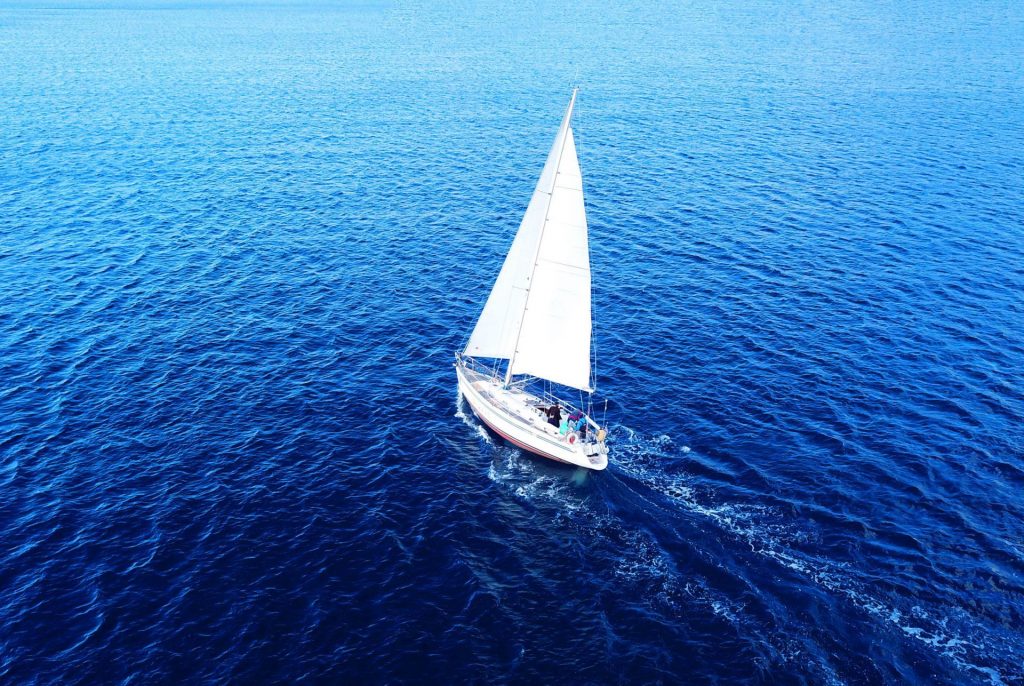
The basics of sailboat design play a significant role in the classification and function of these vessels. Hull shapes, keel types, and construction materials contribute to the speed, stability, and maneuverability of sailboats. Additionally, rigging and sails come in various shapes and sizes, which influence sailing performance and handling.
Key Takeaways
- Sailboats are classified by hull design, rigging, and sails that serve specific purposes.
- Designs and materials have a direct impact on the performance and handling of sailboats.
- A wide range of sailboat types exists, which cater to different needs and preferences.
Basics of Sailboat Design
Sailboats come in various shapes and sizes, designed for different purposes and sailing conditions. One can classify sailboats based on hull types, keel types, and mast configurations. This section will briefly discuss these basic components of sailboat design.
There are mainly two types of hulls: monohull and multihull.
- Monohull : This is the traditional and most common type of sailboat hull. It consists of a single hull, providing stability through the use of a keel or centerboard. Monohulls come in various shapes and sizes, suitable for various sailing conditions.
- Catamaran : Catamarans have two parallel hulls of equal size, offering increased stability and speed compared to monohulls. They are commonly used for cruising and racing.
- Trimaran : Trimarans have three hulls, with a larger central hull and two smaller outrigger hulls. This design offers even more stability and speed than catamarans.
The keel is an essential component in sailboat design, helping with stability and performance. There are various keel types, including:
- Full keel : This traditional design features a long and wide keel that extends along the boat's bottom. It offers good tracking and stability but sacrifices speed and maneuverability.
- Fin keel : Fin keels are shorter and deeper than full keels, providing a better combination of stability and maneuverability. These are common in modern monohull sailboats.
- Bulb keel : A bulb keel features a fin keel with a heavy bulb at the bottom, which concentrates the boat's weight, increasing stability and performance in rough conditions.
- Swing keel or centerboard : Swing keels and centerboards can be raised or lowered, allowing the boat to adapt to different water depths and sailing conditions. They are common in smaller boats and racing sailboats.
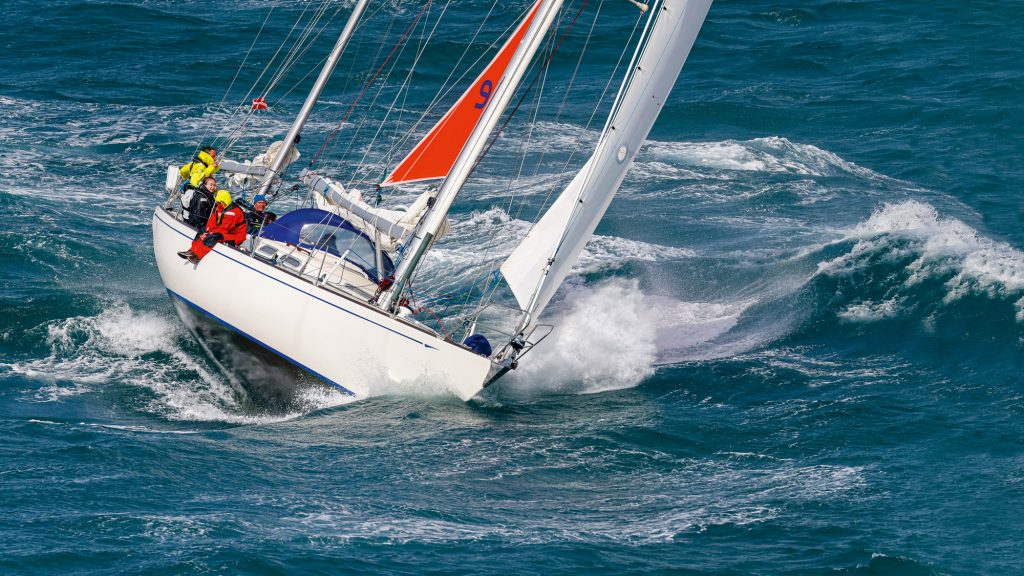
Mast Configuration
The mast configuration affects the sail plan and overall performance of a sailboat. Some common mast configurations include:
- Sloop : This is the most popular mast configuration and features a single mast with a mainsail and a headsail. The simple design makes it easy to handle and suitable for various sailing conditions.
- Cutter : Similar to the sloop, the cutter also has a single mast but carries two headsails, providing more sail area and better performance in heavy weather.
- Ketch : A ketch configuration has two masts: a taller main mast and a shorter mizzen mast. This design offers more flexibility in sail combinations and better balance in different sailing conditions.
- Yawl : Similar to a ketch, a yawl also features two masts but the mizzen is located further aft and is smaller. This design provides better balance and control, particularly in downwind sailing scenarios.
In conclusion, the basics of sailboat design involve selecting the appropriate hull type, keel type, and mast configuration for the desired sailing performance and conditions. Understanding these concepts can help sailors make informed decisions when choosing a sailboat or planning their sailing adventures.
Rigging and Sails
When it comes to sailboats, the rigging and sails play a crucial role in the boat's overall performance and capabilities. This section will briefly cover popular rig types and sail types seen on different sailboats.
There are several types of rigs commonly found on sailboats:
- Sloop : Sloops are the most common type of rig found on modern sailboats. They have a single mast with a mainsail and a single headsail, typically a genoa or jib.
- Ketch : Ketches have two masts, with the main mast taller than the mizzen mast situated aft. They carry a mainsail on the main mast and a mizzen sail on the mizzen mast. Ketches benefit from easier handling and reduced sail area under strong winds.
- Yawl : Similar to ketches, yawls have two masts, but the mizzen mast is smaller and sits further aft, behind the rudder post. Yawls are often chosen for their graceful appearance and improved balance.
- Schooner : Schooners have two or more masts, with the aft mast(s) typically taller than the forward mast(s). Schooners can handle more sails, offering increased sail area for better performance, especially downwind.
- Catboat : Catboats are single-masted sailboats with a single, large mainsail and no headsails. They have a wide beam, which provides stability and ample space for passengers.
- Cutter : Cutters are similar to sloops but carry two headsails, usually a jib and staysail. Cutters may have multiple headsails for increased versatility in various wind conditions.
In addition to the types of rigs, there are also several types of sails used on sailboats, including:
- Mainsail : The primary sail attached to the back of the main mast. It is typically raised on a track or luff groove and managed by a combination of halyard, sheet, and boom vang.
- Genoa : A large triangular sail that overlaps the mainsail, typically used in light winds to provide additional surface area for better performance.
- Jib : A smaller, non-overlapping triangular sail attached to the forestay. Jibs are easier to manage than genoas and are used in a variety of wind conditions.
- Spinnaker : A large, lightweight sail used primarily for downwind sailing . Spinnakers are often brightly colored and shaped like a parachute to catch wind efficiently.
- Staysail : A smaller sail typically used in cutter rigs, positioned between the main mast and the forestay. Staysails provide additional sail area and versatility in varied wind conditions.
Understanding the relationship between sail and rigging can help sailors optimize the performance of their sailboats. With various options for rig types and sail types, each sailboat can be configured to meet the unique needs of its skipper and crew.
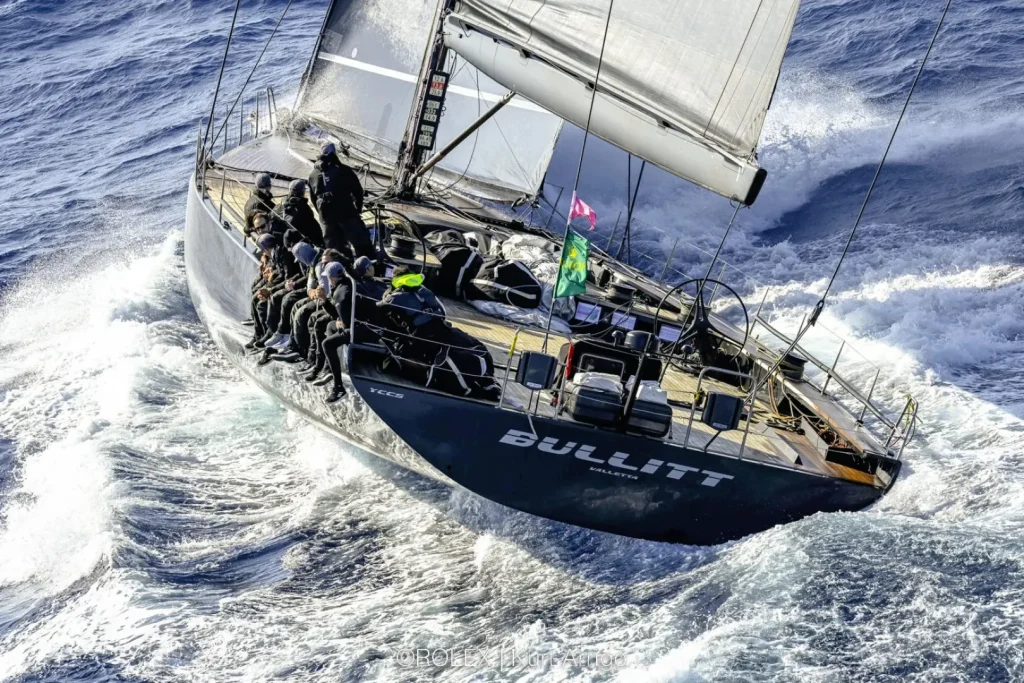
Classes and Types of Sailboats
Monohulls are the most common type of sailboats, consisting of a single hull that provides stability and balance. They come in various sizes and designs, depending on their intended use. Some popular monohull sailboats include the Optimist , Finn, and Sunfish, which are frequently used for racing and recreational sailing. Monohulls tend to have a deeper draft, requiring more water depth than their multi-hull counterparts.
Multihulls, also known as multi-hull sailboats, are a more modern innovation in sailing. They feature two or more hulls connected by a frame or bridgedeck. This design offers increased stability and speed over monohulls. Some common types of multihulls are catamarans (with two hulls) and trimarans (with three hulls). Due to their wider beam and shallower draft, multihulls are particularly suitable for cruising in shallow waters and provide more living space on board.
One-Design Sailboats
One-Design sailboats are a specific class of racing sailboats in which all boats are built to the same design specifications, ensuring that the competition focuses on the skill of the sailor rather than the design of the boat. These boats must adhere to strict rules and standards, with minimal variations allowed in terms of hull shape, sail area, and rigging. Some popular one-design sailboats include the Enterprise and the aforementioned Optimist and Finn sailboats.
Dinghies and Skiffs
Dinghies and skiffs are small, lightweight sailboats that are often used for sailing classes, short-distance racing, or as tenders to larger boats. Dinghies usually have a single mast with a mainsail and sometimes a small jib. Some popular types of sailing dinghies include the Optimist, which is specifically designed for children, and the versatile Sunfish sailboat. Skiffs, on the other hand, are high-performance sailboats primarily used for racing. They have a larger sail area relative to their size and typically include features such as trapezes and planing hulls, which allow for faster speeds and greater maneuverability.
In conclusion, there are various classes and types of sailboats, each with its own unique features and characteristics. From the simplicity of monohulls to the stability and speed of multihulls, and from the fair competition of one-design sailboats to the excitement of dinghies and skiffs, there is a sailboat to satisfy every sailor's preferences.
Sailboat Size and Use
When exploring the world of sailboats, it's important to understand their different sizes and purposes. Sailboats can be categorized into three main types, each with unique characteristics and uses: Day Sailers , Racing Sailboats, and Cruising Sailboats .
Day Sailers
Day Sailers are small sailboats typically ranging from 10 to 24 feet in length. These boats are perfect for short sailing trips and are easy to maneuver for beginners. They have limited accommodations on board, providing just enough seats for a small group of people. Some popular day sailer models include the Laser, Sunfish, and Flying Scot. Lightweight and agile, Day Sailers are often used for:
- Recreation: casual sailing or exploring nearby waters with family and friends
- Training: beginner sailing lessons or practicing sailing techniques
- Competition: local club races or interclub regattas
Racing Sailboats
Racing Sailboats are designed to provide maximum speed, maneuverability, and efficiency on the water. Sizes may vary greatly, from small dinghies to large yachts. Key features of racing sailboats include a sleek hull shape, high-performance sails, and minimalistic interiors to reduce weight.
Career racers and sailing enthusiasts alike participate in various types of racing events , such as:
- One-design racing: all boats have identical specifications, emphasizing crew skill
- Handicap racing: boats of different sizes and designs compete with time adjustments
- Offshore racing: long-distance racing from one point to another, often around islands or across oceans
Cruising Sailboats
Cruising Sailboats are designed for longer journeys and extended stays on the water. They typically range from 25 to 70 feet in length and provide comfortable accommodations such as sleeping cabins, a galley, and storage spaces for supplies and equipment. Sailing cruisers prioritize stability, comfort, and durability for their voyage.
Here are some common types of cruising sailboats:
- Cruiser-racers: These boats combine the speed of a racing sailboat with the comfort and amenities of a cruising sailboat. They are ideal for families or sailors who enjoy participating in racing events while still having the option for leisurely cruises.
- Bluewater cruisers: Designed for handling the world's most demanding ocean conditions, bluewater cruisers are built with a focus on sturdy, self-reliant sailboats that can withstand long-distance voyages and challenging weather conditions.
- Multihulls: Catamarans and trimarans are gaining popularity in the cruising world for their typically more spacious interiors and level sailing characteristics. With two or three hulls, multihulls offer high levels of stability and speed for a comfortable cruising experience.
Understanding the differences between various sailboat types will help potential sailors select the perfect vessel for their sailing goals, skills, and preferences. Day Sailers, Racing Sailboats, and Cruising Sailboats each have their unique features, catering to distinct uses and sailing experiences.
Advanced Sailboat Features
Sailboats have evolved over time, and many advanced features have been developed to enhance performance and safety. In this section, we will discuss some of the key advanced features in modern sailboats, focusing on performance enhancements and safety/navigation.
Performance Enhancements
One critical component that impacts a sailboat's performance is the type of keel it has, which affects stability, resistance, and maneuverability . There are several kinds of keels such as fin keel , wing keel , and bulb keel . Fin keels offer low drag and high efficiency, making them suitable for racing sailboats. On the other hand, wing keels provide better stability at low speeds, while bulb keels provide a lower center of gravity to enhance overall stability and comfort during long voyages.
Another feature that contributes to a sailboat's performance is its sails and rigging. The jib is a triangular sail at the front of the boat, which helps improve its upwind performance. More advanced sailboats use a combination of shrouds , which are the supporting cables running along the sides of the boat, and stays , the cables that help hold the mast in place, to create a stable and efficient rigging system.
A sailboat's performance can also be influenced by the presence of a centerboard or daggerboard , which can be adjusted to optimize stability, maneuverability, and speed. When racing or navigating in shallow waters, retractable centerboards and daggerboards are particularly useful as they provide better performance and versatility.
Safety and Navigation
Safety and navigation onboard a sailboat relies on a combination of advanced gear and equipment. A modern sailboat is usually equipped with:
- GPS and chartplotters to assist with navigation and planning routes
- VHF radios for communication with other vessels and authorities
- Radar to detect obstacles, weather systems, and other vessels
- AIS (Automatic Identification System) which helps monitor nearby vessel traffic
The design of a sailboat's hull, rigging, sails, and hardware also contribute to its safety. The boom , the horizontal pole that extends the sail, should be properly secured and designed to avoid accidents while sailing. The keel , whether it's a fin, wing, or bulb keel, plays a vital role in the overall stability and safety of the sailboat. The choice of keel should be based on the intended use of the sailboat and the prevailing sailing conditions.
In summary, advanced sailboat features significantly improve the performance, safety, and navigation capabilities of modern sailboats. Innovations in keel design, rigging systems, and onboard navigational equipment have undoubtedly contributed to the overall enjoyment and safety of sailing.
Sailboat Ownership
Buying Considerations
When considering buying a sailboat , it is important to understand the different types of sailboats available and the purpose each serves. Sailboats can be broadly categorized into three types:
- Racing sailboats: Designed for speed and performance, with minimalistic interiors and advanced sail systems.
- Cruising sailboats: Built for comfort and longer trips, featuring more spacious interiors and amenities.
- Daysailers: Smaller, easy-to-handle boats that are often used for short trips and recreational sailing.
Prospective boat owners should consider factors such as boat size, type, budget, and intended use (solo vs. family sailing, charter operations, etc.). It's also essential to evaluate the availability of necessary gear and the level of experience required to handle the chosen sailboat.
Maintenance and Upkeep
Sailboat ownership involves maintenance and upkeep to ensure the boat remains functional, safe, and holds its value. Some common maintenance tasks include:
- Hull cleaning and inspection: Regularly inspect the hull for damages and clean off any growth to maintain performance and fuel efficiency.
- Antifouling paint: Apply antifouling paint to prevent marine organisms from attaching to the hull, which can negatively impact the boat's performance.
- Engine maintenance: Check and replace engine oil, inspect cooling and fuel systems, and clean or replace air filters.
In addition to regular maintenance, sailboat owners should also be prepared to replace or repair critical systems and components, such as:
- Sails: Monitor the condition of your sails and replace them as needed to maintain performance and safety.
- Rigging: Regularly inspect and maintain the standing and running rigging, and replace worn or compromised parts.
- Electronics and instruments: Ensure navigation systems, radios, and other electronic equipment are functioning properly.
Taking proper care of a sailboat can be time-consuming, and some owners may choose to charter their boats when not in use as a way to offset ownership costs. Others may opt for hiring professionals to manage routine maintenance, particularly when sailing solo or with limited sailing experience.
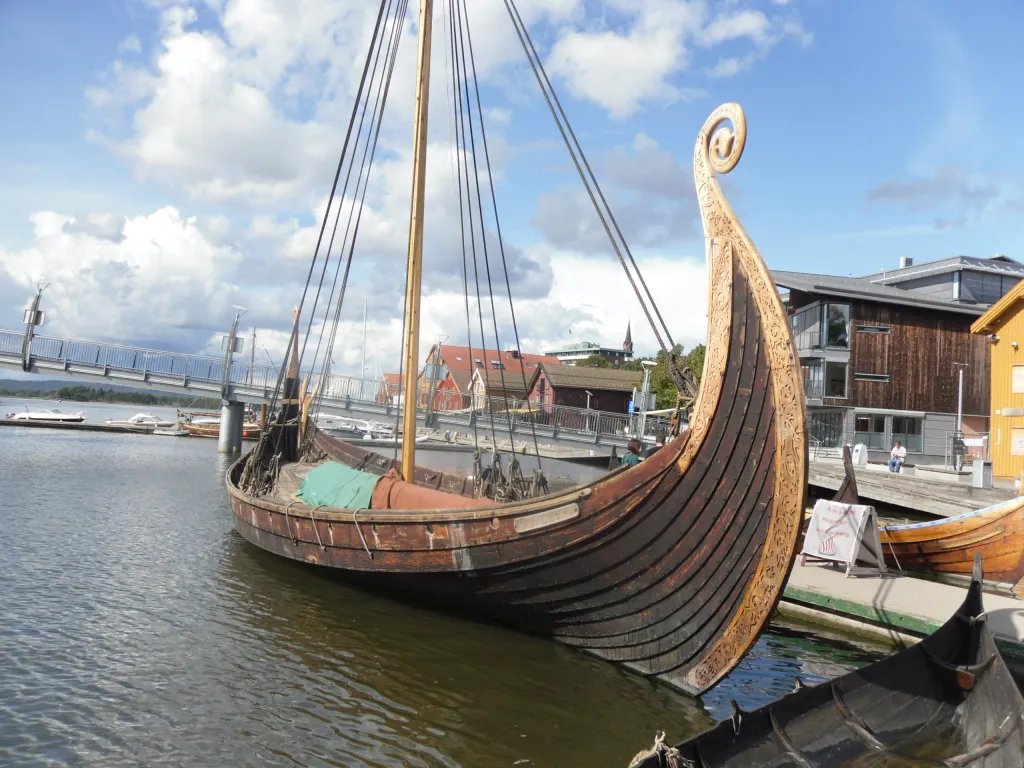
Historical and Special Sailboats
Tall ships and gaffers.
Tall Ships are large, traditionally rigged sailing vessels with multiple masts, typically square-rigged on at least one of their masts. Some examples of these ships include the clipper, brig, and square-rigged vessels. The clipper is a fast sailing ship known for its sleek hull and large sail area, while the brig features two square-rigged masts. Square-rigged ships were known for their impressive sail area and could cover large distances quickly.
Gaffers are a subset of historical sailing vessels with a gaff mainsail as their primary sail type. This gaff-rig is characterized by a spar (pole) that extends the top edge of the mainsail, giving it a quadrilateral shape to optimize wind coverage. Gaff mainsails were commonly used in England and influenced the development of other sailing vessels.
Classic and Antique Sailboats
Classic and antique sailboats refer to older, traditionally designed sailing vessels that have been preserved or restored. They often feature wooden construction and showcase a variety of rigging types, including gaff rigs and square rigs. These historical sailboats have unique designs, materials, and techniques that have since evolved or become rare.
Here are some examples of antique and classic sailboats:
- Sloop : A single-masted sailboat with a Bermuda rig and foresail
- Cutter : A single-masted vessel with a similar rig to the sloop, but with additional headsails for increased maneuverability
- Ketch : A two-masted sailboat with a smaller mizzen mast aft of the main mast
In summary, historical and special sailboats encompass a wide range of vessel types, from large, multi-masted tall ships to smaller, single-masted gaffers and classic sailboats. These vessels reflect the rich maritime history and the evolution of sailing techniques and designs over time.
Sailboat Culture and Lifestyle
Sailboat culture and lifestyle encompass a variety of aspects including racing events, leisurely cruising, and exploring new destinations. The main types of sailboats include racing yachts, cruising sailboats, and motorsailers, each offering a unique experience for sailors.
Regattas and Racing Circuits
A popular aspect of sailboat culture involves participating in regattas and racing circuits . These events create a competitive atmosphere and develop camaraderie among sailors. Racing sailboats are specifically designed for speed and agility , and sailors often team up to compete in prestigious races such as the Rolex Sydney Hobart Yacht Race or the America's Cup. Yacht clubs play an essential role in cultivating this competitive sailing environment.
Sailboat Charter and Tourism
Another facet of sailing culture is the sailboat charter and tourism industry, which allows people to experience the cruising lifestyle without owning a sailboat. Charters are offered for various types of sailboats, from family-sized cruising vessels to luxurious superyachts . Yacht sailing provides tourists with a unique travel experience, as they can explore diverse destinations, immerse themselves in local cultures, or simply relax on the open water.
Cruising sailboats are designed to provide comfortable living spaces and amenities, making them perfect for longer journeys or exploring remote destinations. Motorsailers, on the other hand, are equipped with both sails and engines, offering versatility and convenience for sailors.
Some popular sailing destinations include the Caribbean, Mediterranean Sea, and the South Pacific. These regions offer beautiful scenery, rich cultural experiences, and ideal sailing conditions.
The sailboat culture and lifestyle attract individuals who enjoy adventure, exploration, and camaraderie. From competitive racing events to leisurely cruising vacations, sailing offers diverse experiences that cater to a wide range of interests.
Frequently Asked Questions
What are the distinguishing features of different sailboat classes?
There are various sailboat classes, each with its own distinguishing features. Monohulls, for example, are the most common type of sailboat and have a single hull. Multihulls, such as catamarans and trimarans, have two or three hulls, respectively. These differences in hull design often affect the boat's stability, speed, and maneuverability.
Which sailboat types are best for novice sailors?
Novice sailors often benefit from starting with smaller, more manageable boats. Sailing dinghies and daysailers are popular choices due to their simple rigging and ease of handling. These boats typically have a single mast and a limited number of sails, making them ideal for beginners to learn sailing basics.
What are common types of small sailboats ideal for day sailing?
For day sailing, small sailboats such as sailing dinghies, day sailers, and pocket cruisers are ideal options. These boats usually range between 12 and 25 feet in length and offer simplicity, ease of handling, and portability. Examples of common day sailing boats include the Sunfish, Laser, and O'Day Mariner.
How do the purposes of various sailboat types vary?
Sailboats serve different purposes based on their design, size, and features. Daysailers and dinghies are ideal for short trips, sailing lessons, and casual outings. Racing sailboats, with their lighter weight and streamlined design, are built for speed and competition. Cruising sailboats, on the other hand, are designed for longer voyages and often include living quarters and additional amenities for comfortable onboard living.
What is considered the most popular class of sailboat for recreational use?
The most popular class of sailboat for recreational use often varies depending on individual preferences and local conditions. However, monohulls are commonly preferred due to their widespread availability, versatility, and affordability. Within the monohull class, boats like the Sunfish, Laser, and Catalina 22 are popular choices for their ease of use and adaptability to various sailing conditions.
Could you describe a sailing dinghy designed for two people?
A two-person sailing dinghy typically has a simple rig with a single mast and one or more sails, making it easy to handle for both experienced and novice sailors. The RS Venture , for example, is a popular choice for two-person sailing. It features a spacious cockpit, durable construction, and simplicity in its rigging and control systems. These characteristics make it an excellent option for recreational sailing, training, and even racing.
Related Articles
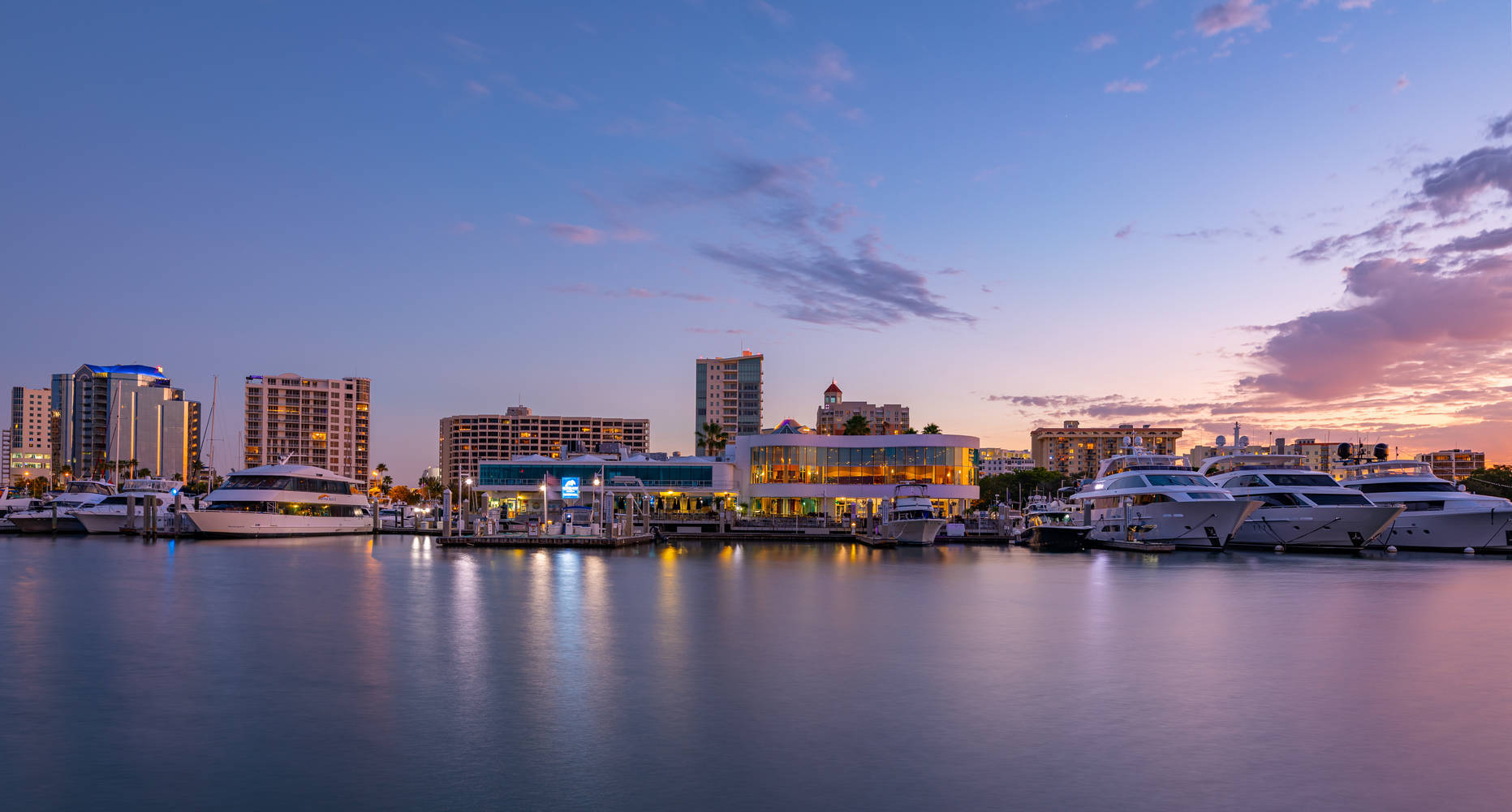
Marina Jacks- Sarasota's Premier Marina
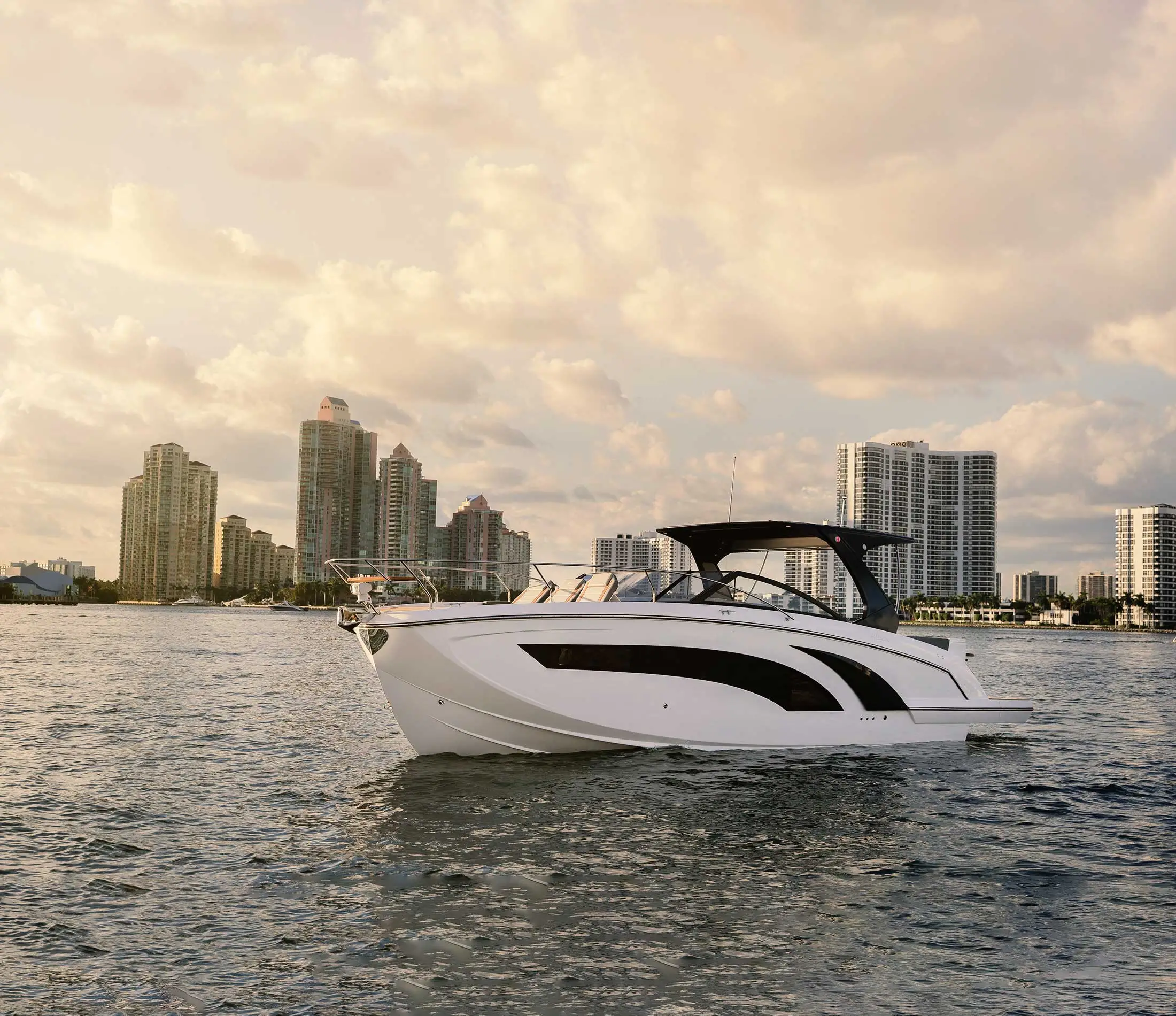
Hanover Yachts, All Models, Spec, Pricing: The 2024 Ultimate Buying Guide

Pavati Boats Models, Spec, Prices, Competition: An Expert Overview
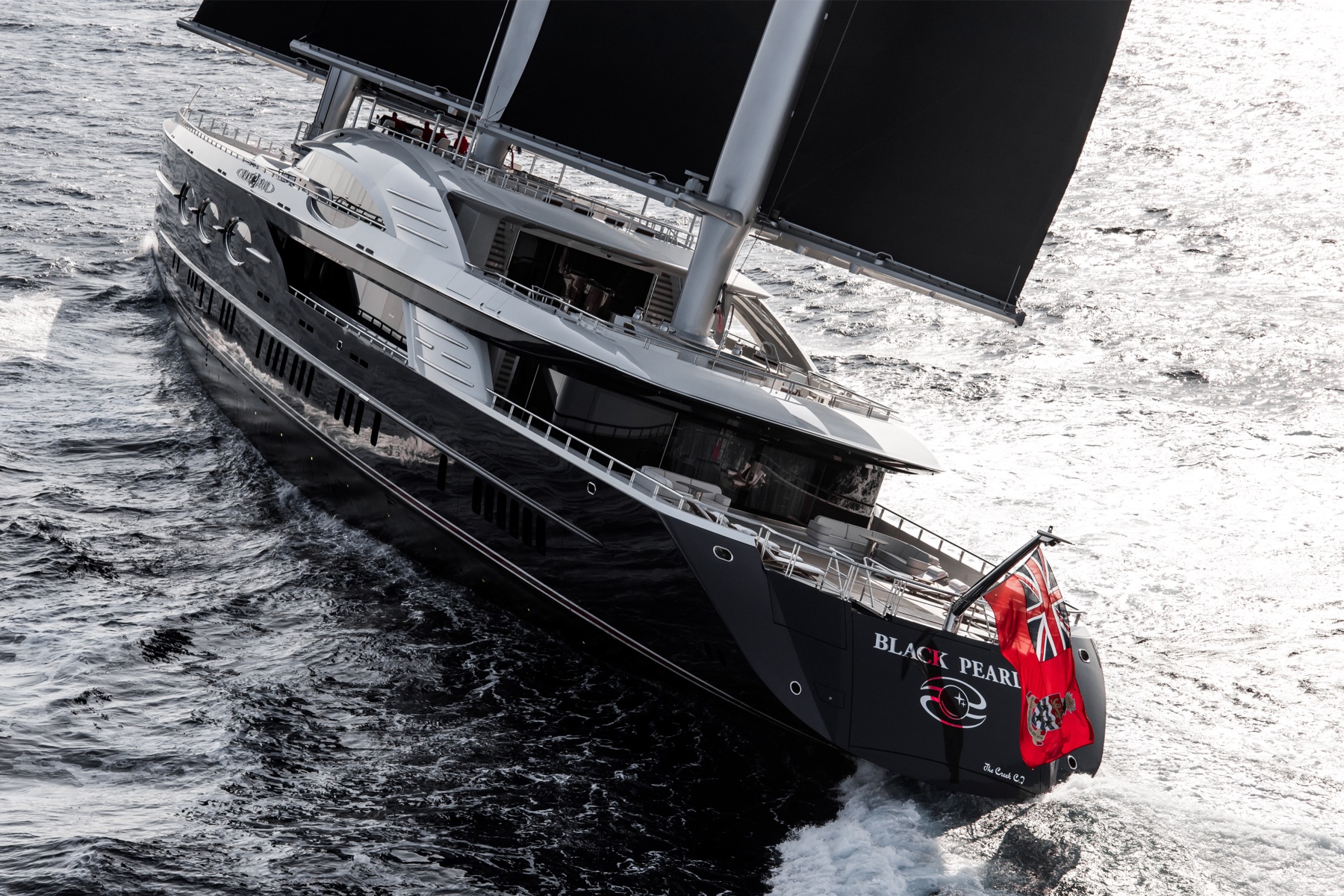
Jeff Bezos' $500 Million Yacht: A Look at the World's Largest Private Vessel

Jl Audio's Newest Offering for Boating Sound Systems: Revolutionizing Marine Audio

Which of These Causes the Most Boating Collisions? Top Factors Explained

Low Head Dam Dangers: Essential Safety Measures and Awareness

It's Not The Size of Your Antenna-It's where you put it
- Pontoon Boats
- Personal Watercraft
- nauticalknowhow
- Nautical Knots
- Tools and Calculators
Types of Sailboats: Classification Guide
Sailboats can be divided into three basic types based on their hulls (catamaran, monohull or multihull) , their keel and their rigging, and then further subdivided from there. The result is that there are actually well over a dozen different kinds of sailboats out there.
Sailboat Hull Types
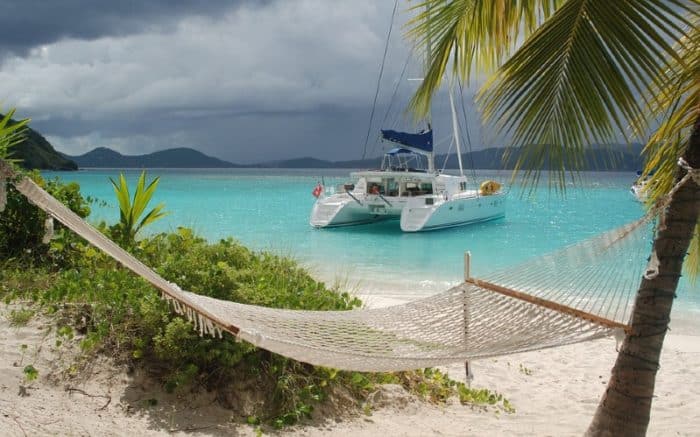
There are three main hull types that you’ll find in sailboats.
- Monohull: This is what most people think of when they think of a sail boat or any boat at all, really. A monohull sailboat has a single hulled structure that gives a boat that traditional boat shape we all instantly recognize. These are far and away the most common hull type for sailboats because they’re some of the oldest, they’re cheaper to produce, and they are fairly easy to maintain compared to the other options. You can do a lot more with the rigger in monohull sailboats and any sailing vessel with multiple masts is invariably going to be a monohull one. The downside of the monohull compared to the others is that they lack the stability.
- Catamaran: The second hull type you’ll find in sailboats is the catamaran . While technically a multihull vessel, they feature two hulls that are located on either side of the boat connected by a deck. Because it’s just the two, they get called catamarans rather than multihull which generally refers to three. Catamarans had been used by ancient peoples for years but never really caught on with “modern” boating for quite a long time. Now that we have fiberglass hulls and other advances, catamarans are much more commonplace than they were a hundred years ago. Catamarans offer great speed and stability but don’t have as much cabin space as a monohull.
- Trimaran/Multihull : This hull style features three hulls in a similar style to the catamaran with the addition of that third center hull. From the side you wouldn’t be able to tell a catamarans from trimaran sailboats. These boats are even faster and more stable than a catamaran and, by extension, a monohull. They have a very low center of gravity and a large beam. Space is still a drawback but the third hull increases room overall. There are also vessels with even more hulls, but they are exceedingly rare and also pretty expensive.
Sailboat Keel Types
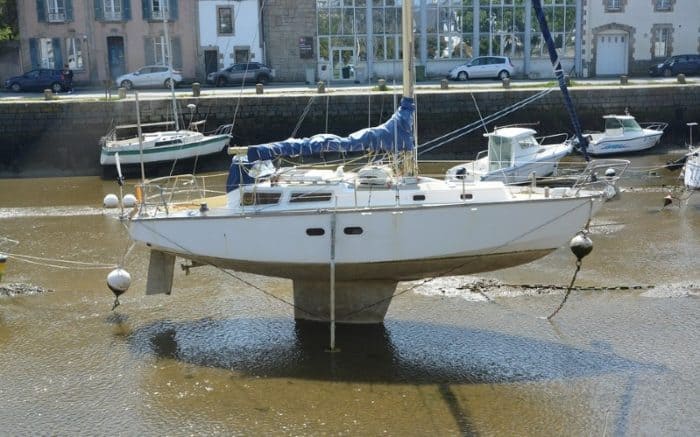
Heading below the hull now and we’ll find the keel, which is what gives your sailboat added stability in the water. While multihull boats find stability in the additional hulls, a monohull boat will get stability from its keel. Though it’s nearly impossible to flip or capsize a trimaran, if it does happen it’s staying flipped or capsized. However, the keel on a monohull boat makes it even harder to flip because of the physics of resistance in the water. That isn’t to say a monohulled boat with a keel is unsinkable, quite the opposite, but you’re just not going to flip one upside down without a real fight. There are six main keel types you’ll find in sailboats.
- Bilge Keel: These are dual keels that can be like fin keels or even full keels extending the length of the vessel. They extend from the sides and can prevent the boat from rolling. They need to be symmetrical on both sides of the boat to work.
- Bulb Kee l: These are a kind of fin keel but they carry ballast in them. That allows them to have a little more stability. They operate like a hydrofoil
- Centerboard Keel: This type of keel actually pivots and can be changed depending on the depth of the water.
- Daggerboard Keel : Another kind of centerboard keel but the daggerboard can actually be pulled up into the hull. This allows you to alter its position for an increase or decrease in speed or stability as needed.
- Fin Kee l: If you’re into racing you’ll probably have a fin keel. They are thin but extend deep below the sailboat. This makes them great for speed but not really ideal for a comfortable ride. You wouldn’t want to be day sailing for fun and relaxation with a fin keel.
- Full Keel: This is the most common type of keel and it spans the entire length of the vessel. There will likely be a rudder built into the keel as well.
- Wing Keel : This is a variant on the fin keel. Wing keels have a small wing at the tip to allow better directional stability by reducing cross flow.
Sailboat Mast Configuration
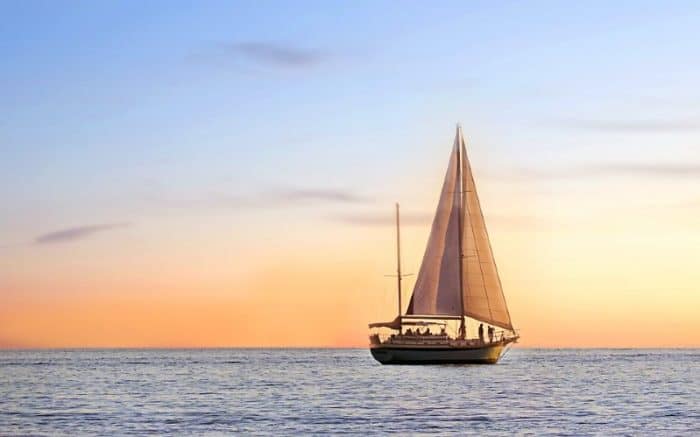
The mast of the sailboat is obviously that large pole onto which sails are rigged. Depending on your boat type you may have one mast, two masts, or more masts. How these masts are configured is where you can start distinguishing sailboat types you may recognize by name. These include:
Sloop: This is arguably the most popular type of sailboat mast type. A sloop has a single mast and two sails – the headsail and the mainsail. Being a single masted sailboat makes them easy to identify. These are probably the easiest to learn how to rig and how to sail. It’s versatile enough for cruising and for racing. Commonly these a gaff rig or a Bermuda rig. Another kind of sloop rig is the fractional rig sloop in which you can find one of the sails below the top of the mast.
Schooner: These can have multiple masts, not just two. The largest sailing vessels you’re likely to see, either in the present or in images from history, were schooners. Giant ships with six masts each bearing over 10 sails were schooners. An important detail is that the first mast on a schooner will always be shorter than the others. They are usually gaff-rigged
Cutter: This type of sailboat is very similar to the sloop and has a centrally located mast supporting three sails. Two headsails, the second called a staysail, is what distinguishes it most easily from the sloop. The rigging makes a cutter a bit harder to manage than a sloop.
Ketch : A ketch is a lot like a schooner but the two masts are arranged differently. On a ketch, the main mast is taller than the aft mast which is called the mizzen mast. The mizzen sail naturally is on the mizzen mast with the mizzen mast positioned aft.
Catboat : Also called a cat, a catboat has a single mast and a large, single gaff sail. The boats are usually short, stout boats that aren’t built for speed or for open seas. Best to be used in coastal waters
Yawl: This vessel is nearly identical to the ketch with one main difference. In a yawl, the helm is forward of the mizzen mast, while that is not the case in a ketch.
Other Types of Sailboats
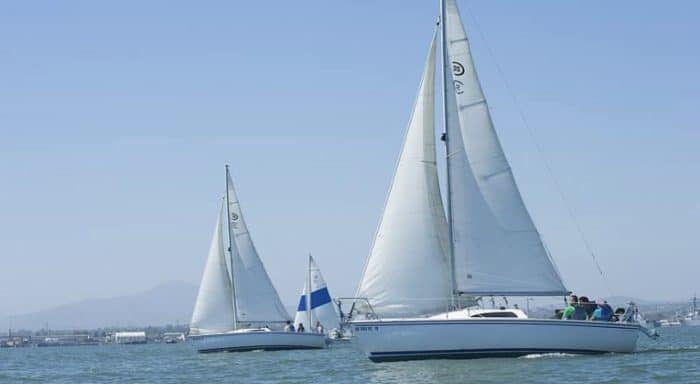
Now that we have the basic configurations out of the way, let’s look at some of the more specific types of sailboats you may find at sea. In some cases you’ll see that these terms are not entirely specific and one term may actually apply to multiple kinds of sail boats in much the same way that something like SUV can describe multiple different vehicles that are similar but not all the same.
Sailing Dinghies
Like any dinghy, a sailing dinghy is going to be a small vessel. Typically made to accommodate just one or two people, they are under 15 feet and the smallest of which are often used by children. Optimist dinghies are raced professionally and must meet certain requirements to be officially registered as true Optimist boats. If you’re totally new to sailing, a sailing dinghy might be a good place to learn the ropes.
Daysailer generally refers to any sailboat that is not intended to either race other boats or keep you out on the water for an overnight stay. As such, it can cover a lot of ground. Typically, a daysailer will probably be between 14 feet and 20 feet. Usually you won’t get more than 4 people on board and there will be room for storing gear but not a sleeping berth. These are great beginner sailboats.
Pocket Cruisers
Like a daysailer, a pocket cruiser is more of a general label for boats rather than a specific kind. In this case, any sailboat under 30 feet could technically be considered a pocket cruiser. Basically it should be trailerable and used for either cruising or racing. They may contain a small cabin or berth. They could be outfitted for long offshore trips.
Trailer Sailer
Very similar to a pocket cruiser, a trailer sailer is a smaller vessel but still larger than a sailing dinghy. There is clear overlap between trailer sailers, daysailers, and pocket cruisers and the same name could technically be used for many different boats. The defining characteristic of a trailer sailer is that it can easily be transported by trailer behind your tow vehicle. Unlike a sailing dinghy, a trailer sailer would likely have a retractable keep like a centerboard or daggerboard.
Racing Sailboats
These boats can be very large, anywhere from 20 feet to over 70 feet, and they are designed to be light and fast on the water. Larger racing sailboats required a skilled crew to operate. These have keels intended to increase speed and even laminate sales to improve performance. Smaller racing boats can be manned by just one or two people. They don’t offer a lot of creature comforts and aren’t meant for relaxing trips at sea.
Beach Catamarans
Beach cats get their name from the fact they’re designed to be beached and can be launched again from the beach if you so desire. They are usually under 25 feet and not meant for extending sailing offshore, rather they are designed for daysailing. They are very agile and fast and take a good foundation of knowledge to control properly.
Cruising Catamarans
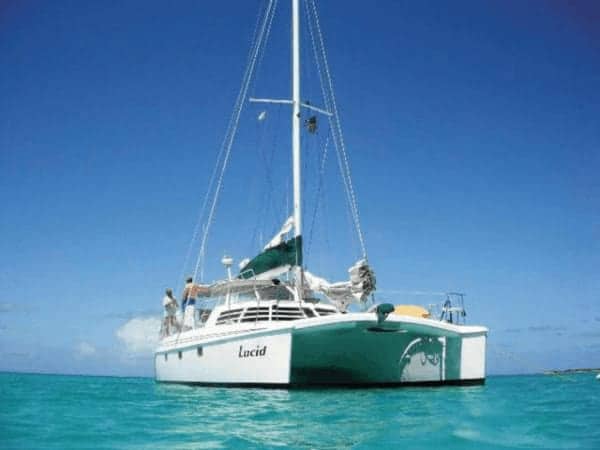
This is the larger style of catamaran designed for more serious boating. Like any catamaran they have a shallow draft but these can be between 25 feet and up to more than 50 feet. They’re designed for extended cruising offshore.
Cruising Sailboats
Boats like schooners quality as a cruising boat and they are typically at least 16 feet in length but may get well over 50 feet as well. Cruising sailboats include cabins for extended stays offshore and, if the boat is large enough, will likely have a fairly large living space below deck which includes a galley and a head in addition to sleeping berths. These are often called liveaboard sailboats .
Cruisers are often monohull but can just as easily be multihull. When properly outfitted they can be used for long, extended stays at sea that last weeks or more. Depending on rigging a cruising sailboat could easily be a sloop, a schooner, a cutter, a ketch or even a superyacht.
Racing Cruisers
This is essentially a hybrid of the cruising sailboat and the racing sailboat. It’s built for more speed than a cruiser but it will have better accommodations than a racing sailboat to allow for stays at sea. The end result is a lighter cruiser ideal for a few days at sea that can get some good speed.
Bluewater Cruising Boats
These are basically the next step up from a cruising sailboat. A bluewater cruiser is meant to sail across oceans, which is where the bluewater part of the name comes from. These are large sailboats and are best only sailed by skilled sailors. They can be outfitted for very long stays at sea and are able to handle rough weather better than smaller vessels.
Motorsailers
You don’t hear this term much anymore but it refers to a sailboat that also has an inboard motor so that they can travel under engine power or wind power. Typically these are larger vessels with accommodations below deck and designed for extended stays off shore. That said, because they mix both styles of boat, they fall somewhere short of either in terms of performance. The engine takes up space and adds weight, limiting your sailing abilities. Obviously traditional sailboats won’t include a motor.
The Bottom Line
There are a number of different kinds of sailboats and the easiest way to distinguish them is by comparing hull types, sail and mast configuration, and keels. Many terms you hear to describe sailboats can describe more than one kind, while others are very specific and the boat must meet certain requirements to merit the name. The only thing that truly unites every type of sailboat is the fact it must be powered by the wind, and even then there are hybrid versions that use motor power sometimes.
Learning the rigging of the different types of sailboats, including things like gaff rigs, standard rigging, and other rig types can be hard work and time consuming as some of these sailing boat rig types are far more complex than others.
My grandfather first took me fishing when I was too young to actually hold up a rod on my own. As an avid camper, hiker, and nature enthusiast I'm always looking for a new adventure.
Categories : Boats
Leave a Reply Cancel reply
Your email address will not be published. Required fields are marked *
Save my name, email, and website in this browser for the next time I comment.
More in Boats

What Is A Gunwale?

131 of the Best Hawaiian Boat Names

167 Patriotic Boat Names

The 138 Best Boat Names for Dog Lovers

The People’s Poncho Review and Ratings

Oru Lake Kayak Review

About Boatsafe
Established in 1998, BoatSafe is your independent guide into the world of boating, fishing, and watersports. We provide expert insights and detailed guides to help you find products tailored to your needs and budget.
Contact Boatsafe
- Address: 4021 West Walnut Street. Rogers, AR 72756
- Phone: (479)339-4795
- Email: [email protected]
Site Navigation
- How We Test
- Corrections Policy
- Privacy Policy
- Terms & Conditions
- Editorial Policy
- Affiliate Disclosure
Our Reviews

All content is © Copyright 2024. All rights reserved.

All You Need to Know: Explaining the Different Types of Sailboats
Sailboats are a type of watercraft that are powered by the wind. They come in a variety of shapes and sizes, each with its unique characteristics and features. Understanding the different types of sailboats and their uses can be helpful for those who are interested in sailing or looking to purchase a sailboat.
Several factors determine the types of sailboats, including the hull type , keel type , mast configuration, and sails and rigging . The hull is the boat’s body and can be either a monohull, catamaran , or trimaran .
The keel is the underwater part of the hull that provides stability and can be either a fin keel, wing keel, bilge keel, daggerboard, or centerboard. The mast configuration and sails determine how the boat is powered, and can be a sloop, fractional rig sloop, ketch, schooner, yawl, cutter, or cat.
Types of Sailboats
Sailboats come in many different shapes and sizes, each designed for a specific purpose. Here are the most common types of sailboats:
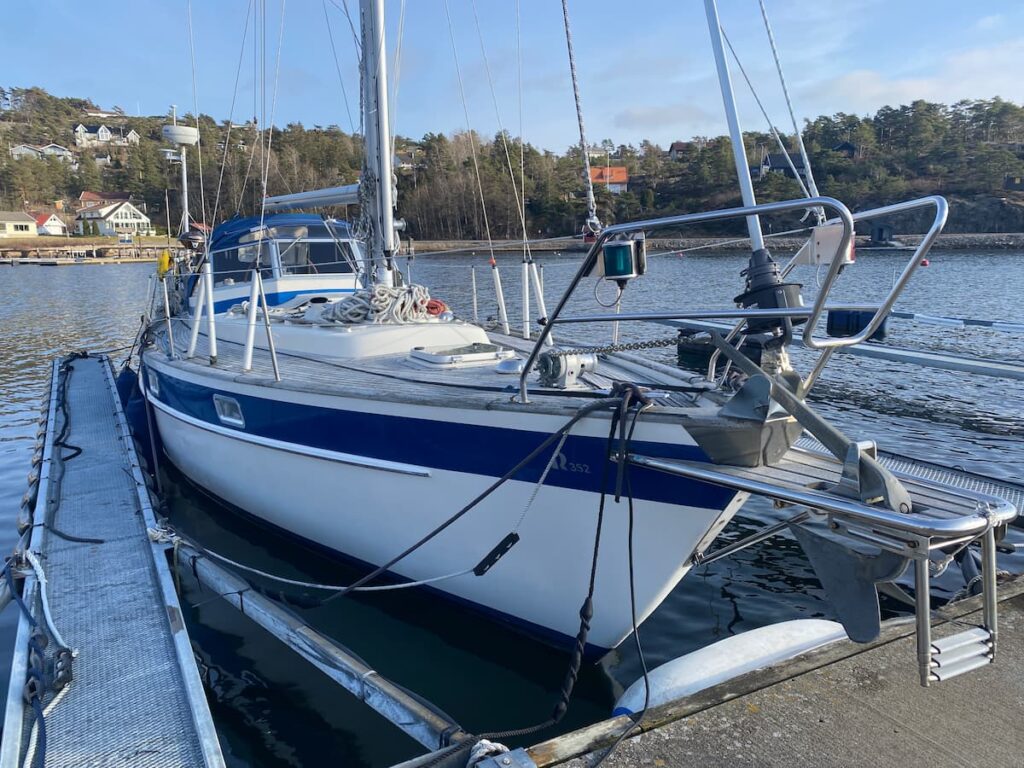
Cruising Sailboats
Cruising sailboats are designed for long-distance sailing and living aboard. They typically have a spacious interior with a galley, head, and sleeping quarters. They also have a large fuel and water capacity to allow for extended time at sea. Cruising sailboats come in many different sizes, from small pocket cruisers to large bluewater yachts.
Racing Sailboats
Racing sailboats are designed for speed and agility. They typically have a lightweight hull and a tall mast with a large sail area. Racing sailboats come in many classes , from dinghies to large offshore racing yachts. They are designed to be sailed by a skilled crew and require a high level of skill and experience to handle.
Daysailers are designed for short trips and day sailing. They typically have a simple interior with minimal accommodations. Daysailers come in many different sizes, from small dinghies to larger keelboats. They are easy to handle and are a great choice for beginners or for those who want to enjoy a day on the water without the hassle of a larger boat.
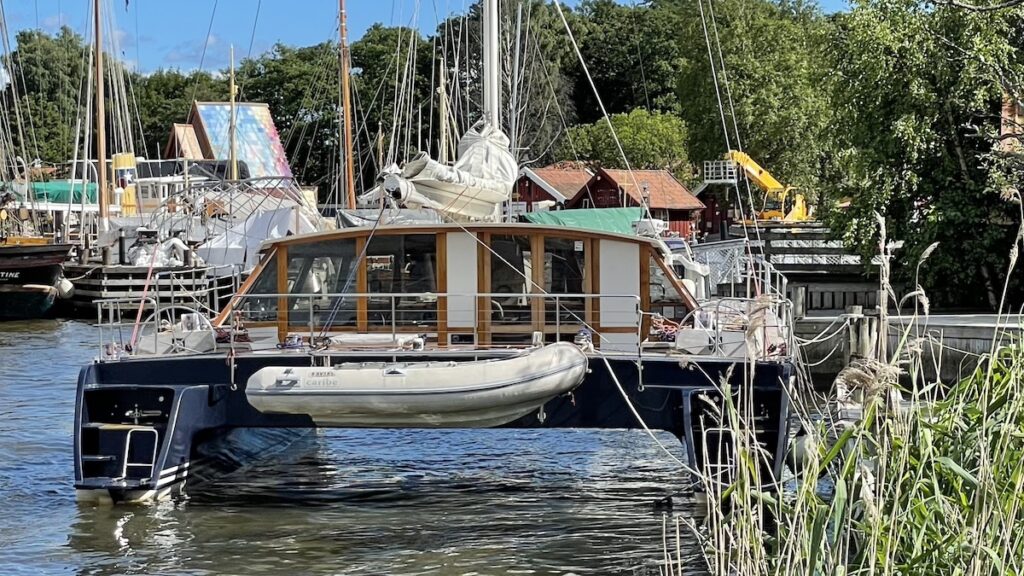
Catamarans are sailboats with two hulls. They are designed for stability and speed and are often used for cruising or racing. Catamarans have a spacious interior and a large deck area, making them a popular choice for those who want to live aboard or entertain guests. They are also popular for chartering and can be found in many popular sailing destinations around the world.
Trimarans are sailboats with three hulls. They are designed for speed and stability and are often used for racing or long-distance cruising. Trimarans have a narrow hull and a large sail area, making them incredibly fast and agile on the water. They are also popular for their spacious interior and large deck area, making them a great choice for those who want to live aboard or entertain guests.
Sailboat Hull Types
When it comes to sailboats, there are two main categories of hull types: monohull and multihull. Each has its unique characteristics and advantages.
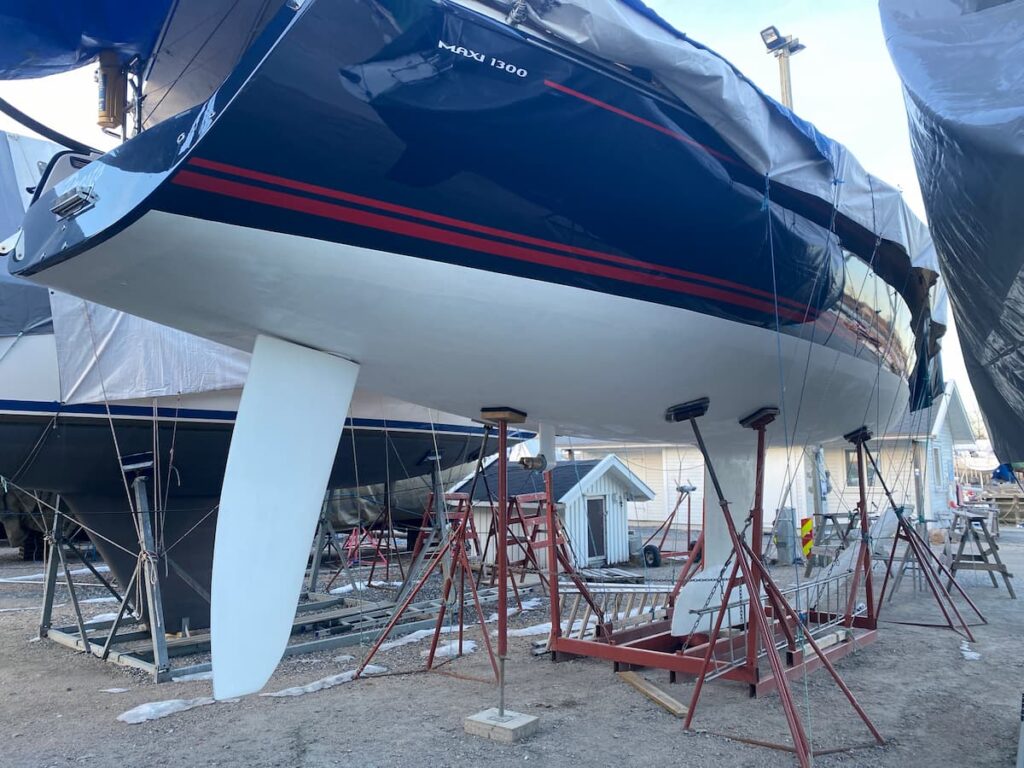
Monohull Sailboats
Monohull sailboats are the most common type of sailboat. They have a single hull, and the hull is typically long and narrow, which makes them more efficient when sailing upwind. Monohulls come in a variety of styles, including:
- Flat-bottom vessels
- Fin-keel racers
- Bulb and bilge keel cruisers
- Heavy semi-displacement sailboats
- Dense full-keel displacement cruisers
Each of these styles has its advantages and disadvantages. For example, flat-bottom vessels are the most stable, but they don’t work well in deep waters. Fin-keel racers are designed for speed and performance but may not be as comfortable for long-term cruising.
Multihull Sailboats
Multihull sailboats have two or more hulls. The most common types of multihulls are catamarans and trimarans. Multihulls have several advantages over monohulls, including:
- More stability
- Better performance in light winds
Catamarans have two hulls, which are connected by a deck. They are known for their stability and spaciousness. Trimarans have three hulls, which make them even more stable and faster than catamarans. However, they are not as spacious as catamarans.
Sailboat Rigging Types
When it comes to sailboat rigging types, there are several options to choose from. Each type of rig has its advantages and disadvantages, and choosing the right one will depend on a variety of factors, including the type of sailing you plan to do and the size of your boat . Some of the most common sailboat rigging types include:
The sloop rig is one of the most popular sailboat rigging types and is commonly used on boats ranging in size from small dinghies to large cruisers. It consists of a single mast with a mainsail and a jib or genoa. The mainsail is typically a triangular shape, while the jib or genoa is a smaller sail that is used to control the boat’s direction.
The cutter rig is similar to the sloop rig but with an additional headsail. This makes it a popular choice for sailors who want more control over their boat’s speed and direction. The mainsail is still triangular, but the headsail is typically smaller than the jib or genoa used in a sloop rig.
The ketch rig is a two-masted sailboat rigging type that is commonly used on larger boats. It consists of a main mast and a smaller mizzen mast located aft of the cockpit. The mainsail is typically triangular, while the mizzen sail is smaller and located behind the cockpit. The ketch rig is known for its versatility and is often used for long-distance cruising.
The yawl rig is similar to the ketch rig but with a smaller mizzen mast located further aft. This makes it a popular choice for sailors who want more control over their boat’s direction, especially in heavy winds. The yawl rig is also known for its ability to sail close to the wind, making it a popular choice for racing sailors.
Sailboat Sails
Several types of sails are commonly used on sailboats . Each sail has a specific purpose and is designed to work in different wind conditions. The main types of sails include mainsails, jibs, genoas, and spinnakers.
The mainsail is the largest sail on a sailboat and is typically located behind the mast. It is attached to the mast and boom and is used to capture the wind and propel the boat forward. The mainsail is the most important sail on the boat and is used in a wide range of wind conditions.
The mainsail can be adjusted in several ways to optimize its performance. The sail can be reefed, or reduced in size, to reduce the amount of sail exposed to the wind in high winds. The sail can also be twisted to adjust the shape of the sail and improve its performance in different wind conditions.
The jib is a smaller sail that is located in front of the mast. It is attached to the mast and forestay and is used to help balance the boat and improve its performance in light wind conditions. The jib is typically used in conjunction with the mainsail and can be adjusted to optimize its performance.
There are several types of jibs, including the working jib, the genoa jib, and the storm jib. The working jib is the most common type of jib and is used in moderate wind conditions. The genoa jib is a larger jib that is used in light wind conditions, while the storm jib is a smaller jib that is used in high wind conditions.
The genoa is a large jib that is used in light wind conditions. It is similar to the jib but is larger and overlaps the mainsail. The Genoa is attached to the mast and forestay and is used to capture as much wind as possible to propel the boat forward.
The Genoa is typically used in conjunction with the mainsail and can be adjusted to optimize its performance. It can be furled, or rolled up when not in use to reduce wind resistance and improve the boat’s performance.
The spinnaker is a large, balloon-shaped sail that is used for downwind sailing. It is typically used in light wind conditions and is attached to a spinnaker pole to keep it away from the boat’s mast and sails.
The spinnaker is used to capture as much wind as possible and propel the boat forward. It is typically used in conjunction with the mainsail and jib and can be adjusted to optimize its performance.

What factors determine the types of sailboats?
The factors that determine the types of sailboats include hull type, keel type, mast configuration, and sails and rigging.
What are the two main categories of sailboat hull types?
The two main categories of sailboat hull types are monohull and multihull.
What are some common sailboat rigging types?
Common sailboat rigging types include sloop rig, cutter rig, ketch rig, and yawl rig.
What are the main types of sails used on sailboats?
The main types of sails used on sailboats include mainsails, jibs, genoas, and spinnakers.
What are the differences between a catamaran and a trimaran?
A catamaran has two hulls connected by a deck, while a trimaran has three hulls. Trimarans are generally more stable and faster than catamarans, but they are not as spacious.
- Recent Posts
- Responsibilities of a Fourth Engineer on Cargo Ships – September 10, 2024
- The Role of Cargo Ships in Global Trade – August 22, 2024
- Report: Yang Ming’s YM Mobility Explosion at Ningbo-Zhoushan Port – August 9, 2024
About the author
I worked as an officer in the deck department on various types of vessels, including oil and chemical tankers, LPG carriers, and even reefer and TSHD in the early years. Currently employed as Marine Surveyor carrying cargo, draft, bunker, and warranty survey.
Latest posts

Is Maritime Security Necessary on Modern Ships?
It’s vital for ships to stay vigilant. Isolation from land means having no backup or protection for miles, making them vulnerable to attacks and other threats. Equip modern ships using modern maritime security methods.
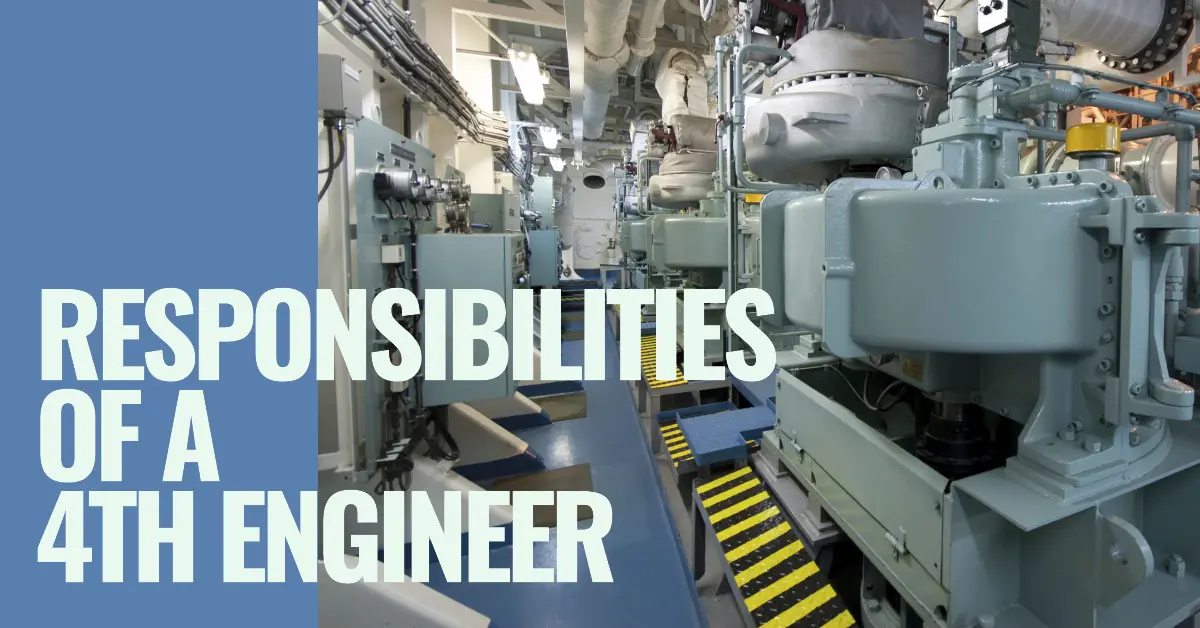
Responsibilities of a Fourth Engineer on Cargo Ships
A Fourth Engineer on cargo ships oversees engine room operations, machinery maintenance, and ensures compliance with regulations like MARPOL.

The Quality Control Process in Marine Manufacturing
Companies in the marine manufacturing space must have tight and effective quality control processes. What steps should an effective quality control process include?
Types of Sailboats, Activities and Uses
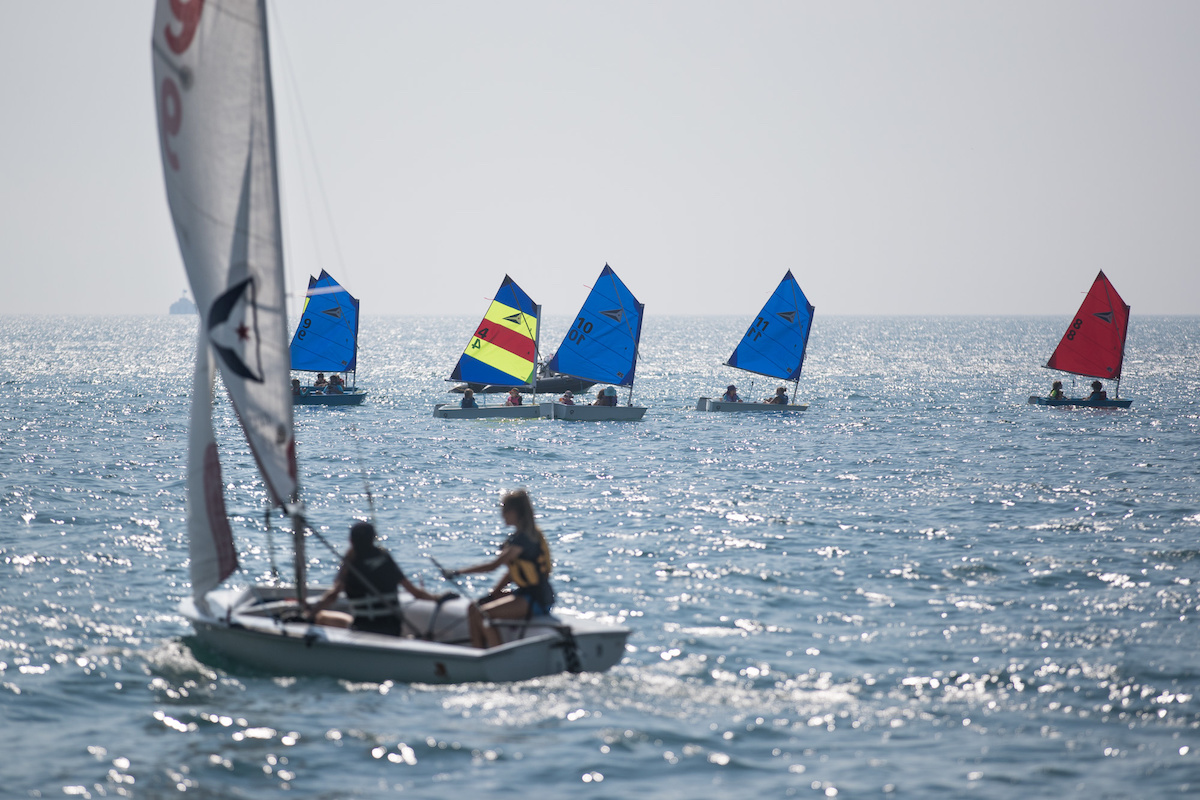
Sailboats may be boats with sails, but they’re not one homogenous category. Sailboat types differentiate by design and use, and even the type of culture that permeates each subgroup. Let’s divide sailboats by hull types, rig types and activities/uses.
Explore Sailboat Brands
Sailboat Hull Types
Sailboats ride on different hulls, which differ in the total number of hulls and their shape. The basic three hull types include:
- Monohulls (one hull)
- Catamarans (two hulls)
- Trimarans (three hulls)
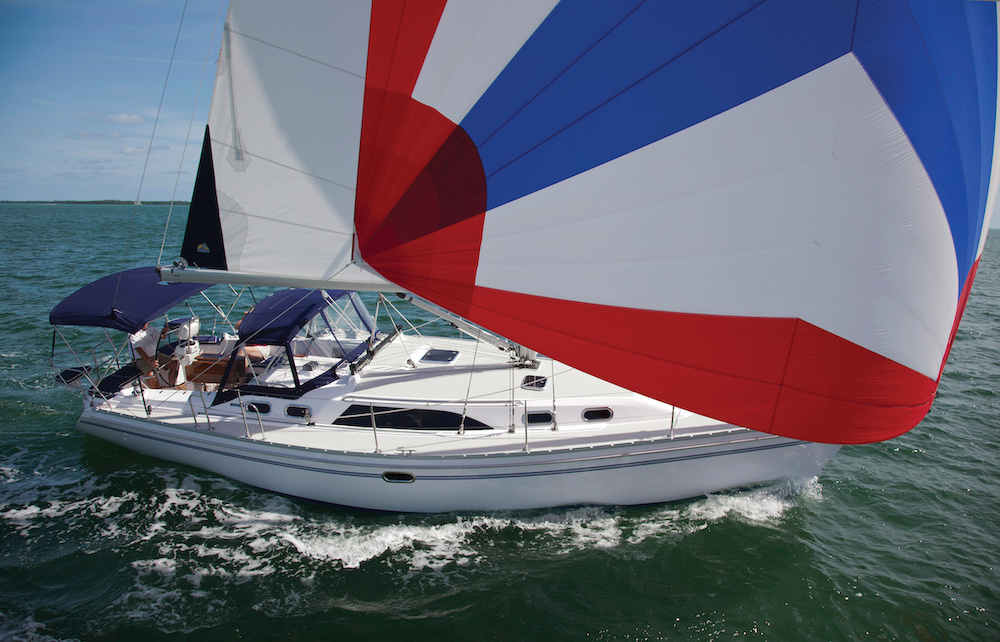
Monohulls have one hull but that doesn’t make them all the same. Traditional monohulls may have full keels (heavy encapsulated ballast that runs along the bottom of the hull), cutaway keels (similar to full but the forefoot is cutaway allowing the boat greater maneuverability in tight quarters) or bolted on fin keels that may have a bulb at the bottom for extra ballast to keep the vessel stable.
Monohulls can also have a swing keel, daggerboard or centerboard that retracts up into an appendage in the hull itself. With the keel or board up, the boat can enter shallow water and can travel faster downwind. With the keel down, the vessel tracks better upwind.
Small monohulls like sailing dinghies, may also have shallow planing hulls that can surf off a wave. Finally, monohulls can also foil on appendages (usually made of carbon fiber) with the actual hull out of the water when a minimum speed is reached.
Catamarans (often nicknamed "cats") have two hulls with a deck or trampoline in between. Large cats (35 feet and over) have become popular in charter use because they offer more interior and deck space and an easier motion to induce less seasickness. Small catamarans usually have just a trampoline in between the hulls and make fun daysailers.
Because catamarans don’t have deep and heavy keels, they tend to sail faster off the wind. Foiling catamarans were made popular by the America’s Cup races and are proliferating into general cruising use.
Trimarans have three hulls: a main hull and two amas (side hulls used for stability). On some trimarans, the arms that hold the amas can fold inward, making the trimaran narrower and in some cases trailerable. Large cruising trimaranas are gaining popularity because they are stable and fast sailers.
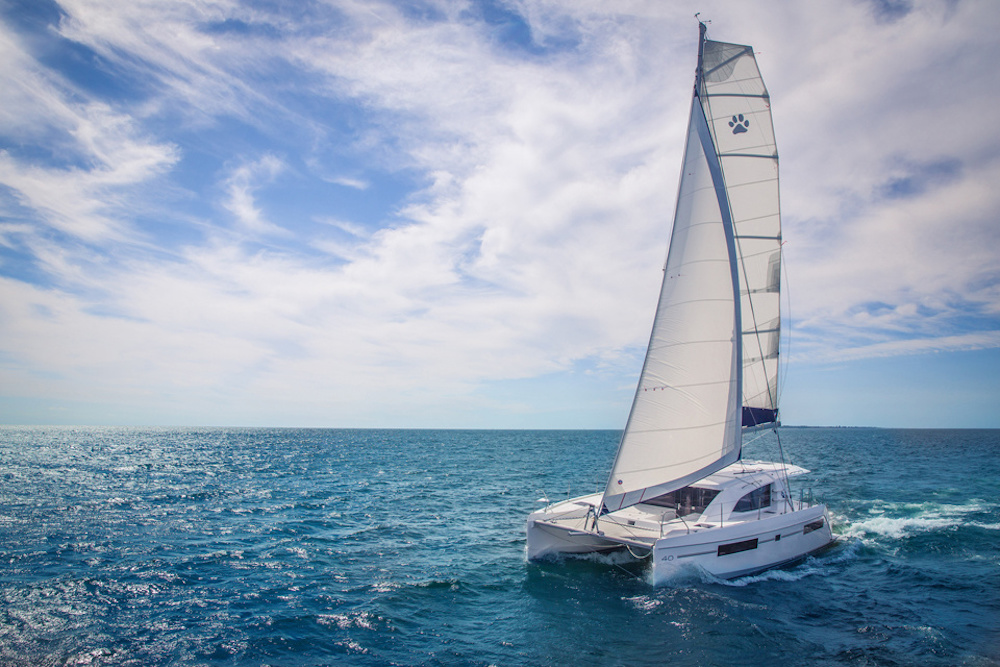
Sailboat Rig Types
Sailboat rigging includes:
- the mast(s);
- and the shrouds or stays that hold up the mast.
A sailboat with one mast is usually a sloop with one mainsail and one headsail.
A cutter rig usually has one mast but two or more headsails. This rig “cuts” the foretriangle between the head (forward) stay and the main mast. Multiple headsails allow for flexible sail combinations in variable wind conditions.
Ketches and yawls have a secondary mast behind the main one. The ketch configuration places that mizzenmast behind the mainmast but ahead of the rudderpost while the yawl places it behind the post. The second mast is shorter than the main mast. Both of these designs (split rigs) provide more sail area that isn’t reliant solely on the height of the mainmast and therefore can be easier to manage when sailing shorthanded.
Schooners also have multiple masts—two or more. However, the foremost mast is shorter than the main mast. Tall ship rigging is in its own category and can get quite complex.
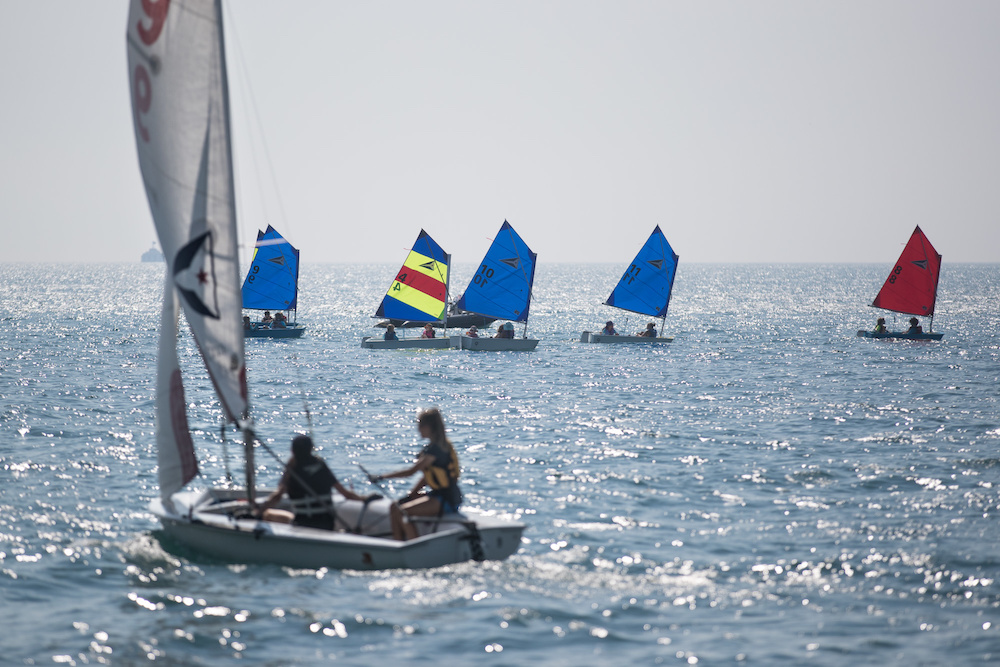
Sailboat Types by Primary Use
You can do many of the same things on all sailboats, but some types are more specialized.
Sailing dinghies: Small boats usually sailed by one or two people, sailing dinghies are often used to teach new sailors. That said, experts on high tech sailing dinghies compete in athletic racing up to Olympic level.
Day cruisers: Although any sailboat can be cruised for a day, day cruisers are often boats shorter than 30 feet that are designed to be sailed for an afternoon. They’re usually more Spartan in their outfitting and may or may not have a cabin with amenities.
Sailing cruisers: These sailboats can be monohulls or multihulls and are designed to cruise for weekends or longer. They usually have a berth (bed), a head (toilet) and a galley (kitchen). They can be sloop, cutter, ketch, yawl or schooner-rigged and vary in length (from 25-85 feet). Larger sailboats tend to fall into the crewed superyacht category.
Racing sailboats: Most offshore racers are larger boats crewed by multiple individuals while smaller racers can be single or double-handed. Racing boats are usually built lighter, have fin keels and laminate performance sails.
Racer/cruisers: These designs try to straddle the two above. They’re usually more lightly built cruisers with full amenities so they can be weekended. Some people will argue that these boats are a compromise for owners who want to primarily cruise but also race.
Bluewater cruising sailboats: These boats are designed to cross oceans or sail “blue waters.” They’re typically heavier in build with a stout rig and are fully equipped for extended offshore use.
Motorsailers: This term has fallen out of favor since it’s often pejorative. These sailboats may rely on the engine to sail in light wind conditions, especially due to their excessive weight.
Antique/classic sailboats: These are usually older restored vessels. They may be built of wood and have classic yawl rigs. These sailboats are often showcased in special events.
Sailboats occupy multiple segments and experienced sailors learn the finer points of design and use. Then, they never see two sailboats the same way again.
Read Next: Buying a Sailboat: Factors to Consider
You Might Also Like:
- Why Sailing?
- Learning the Basics of Sailing
- Sailing Basics: 10 Nautical and Sailing Terms to Know
- Explore Sailboat Brands & Manufacturers
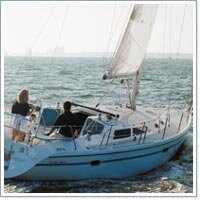
Join Our Newsletter!
Get community news, buying bargains, and how-to guides at your fingertips.
Sailboats Explained
Sailboats have many parts and esoteric names, but when you break it down, it isn't all that complicated. Here, we'll make it simple for you by doing just that.
Keel basics
All types explained, best keel for you, explore topics, sailboat types, sailboat parts.
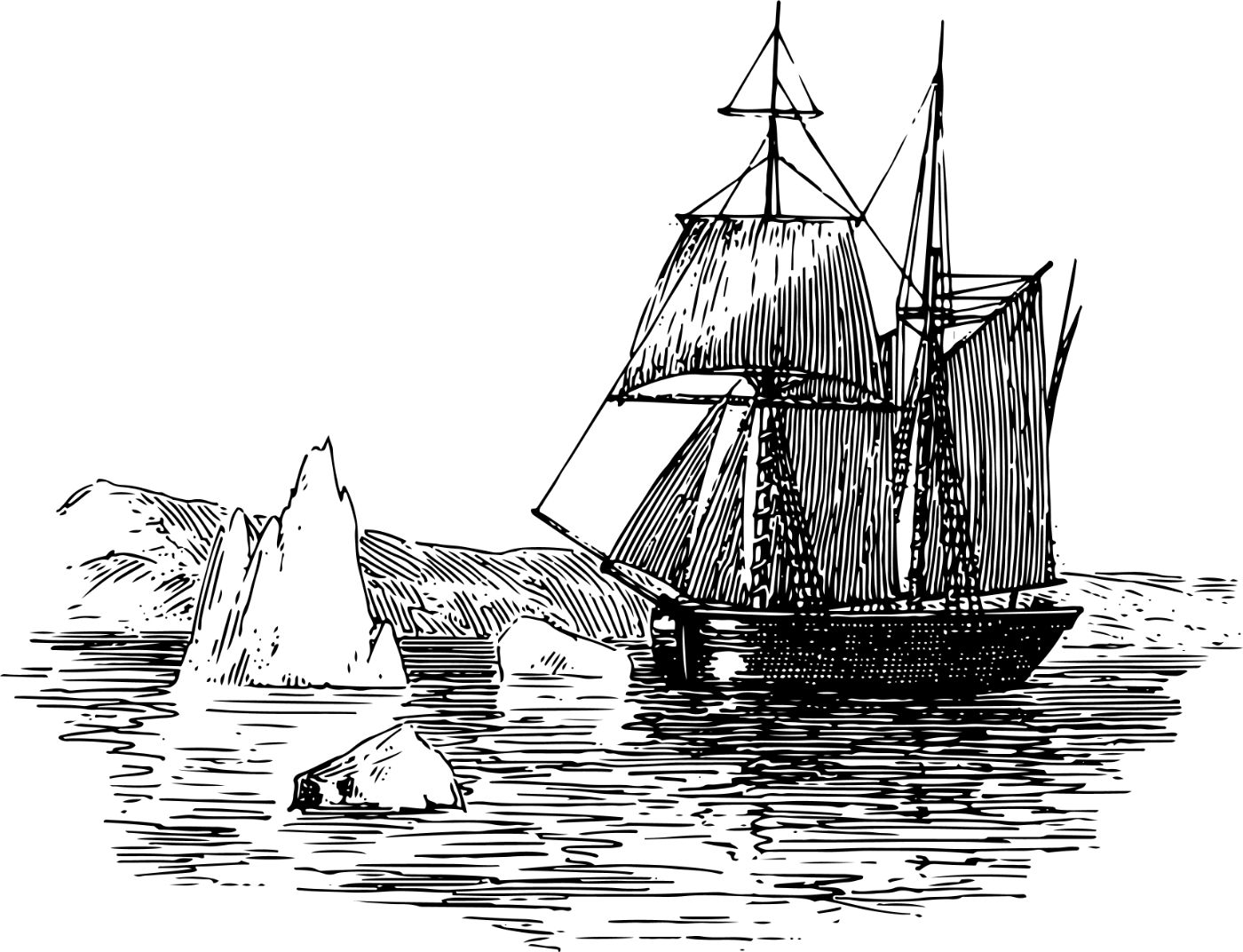
There are dozens of different sailboat types, all with different names and characteristics. Generally, a sailboat name refers to the sail plan, but not always. We've written a quick guide with real-world examples of 17 different sailboat types and how to recognize them to get you started.
More on sailboat types

What Are the Fastest Types of Sailboat (and Why)?
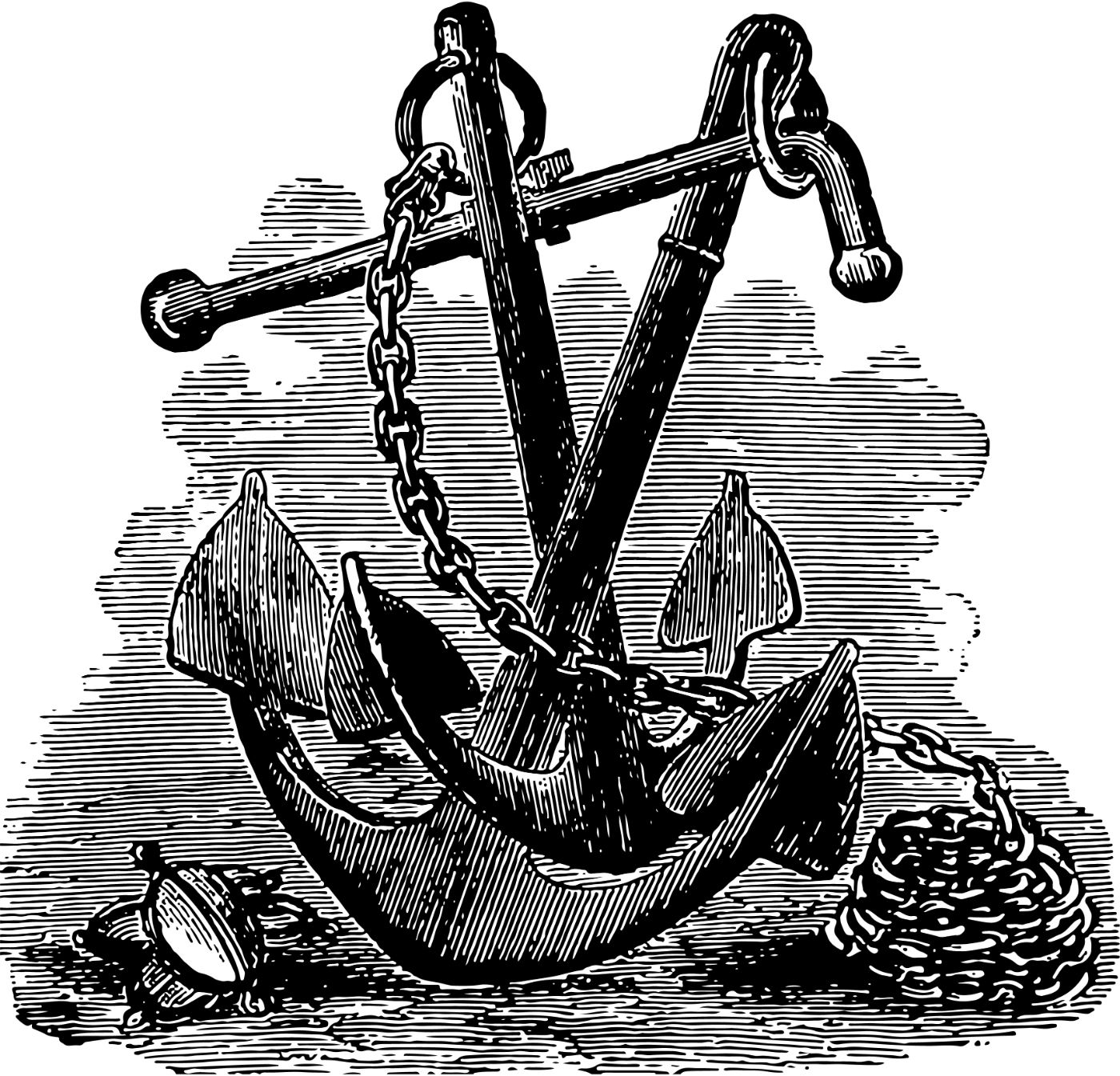
When you first get into sailing, there are a lot of sailboat parts to learn. Scouting for a good guide to all the parts, I couldn't find any, so I wrote one myself.
In this guide, I'll go over each different sailboat part. And I mean each and every one of them. I'll walk you through them one by one, and explain each part's function. I've also made sure to add good illustrations and clear diagrams.
Sailboats consist of four main segments
The hull is the sailboats' body, which is in contact with the water. The masts hold up the sails , while the rigging attaches the sails to the mast.
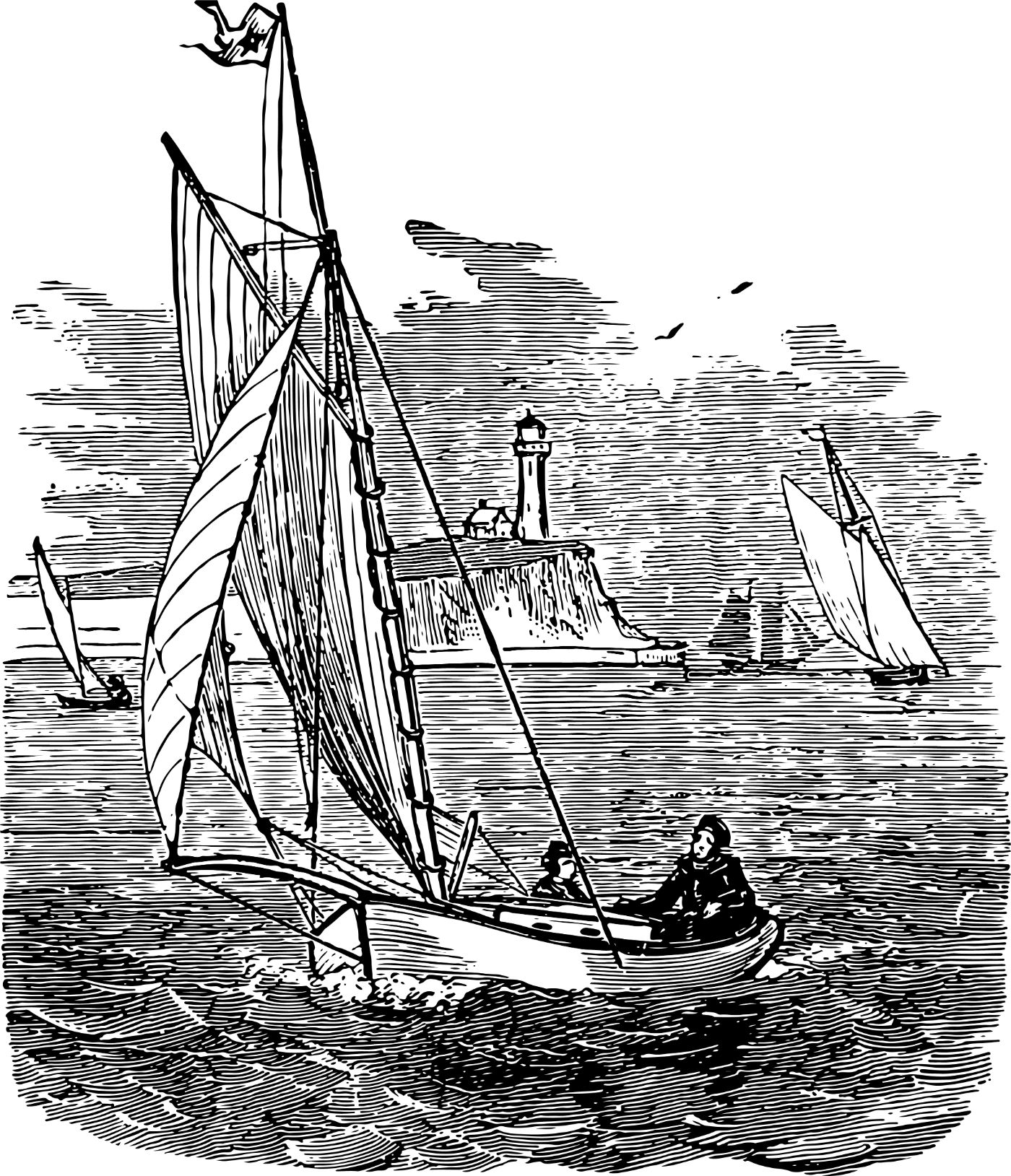
There's a lot to know about sailboat keels, how they function, the different types and their properties, and so on. That's why we've created this detailed cluster to walk you through everything there is to know about sailboat keels. It will link to all different articles on the topic and make it easy to find the exact information you're looking for.
More on keels
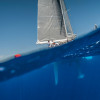
Sailboat Keel Types: Illustrated Guide (Bilge, Fin, Full)
What is a sailboat keel and how does it work.
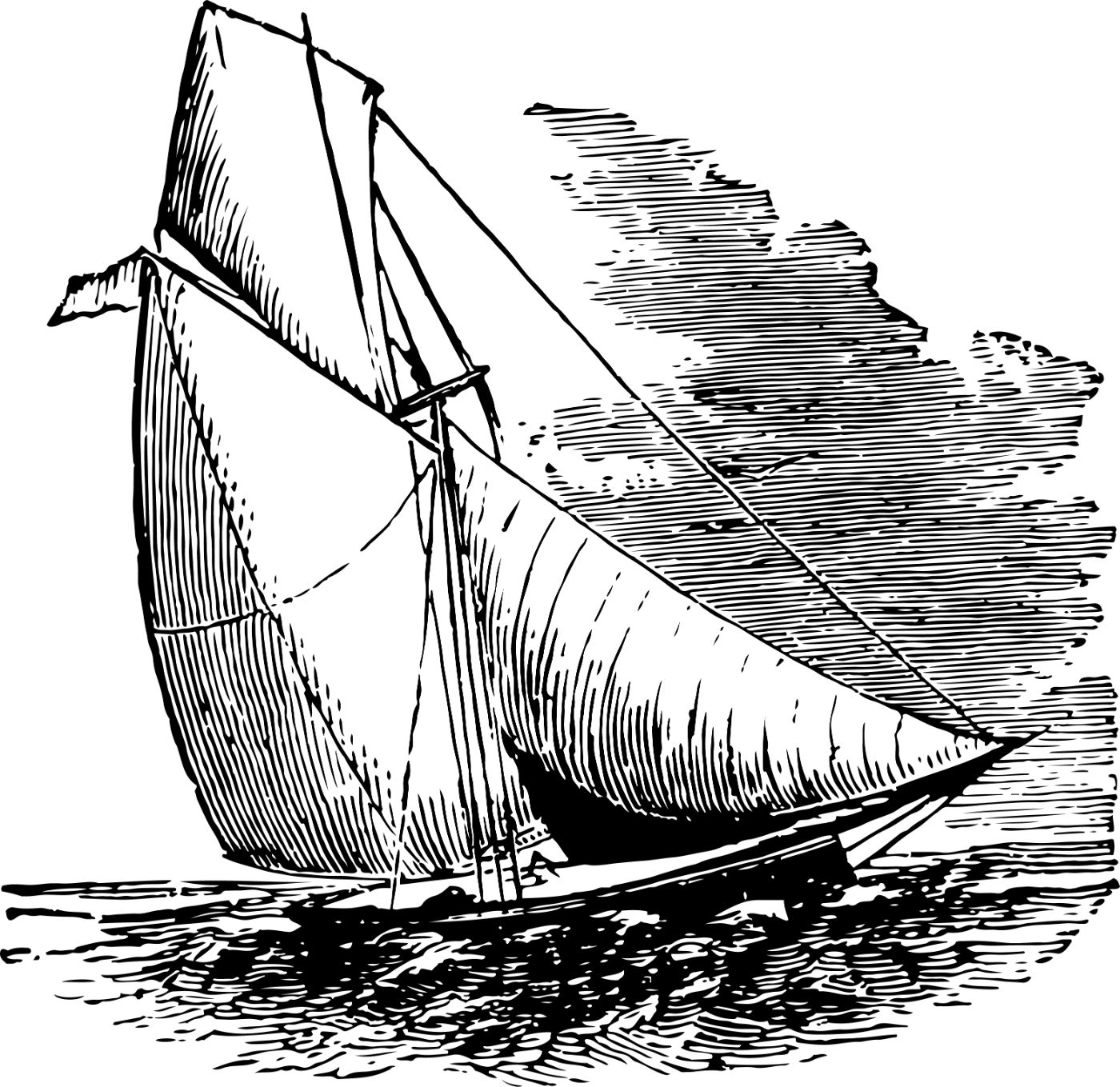
Different sail shapes and types are used for different purposes. There are sails for storms and high winds, as well as low wind conditions, like the spinnaker and gennaker. Recognizing the different sail types is the first step to mastering your sailboat's course, handling, and speed.
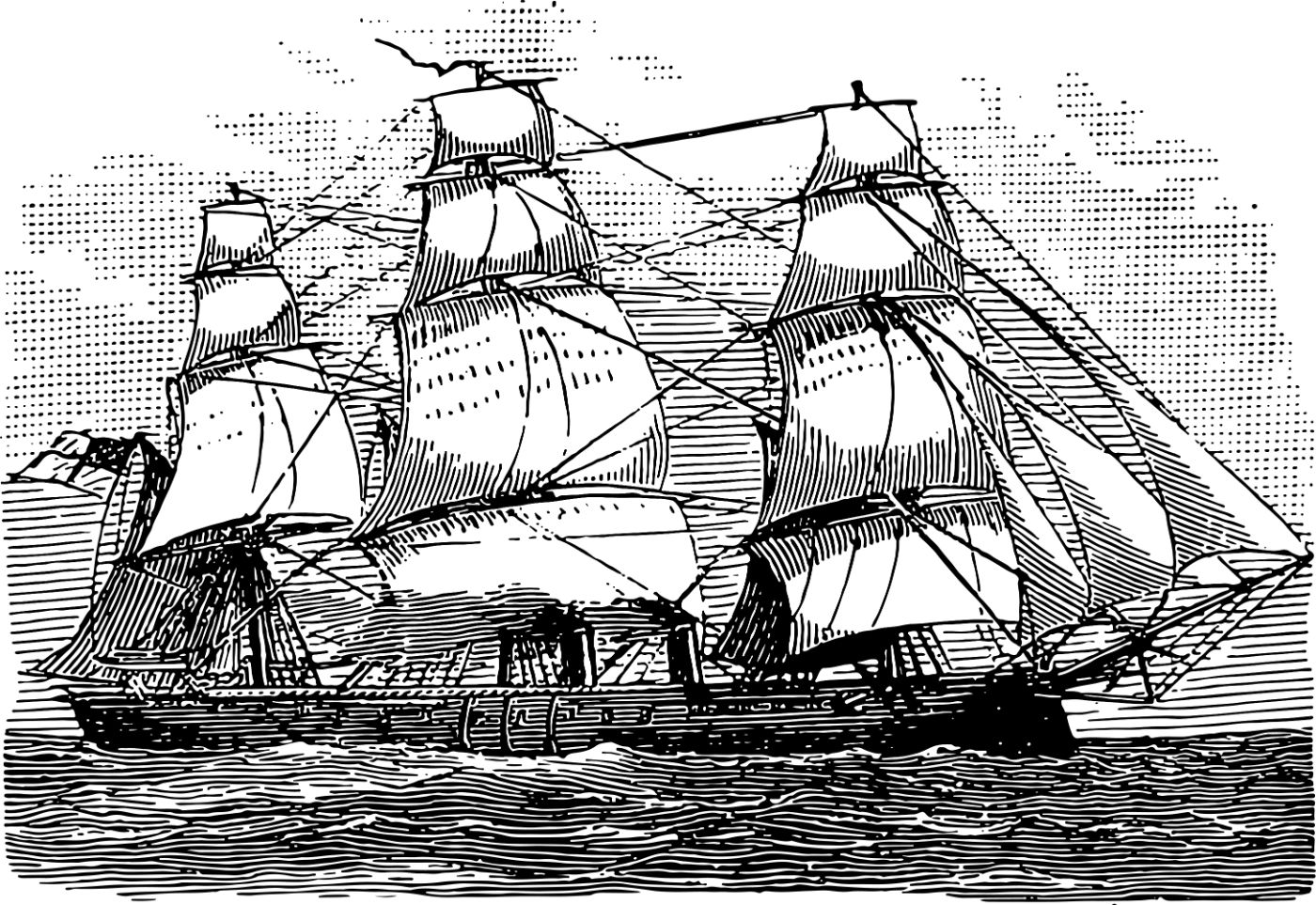
Closely related to sail types are rig types. Rigging is the way the sails are attached to the boat. This means that rigging envelops the mast layout, lines and halyards, and also influences the sails' shapes, and which types will be available to you. We've set out to create a single guide with good diagrams that will give you the complete overview in one read.
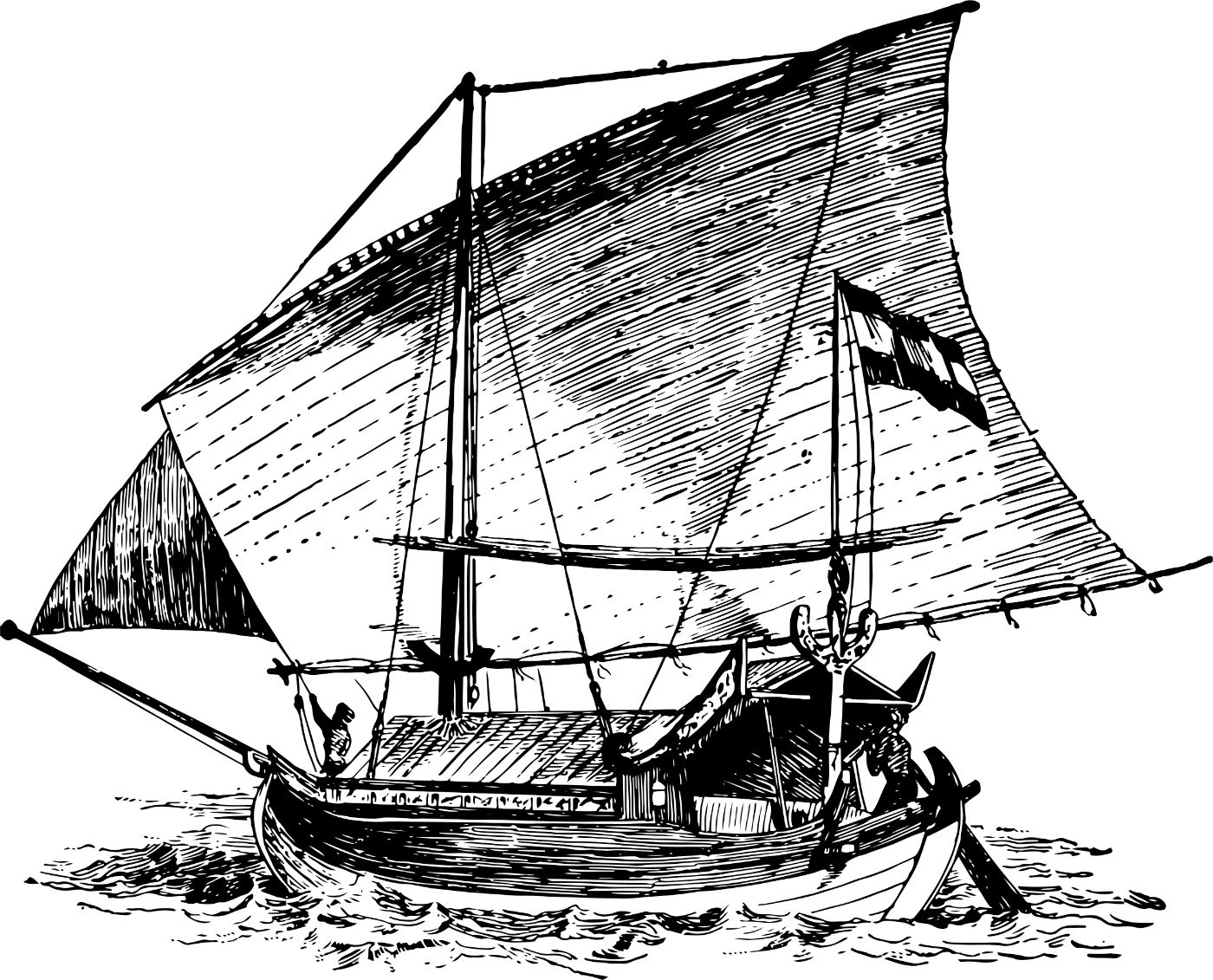
The hull is the body shape of the boat: the part that floats in or on top of the water surface and provides the boat's buoyancy. While most sailboats use the same hull design, there are many different types, all with different properties. The type of hull affects your boat's performance, handling, stability, and safety. We've created a comprehensive guide that will walk you through all the types, while giving examples of boats using each different hull design.
Latest about Sailboat types
Latest about keels, all sailboats explained articles.

What's the Steering Wheel On A Ship Called?
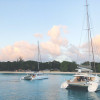
What's a Sailboat With Two Hulls Called? (3 Examples)

What Is A Boat With 2 Masts Called? (5 Options)
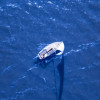
Can You Sail a 420 Single-Handed?
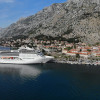
How To Figure Out How Shallow Your Boat Can Go
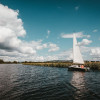
Small Sailboat Types: Choose the Perfect One For You

How Long Does It Take to Build a Sailboat? (DIY vs. Shipyard)

The Best Sailboats for Rough Sea Conditions (13 Examples)

What's the Best Size of Sailboat for Coastal Cruising?
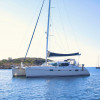
Can a Catamaran Capsize? The Surprising Answer
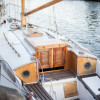
13 Best Beginner Sailboats with Cabin (For Any Budget)

Are Catamarans Safer than Monohulls? - Not Always
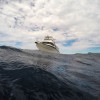
Catamaran vs Monohull in Rough Seas: Which is Better?

- Aug 14, 2023
A Breakdown of the Different Types of Sailboats and Their Uses
Updated: Jan 8
To the untrained eye, all sailboats are pretty much the same (some are just bigger than others). They’re essentially floating vessels with a mast, a set of sails, and the ability to navigate the waters by harnessing wind power. But if you dive a bit deeper, you’ll see there are drastic differences in the designs, capabilities, and uses of each type of sailboat.
Whether you’re new to sailboats or already an American Sailing Association (ASA) certified skipper, knowing the difference between the different types of vessels is essential. We’ll provide you with a basic understanding of the different types of sailboats, the advantages of each, and which type of voyage they’re best used for.
Sailboat Rigging Types
When you start sailing, one of the first things you’ll notice is how complicated the rigging seems. The rigging system includes ropes, furling jibs, booms, winches, cables, chains, masts, and much more. It takes time to identify and understand each one, but each type of sailboat has a distinct rigging system. A few of the main types of rigging you can expect to see on the water include:
Sloop: The sloop is arguably the most common rigging system. With one mast and two sails (mainsail & headsail), this type of rigging is simple, but efficient and prepared for all types of situations.
Cutter: If you squint, you could easily mistake a cutter for a slope, but there are slight differences. A cutter has a smaller headsail and an additional staysail between the mast and forestay of the vessel. The extra sail allows for more stability and control in heavy winds.
Ketch and Yawl: Both the ketch and yawl rigging types have two masts. However, what makes them different is in a ketch rigging, the aft mast (mizzen) is taller than the one on a yawl. Also, it’s positioned in front of the rudder post. These riggings are known for their excellent balance and flexibility in most conditions.
Schooner: If you have ever toured older wooden ships built to sail around the world and explore the ocean, then you have probably been aboard a Schooner. This configuration can have two or more masts and the aft mast is taller than the forward one(s). These vessels are powerful and equipped for the long haul.
Types of Sailboats and Their Uses
There are many types of sailboats (not to be confused with rigging types), each with its own pros, cons, and uses. Here’s a look at five of the most popular sailboats and why sailors use them.

When most people think of sailboats, they think of sailing dinghies. These small sailboats are less than 15-feet long and can be sailed by one person or a small crew. In most cases, they have small sloop rigs, are monohulls, and are excellent as a first sailboat. Dinghies are also great for racing or using as a lifeboat for bigger vessels.
Pros of a dinghy: Easily managed, relatively inexpensive, and great for beginners.
Cons of a dinghy: Not much space, only designed for short trips, and not recommended for rough waters or harsh weather conditions.

A daysailer is like the dinghy’s older brother. It’s usually about 14-20 feet in length and sloop-rigged. As the name suggests, they’re best for day trips on the ocean. In most cases, daysailers have a small cabin or open cockpit. They’re designed more for fun rather than long distances.
Pros of daysailers: Easy handling, stable, and great for outings with family or friends.
Cons of daysailers: Assmaller boats, they aren’t designed for overnight trips or long voyages.

The catamaran is where luxury on the sea begins. Its two parallel and equal-sized hulls make the vessel much more stable and comfortable than its single-hull counterparts. It’s a highly customizable boat that can be small and sporty or large and luxurious, depending on your needs.
More experienced sailors use these types of sailboats for longer trips and smaller charter trips .
Pros of the catamaran: A lot of space, fast, and perfect for cruising at sea.
Cons of the catamaran: Since they have such a wide beam, it can be a challenge to find places to dock or maneuver in tight marinas.

If you’re drawn to the size and stability of the catamaran, but yearn for more speed and power then you’ll love the trimaran. Instead of two hulls, this bigger boat has three: a main hull in the middle, and two smaller outrigger hulls on its sides. It’s an excellent sailboat for racing and cruising due to its stability and speed.
Pros of trimarans: Ability to be very fast, stable, and less likely to capsize in rough waters than smaller sailboats.
Cons of trimarans: They’re larger boats, so it can be difficult and more expensive to dock or store them in certain places.
Cruising Keelboat

Suppose you want to take an overnight cruise or even a trip across the Atlantic Ocean. In that case, a cruiser is your best bet. These large-sized sailboats (usually more than 30 feet long) are designed to be comfortable and self-sufficient, which makes them ideal for long voyages.
Pros of Cruising Keelboats: Well-suited to go on long-distance cruises for weeks or months with the ability to support multiple passengers.
Cons of Cruising Keelboats: You’ll not only have to invest in the sailboat (including storage and upkeep), but it also requires a large crew and an experienced captain.
Frequently Asked Questions (FAQs) About Sailboat Types
What is the most common type of sailboat.
Sloop-rigged sailboats (particularly daysailers and dinghies) are among the most popular types of sailboats. However, generally, the most commonly used sailboat depends on who’s using it. For example, a racer will have much different needs than someone who just wants the right boat for cruising.

What’s the difference between a sailboat and a yacht?
In the U.S., the determination between a sailboat and a yacht is that a sailboat only uses wind power, while a yacht can use wind, a motor, or a combination of both. However, internationally, sailboats and all other boats are usually considered “yachts.” Size can also be a determining factor. For example, some people consider any boat longer than 40 feet to be a yacht.
What’s the best beginner sailboat?
If you don’t have any sailing experience , the best sailboats are usually smaller, easy to maneuver, and less complicated than multihulls. Some of the best small sailboats for beginners have tiller steering and no winches.
This can include vessels like small dinghies, catamarans (though these are multihull boats), rotomolded boats, and those that can be easily trailered to different locations.
What is the safest type of sailboat?
In most cases, larger cruising keelboats are usually considered much safer than smaller dinghies and catamarans. That’s because they’re less likely to capsize and can handle adverse weather more safely, which is especially useful for new sailors. However, sailboat safety depends on the sailor, type of boat, and conditions.
What are the most popular sailboat brands?
There are countless high-quality sailboats on the market. Some of the most popular brands include Beneteau, Jeanneau, Hunter, Catalina, Dufour, Sunfish, Hobie, and many others. These brands have built a reputation of trust and reliability over the years, making them prime choices for new and seasoned sailors alike.
Which type of boat is best for offshore cruising?
If you want to take your sailboat for an offshore cruise, you’ll need something sturdy, reliable, and able to handle harsh sea conditions. In most cases, a cruising keelboat is your best bet for casual offshore cruising as they’re comfortable and self-sufficient vessels. In regards to rigging, ketch, cutter, and schooner rigs are best for sailing offshore because they are adaptable to varying wind speeds.
Learn How to Sail From The Experts
Are you interested in learning more about sailing or getting certified ? First Reef Sailing is one of the top ASA sailing schools in the Boston area.
We can help you learn the basics of sailing so you can get out on the water with confidence. Our certification courses, such as the beginner ASA 101 and ASA 103 courses, will teach you how to sail everything from 20-foot keelboats to 50-foot catamarans.
Take a look at this timeline of how many of our students learn, gain sailing experience, and go on to buy their own sailboats.
Recent Posts
ASA 103 Overview: What to Expect From Basic Coastal Cruising
Acting Fast: What to Do if Someone Falls Overboard
(Article) Tenant Spotlight: First Reef Sailing
Take a look at a quick spotlight about the origins of First Reef Sailing, written by our friends at the Boston Harbor Shipyard and...
Comentarios

U.S Navy Commissions USS New Jersey, First Ever Submarine For A Mixed Gender Crew

World’s Largest Hotel-Branded Superyacht Sets Sail For Maiden Voyage

India Establishes Its First Maritime Arbitration Center

Yanmar Unveils Its First Electric Propulsion Product For Emission-Free Sailing

Types of Sailboats – A Comprehensive Classification
Traditionally, sailboats were made of marine wood and other materials however; modern ones use premium marine lumber products. Sailboats are divided into subclasses, and one such is the catamaran which is made of fiberglass, which makes it more durable and low maintenance.
Sailboats are propelled by wind captured through their sails, masts and rigging lines. Some are equipped with generators, wind makers and other technologies to generate more power, hence providing more speed. They are considered a separate class of vessels independent of motor-powered crafts since their hydrodynamic characteristics differ.
They can vary in occupancy from single-seater crafts for competitions or adventure sailing to recreational vessels spanning hundreds of metres that can host up to thirty individuals. The luxury yachts are ideal to experience sailing in comfort and style. These vessels are known for their remarkable craftsmanship and innovative design.
The most common type of sailboat is the racing sailboat, used in sailing competitions around the world. Several international events intended to raise awareness about sailing allow a wide range of craft types to participate, including catamarans and racer-cruiser.
For most sailing vessels, sail plans are often drawn up before the vessel leaves port. These plans indicate sail positions for various weather conditions.
In this article, we will go through the different types of sailboats and their key features.
Hull-Based Classification Of Sailboats
Sailboats can be classified into three distinct types based on their primary hull type.
These include
- catamarans, and
- multi-hull crafts.
Traditionally, monohulls are the most common design for sailboats since they provide storage in addition to a certain level of stability.
However, with the advent of sailing competitions and an increased focus on performance and stability features, there has been a general shift towards catamarans and trimarans.
Monohulls are single-hulled structures, much like conventional vessels , that have a large hull beam (breadth) which provides stability while sailing. The advantage of having a single large hull is that the longer beam allows for improved onboard systems and amenities. It has a cabin, a cockpit, a galley, a v-berth and a saloon as well.
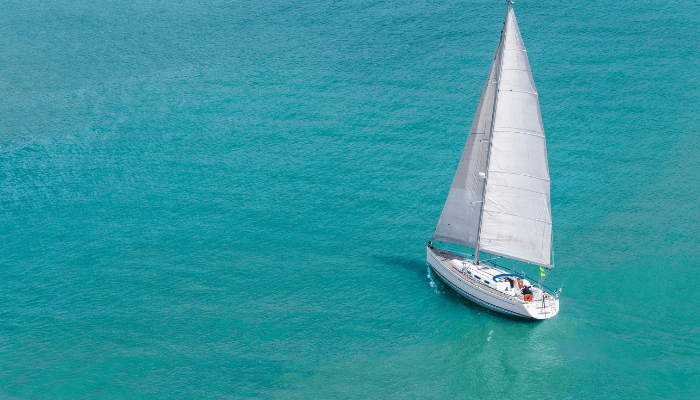
Catamarans refer to twin-hulled structures that are attached by specialized members to provide strength. The term originates from the South Indian phrase for “tied pieces of wood”, as this was the manner in which traditional sailboats were built in the subcontinent.
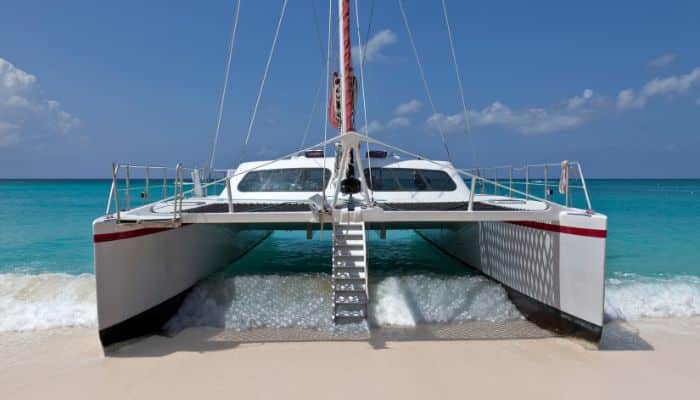
Twin hulls offer an increased level of stability. In addition, if designed properly the vessel will have a much higher speed than conventional crafts owing to lower wetted-surface resistance forces.
On the other hand, extensive care must be taken in designing the vessel, or else the resistive forces can exceed the values found in monohulls.
Multi-hull crafts, or simply multihulls, include vessels with anywhere between three to five hulls, although the three-hull variation is the most common. Such crafts are known as trimarans and are considered to be extremely stable owing to their large beam and lower centre of gravity.
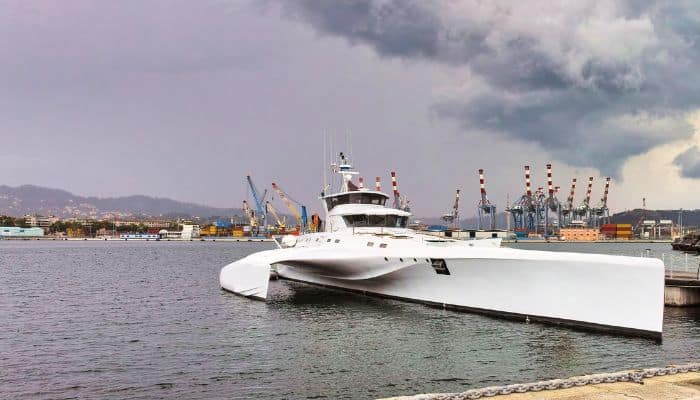
Four and five-hulled vessels are more difficult to manufacture and hence are rarely used commercially. An advanced form of the catamaran design is the SWATH version.
SWATH is an acronym for Small Waterplane Area Twin Hull, and it achieves unprecedented levels of speed owing to a considerably small waterplane area. To reduce this area, the hull has a reduced beam above the surface of the water, while underwater buoyant structures ensure that the vessel has the necessary weight balance.
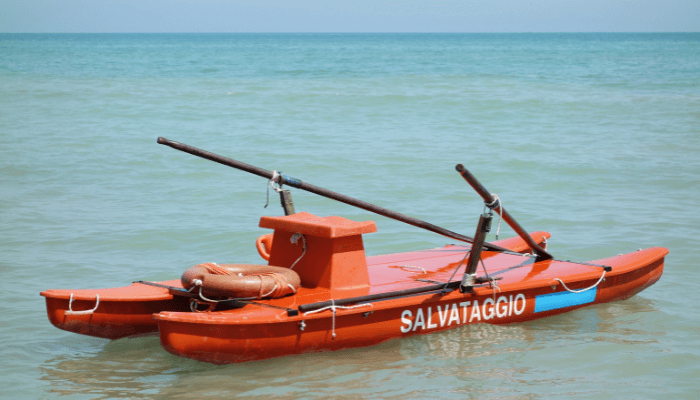
Common Monohull Designs
Monohulls are relatively easier to manufacture compared to multi-hull structures. Thus, there has been a wider range of innovations for this type of hull over the last thousand years.
The common classes of monohull crafts are – sailing dinghies, cutters, sloops, catboats, ketch and schooners.
A dinghy is a relatively common sailboat owing to its short overall length and ease of manoeuvring. They are used in competitions and in the port industry.
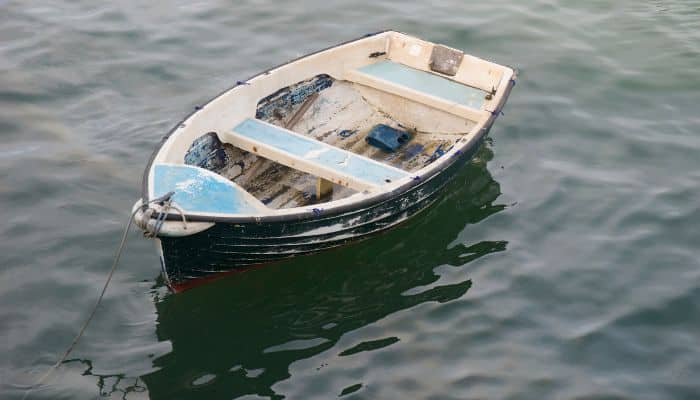
Generally, dinghies are used to transport people or small cargo to and from a larger vessel such as a cruise ship that is anchored away from the shore.
Such vessels may not be able to enter a port due to size and tonnage regulations. Hence, dinghies serve as the best mode of transporting essential goods between the port and the vessel.
Dinghies can have sails, such as the three-sailed variant consisting of the mainsail, jib and spinnaker. However, motor-powered dinghies are also commonly used especially as lifeboats onboard ships.
Cutters are another class of sailboats that are medium-sized and generally have three sails. The mainmast on which the sails are mounted is located near the stern of the ship to allow for larger sails to be used.
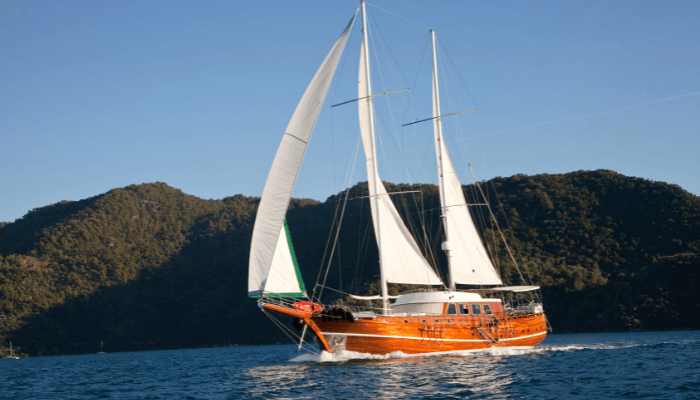
Cutters were commonly used in competitions as their design favours speed and agility. A different combination of the sails also allows cutters to be used for cruises and other recreational sailboats.
Sloops are similar to cutters and are the most commonly found sailboats. They are the standard in sail designs, with a two-sail configuration used for added manoeuvrability. They have a mainsail and a headsail called jib or genoa.
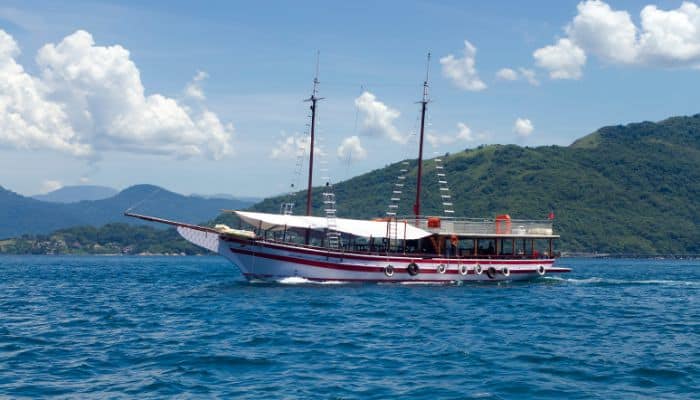
In addition to the generic sloop sail configuration, there is also a fractionally-rigged sloop in which one of the sails lies below the top of the mast.
This design allows the crews of smaller sloops to handle the craft while improving performance. Catboats are sailboats equipped with only a single sail. They are aimed at capacity rather than speed and have the mainsail mounted on a single mast.
For increased speeds, sails can be added to the rigging such that wind force is better optimized by the vessel.
The ketch is a sailboat that has two main masts- the main mast located around the midship, and the mizzen mast at the aft. The mizzen mast is generally smaller than the main mast and serves to add speed to the craft. The word ketch is derived from the word catch, denoting the manner in which the sails “catch” the wind as they move.
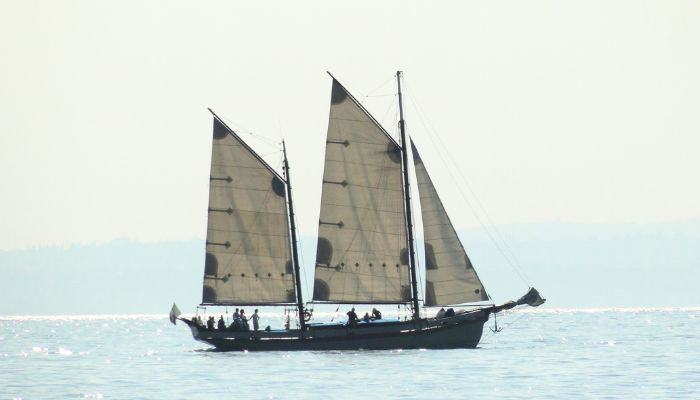
Schooners are a class of sailboats that can have more than two sails supported on masts known as the main mast and foremast. The foremast is located near the fore of the vessel and is slightly shorter than the main mast. In variations where additional masts are added to support more sails, they are positioned such that they remain shorter than the main mast depending on their sizes.
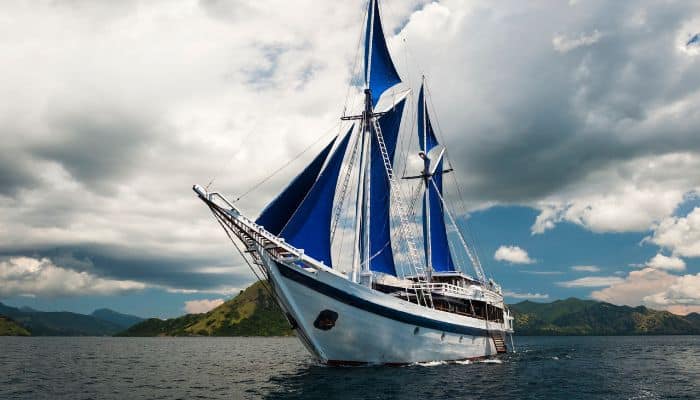
Keel Based Classification
The keel is the base of a vessel that provides a central backbone for the design of the entire structure. The boat keel is structurally relevant since it often has to carry the weight of the vessel.
In the case of sailboats, the keel is often what the entire craft rests on during transport by road or rail. Thus, keels need to have integral strength and be able to withstand a variety of forces.
Similarly, while sailing, the keel is the lowermost point of the vessel at which resistive forces act. As a result, many modifications are often made to the keel so that hydrodynamic features can be incorporated to reduce drag. Sailboats often sit high in the water owing to their design and shape.
However, for competition and performance crafts, it is essential that they try to sit as close to the surface of the water as possible without capsizing. Thus, the keel often plays the role of a central ballast, by integrating heavy iron or steel components so that the vessel draft increases.
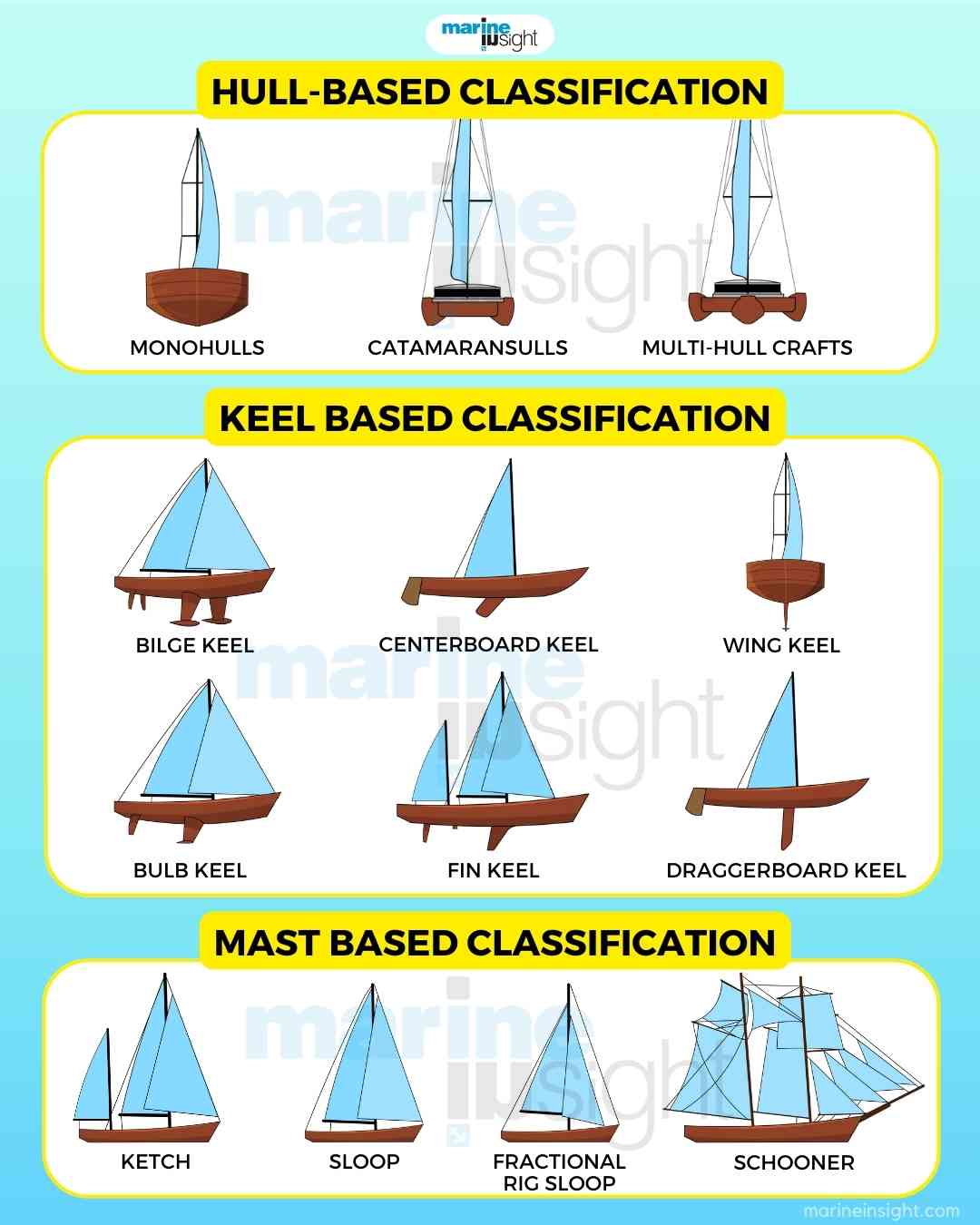
Based on keel type, there are several sailing boat variants found in the market. These generally have modified keels for improving performance and speed by integrating hydrodynamic features such as hydrofoils .
The types of keels commonly associated with sailboats are as follows: full-length keel, fin keel, centreboard keel, bilge keel, bulb keel and wing keel.
As the name suggests, full-length keels have keels that extend in the form of a long fin below the main structure of the ship. The fin runs along the length of the ship and often has an integrated rudder system attached at the stern.
The advantage of this type of keel is that it is easy to manufacture, with little cost in terms of development. Also, the ballast effect is provided by the extra weight of the full-length keel.
Since it can be difficult to enter certain ports or quays owing to the large draft that comes with this type of keel, manufacturers attempt to reduce fin depth and instead increase its length.
Fin keels , on the other hand, run only along certain regions of the sailboat. Located on the underside of the craft, it sticks out similar to the fin of a fish giving rise to this nomenclature. Since this type of keel must perform the same functions as the full-length keel without having a large length, the fin is deeper.
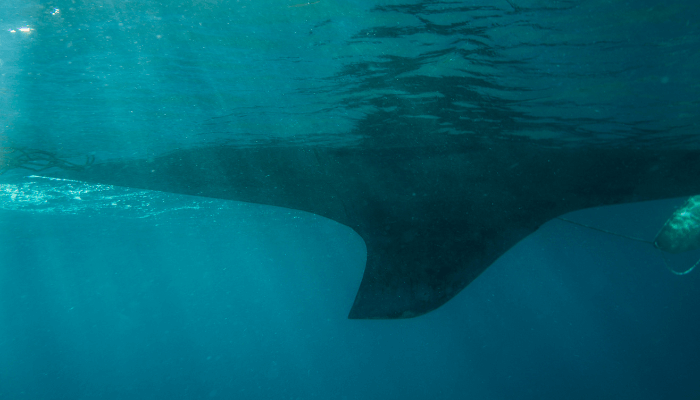
Owing to this large draft, it may be difficult to dock at certain ports due to depth restrictions. A key feature of this type of keel is that the rudder and manoeuvring systems remain independent of the fin keel, and are located at the extreme aft of the vessel. Centreboard keels are a common feature of high-performance crafts that take part in competitions. They are not restricted to monohull structures and are often found in catamarans and trimarans.
The centreboard keel employs a type of fin that is pivoted about a point on the keel of the vessel. By having a pivot, the natural flow of the vessel and surrounding water varies the depth at which the keel sits below the vessel. Similar to the fin keel, it only runs along a certain length of the vessel.
However, it is distinguished by being able to vary the angle of tilt with respect to the baseline of the craft. In some variations, the crew are able to manually change the angle of tilt, to change performance features during certain events and competitions.
Another variation of the centreboard keel is the daggerboard keel , which allows the fin to completely integrate into the underside of the vessel.
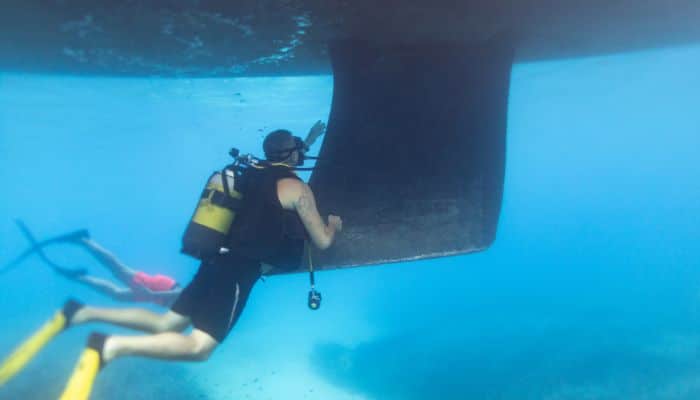
By providing a bay at the underside, the fin can be raised or lowered from the slot. In this type of keel, the raised configuration allows for higher speeds and reduced resistive forces. However, when lowered into the water, the vessel gains added stability and makes up for the loss in speed by improving hydrodynamic features.
Bilge keels refer to protrusions on the sides of the hull of the vessel, commonly called the bilges. These protrusions run along the length of the vessel while tapering into the hull panels at both ends.
The primary purpose of bilge keels is to improve the rolling stability of the craft. The fins stick out perpendicular to the hull and can vary in length depending on the purpose. For instance, sailboats require larger anti-roll stability and hence have long tapering bilge keels.
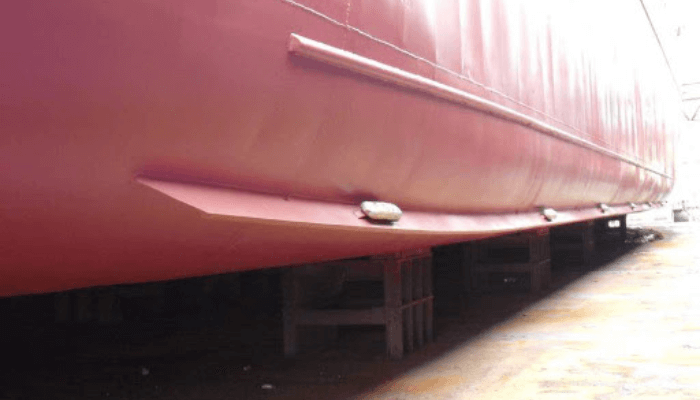
The bilge keels must be symmetrically placed on both the port and starboard sides, so as to ensure even hydrodynamic characters.
A bulb keel is a protrusion sticking vertically below the craft and terminating in an oblong-shaped hydrodynamic device called the bulb. The bulb acts as a 3D hydrofoil that improves the stability and handling of the vessel. Due to the increased wetted surface area, there is a slight drop in the speed, but it can be made up through superior handling capabilities.
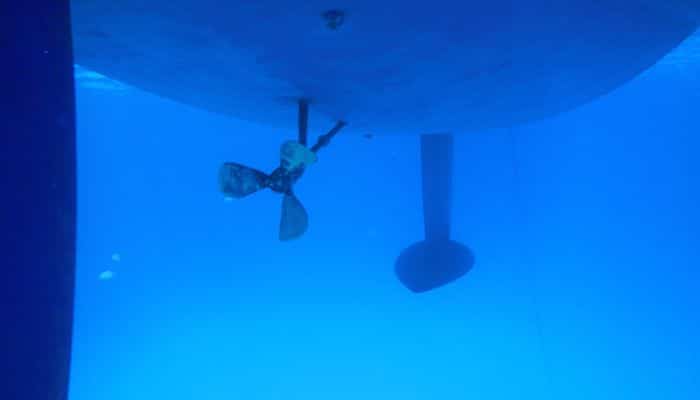
For smaller crafts, longer bulb keels are required, and as this length increases, the chance of accidental grounding of the vessel increases.
The last commonly found type of keel is the wing keel . The wing keel is similar to the bulb keel, except that instead of a bulb terminating a vertical protrusion, there are horizontal hydrofoils extending from the central shaft.
The primary purpose of the wings underneath the ship is to improve handling and stability. In addition, they slightly lift the craft above the surface of the water. As a result, the total wetted surface area remains constant and may even decrease. Thus, speed remains constant and may improve as the craft picks up velocity.
Mast Based Classifications
The mast of the vessel refers to a vertical shaft extending out of the deck which supports the sails and rigging. Older models of sailboats and ancient ships had masts constructed out of wood, while modern speed-oriented versions use galvanized steel or aluminium.
Aluminium has the benefit of being extremely light while still retaining its strength, which is important during harsh weather conditions.
The various mast-based classification includes – sloop, fractional-rig sloop, cutter, ketch, schooner and catboat.
The sloop is the most common mast type, where a single mast supports two sails called the headsail (or foresail) and the mainsail.
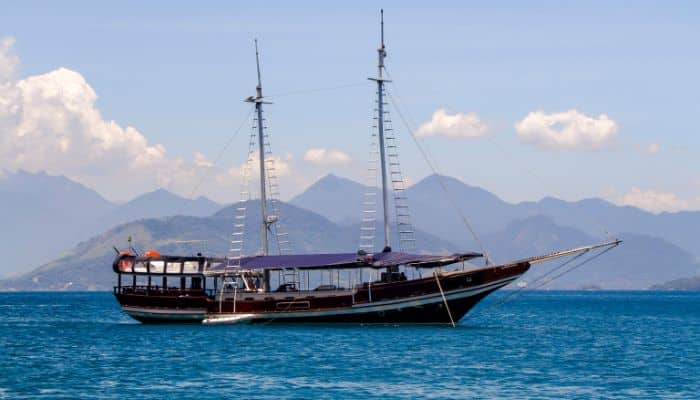
The headsail also goes by different names depending on the purpose and configuration of the sails.
In a fractional rig sloop , the forestay cable that is used to hoist the headsail is actually placed below the top of the mast. This configuration is particularly useful when it comes to performance, as the tip of the mast can be hauled towards the aft using stiff cables, and the sails can be collapsed.
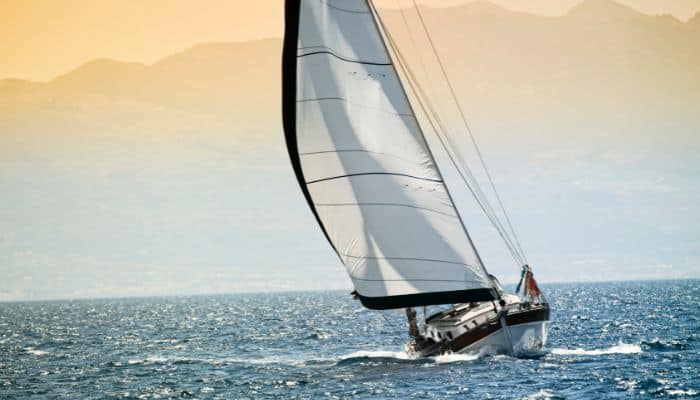
This is useful on days when wind power can be used to propel the sailboat, without the sails having to be fully extended.
Another useful feature of being able to trim or flatten the sails is that during particularly strong squalls of wind, the sails will not be punctured or ruptured due to the high wind pressure. The next type of mast configuration is the cutter. This involves a single mast supporting three sails- one mainsail, and two headsails known as the staysail hauled by the inner stay cable, and the jib hauled by the headstay cable.
The mast is located more towards the aft compared to the sloop, to allow for an easily manoeuvrable configuration. In addition, a wide range of sail arrangements makes it favourable for cruise operators and for competition purposes.
The ketc h has a two-mast configuration, with the aft mast known as the mizzen mast. The mizzen mast is located fore of the rudder post, and aft of the main mast.
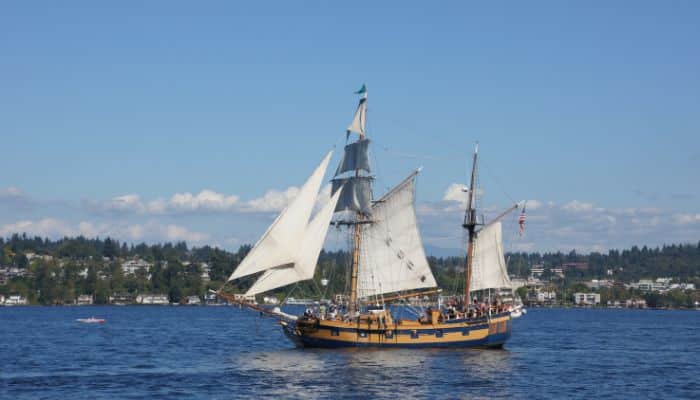
The mizzen sail rests on the mizzen mast. In general, the mizzen mast is slightly shorter than the main mast.
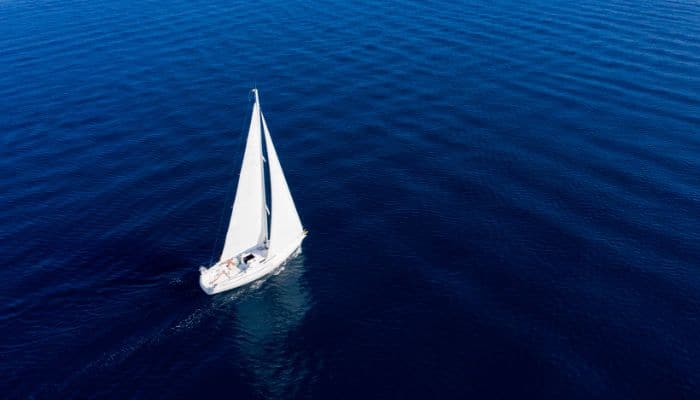
The main mast supports two sails known as the mainsail and the headsail.
The schooner is another configuration similar to the ketch, but where the aft mast is taller than the foremast.

Schooners can have multiple masts and are not restricted to commercial small and medium sailboats. The images of ancient ships that were used for trade and military purposes were often schooners having between four to six masts with an average of over ten sails each.
In addition, the sails of the schooner tend to lie along the length of the vessel, rather than along the beam. This is to prevent sail rupture during violent storms or during heavy winds. The catboat is one of the simplest configurations where only a single sail and mast arrangement are used.
The mast can be located either aft or fore of midships, with varying advantages to each configuration. The ease of design and construction makes it a favourable sailboat for beginners and trainees. However, the disadvantage behind the catboat is that the sail cannot be used to move against the direction of the wind, unlike other sail variations.
Apart from recreation purposes, sailboats are one of the most common types of vessels used in recreational purposes and competitions. They can vary in the hull, keel and sail configurations based on the primary purpose that they are intended to be used for.
For over five thousand years, sailboats have been in use, whether it has been for transportation in Ancient Egypt, or for sailing events in modern times. Technological advancements have turned the sailboat into a sleek, agile and fast vessel capable of reaching extremely high speeds by harnessing the power of the wind.
Whether it be for cruises or for racing events, sailboats and other such crafts continue to be a favourite choice for sailors.
Frequently Asked Questions About Sailboats
1. how many different kinds of sailboats are there.
There are many types based on their hull type- monohulls, catamarans and trimarans; keel type- fin keel, wing keel, daggerboard, centreboard; mast configuration and sails- sloop, fractional rig sloop, schooner, ketch, yawl, cutters and catch.
2. What is the most common type of sailboat?
The sloop is the most common sailboat. It has a mast, two sails, commonly a Bermuda rigged main and a headsail. They include a gaff rig, a mix of gaff and square rig or a Bermuda rig.
3. What is a four-masted sailboat called?
It is called a schooner. Traditional schooners have a gaff-rig, which means that they have a square topsail on the front of the mast. They were mainly constructed for carrying cargo, passengers and for fishing.
4. How many masts does a ketch have?
Ketch has two masts whose main mast is taller than the mizzen mast. It is similar to a yawl and has a triangular mizzen sail and a triangular or square headsail. Due to their smaller sails, they are easily manageable and preferred by sailors.
5. What is the most beautiful sailboat?
Some of the most beautiful sailboats in the world include Pelagic Australis, Thomas W Lawson, Royal Clipper, Barque Sedov and Amerigo Vespucci.
6. What are some popular sailboat brands?
Beneteau, Sparkman and Stephens, Oyster Yachts, Amel Yachts and Nautor’s Swan are some popular sailboat brands that sell the most number of sailboats yearly.
You Might also like to read
- Real Life Accident: Officer Of The Watch Ignores Lookout’s Warning, Ship Collides with Sailboat
- Introduction To Different Types Of Yachts
- 12 Sailing Books For Beginners
- The Ultimate Guide to Different Types of Boats – Top 20
- Main Types of Catamarans Used in the Shipping World
- What are Tug Boats – Types And Uses
Disclaimer : The information contained in this website is for general information purposes only. While we endeavour to keep the information up to date and correct, we make no representations or warranties of any kind, express or implied, about the completeness, accuracy, reliability, suitability or availability with respect to the website or the information, products, services, or related graphics contained on the website for any purpose. Any reliance you place on such information is therefore strictly at your own risk.
In no event will we be liable for any loss or damage including without limitation, indirect or consequential loss or damage, or any loss or damage whatsoever arising from loss of data or profits arising out of, or in connection with, the use of this website.

About Author
Ajay Menon is a graduate of the Indian Institute of Technology, Kharagpur, with an integrated major in Ocean Engineering and Naval Architecture. Besides writing, he balances chess and works out tunes on his keyboard during his free time.
Read More Articles By This Author >

Do you have info to share with us ? Suggest a correction
Daily Maritime News, Straight To Your Inbox
Sign Up To Get Daily Newsletters
Join over 60k+ people who read our daily newsletters
By subscribing, you agree to our Privacy Policy and may receive occasional deal communications; you can unsubscribe anytime.

BE THE FIRST TO COMMENT
Leave a reply.
Your email address will not be published. Required fields are marked *
Subscribe to Marine Insight Daily Newsletter
" * " indicates required fields
Marine Engineering
Marine Engine Air Compressor Marine Boiler Oily Water Separator Marine Electrical Ship Generator Ship Stabilizer
Nautical Science
Mooring Bridge Watchkeeping Ship Manoeuvring Nautical Charts Anchoring Nautical Equipment Shipboard Guidelines
Explore
Free Maritime eBooks Premium Maritime eBooks Marine Safety Financial Planning Marine Careers Maritime Law Ship Dry Dock
Shipping News Maritime Reports Videos Maritime Piracy Offshore Safety Of Life At Sea (SOLAS) MARPOL
WAIT! Did You Download 13 FREE Maritime eBooks?
Sign-up and download instantly!
We respect your privacy and take protecting it very seriously. No spam!
- Privacy Policy
Types of Sailboats: Know By Classification and Intended Use
- June 10, 2024
Embarking on the open waters is an exhilarating experience, and choosing the right sailboat can make all the difference. The world of sailboats is as vast as the oceans they navigate, offering a myriad of options tailored to various needs and preferences.
From sleek racing yachts that cut through waves like arrows to comfortable cruisers designed for leisurely journeys, the spectrum is vast and exciting. Understanding the different types of sailboats before making a decision is like finding the perfect wind for your sails – it ensures a smoother and more enjoyable ride.
Delving into the fascinating realm of sailboat varieties not only broadens your nautical knowledge but also helps you pinpoint the vessel that aligns seamlessly with your sailing ambitions. Whether you dream of competing in regattas, embarking on leisurely coastal cruises, or undertaking adventurous bluewater voyages, knowing your sailboat types is the compass that guides you towards maritime fulfillment.
So, join us as we unfurl the sails of discovery and explore the captivating universe of sailboat diversity. Ready to set sail? Let’s embark on this exciting voyage of exploration!
- 1 Thrill of Sailing in Sailboats
- 2.1 Monohulls
- 2.2 Catamarans
- 2.3 Trimarans
- 2.4 Sloops
- 2.5 Ketches
- 2.6 Schooners
- 3.1 Daysailers
- 3.2 Cruising Sailboats
- 3.3 Racing Sailboats
- 3.4 Performance Cruisers
- 3.5 Other Specialized Sailboats
- 4.1 Keel Configurations
- 4.2 Size & Capacity
- 4.3 Sailing Experience
- 5 Choosing Your Right Sailboat
- 6 Conclusion
Thrill of Sailing in Sailboats
Who wouldn’t want to sail into the captivating world of sailboats. You have the wind in your hair, the salty breeze on your face, and the open sea stretching out endlessly before you. It’s not just a boat ride; it’s an exhilarating dance with the elements.
Sailing is all about freedom and joy, harnessing the power of the wind, charting your course, and feeling the thrill of the open water. Whether you’re a seasoned sailor or just dipping your toes into this nautical adventure, there’s something truly special about the unique appeal of sailing.
The freedom you experience on a sailboat is unparalleled. You’re not confined to roads or tracks; you’re guided by the wind, able to explore hidden coves, secluded islands, and distant horizons. It’s a sense of liberation that only sailing can provide.
Now, let’s dive into the different types of sailboats that populate the seas. Just like there are various species in the animal kingdom, the sailing world boasts an array of vessels, each with its own personality and purpose.
Sailboat Classifications
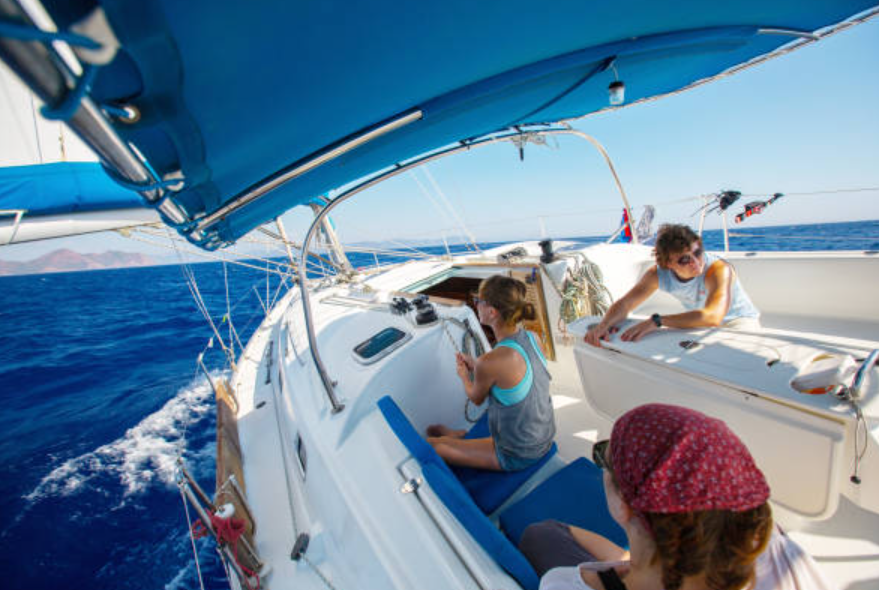
Ok, you want to set sail in your dreams, or maybe daydreamed about cruising crystal-clear waters on a sleek sailboat. Before you chart your course, you may want to explore the different types of sailboats and know its unique personalities and ideal uses.
By Hull Design
Monohulls
Think classic sailboats – these are the most common, offering stability and a variety of keel types. Imagine a deep keel slicing through waves, providing a smooth ride, or a shallow draft monohull skimming across shallow bays. These trusty vessels are the workhorses of the sea, offering stability that makes them a favorite among sailors. With various keel types to choose from, monohulls provide versatility for different sailing conditions. Whether you’re a seasoned sailor or just dipping your toes into the sailing world, monohulls are a reliable choice.
Catamarans
These boast two hulls, creating spacious decks and unmatched stability. Think luxurious floating apartments, perfect for island hopping or relaxing with friends. Catamarans are the spacious giants of the sea, offering a different kind of sailing experience. While they might be less maneuverable compared to monohulls, the extra room and stability make them perfect for leisurely cruises or entertaining your mates on board. Keep in mind, they’re not be as nimble as their single-hulled counterparts.
Trimarans
Craving speed and stability in rough waters? Trimarans have three hulls, slicing through waves effortlessly. They’re less common but perfect for adventurous sailors seeking exhilarating rides. Trimarans boast speed and stability, especially in choppy waters. Though less common, these three-hulled wonders are a sight to behold. If you’re seeking a vessel that can handle rough seas without sacrificing speed, a trimaran might just be your perfect match.
By Mast Configuration and Sails
The most popular choice, sloops have a single mast and are known for their simplicity and versatility. Whether you’re learning the ropes or racing across oceans, there’s a sloop rig for you. Simple, sleek, and ever-popular, the sloop is your go-to sailboat. With various rig types to suit your preference, it’s the ideal choice for those looking for an uncomplicated sailing experience.
Imagine two masts for double the sail area! Perfect for long-distance cruising, ketches handle winds well and offer generous storage space. Think self-sufficient adventures across distant horizons. Ketches provide more sail area for that long-distance adventure. With its two masts and ample sail configuration, it’s the go-to choice for sailors craving extended cruising. Imagine the wind in your sails as you gracefully navigate the open sea.
Schooners
See a classic scene with multiple masts rising majestically. Schooners, with their elegant design, perform particularly well in light winds and offer a unique sailing experience. Its timeless design shines, especially in light winds. If you fancy a nod to sailing’s rich history while enjoying a leisurely sail, the schooner is a top contender. Think historical charm meets modern comfort.
Beyond the basics: There’s a whole world of other mast configurations like catboats, yawls, and cutters, each with their own strengths and quirks. Explore further to find your perfect match!
Sailboats Types by Intended Use

Are you ready to set sail and navigate the open waters? Whether you’re a seasoned sailor or a novice eager to learn, understanding the different types of sailboats based on their intended use is a crucial first step. Let’s dive into the diverse world of sailboats and discover which one suits your sailing ambitions.
If you’re looking for a sailboat perfect for short excursions and skill-building, the daysailer is your go-to. Designed for ease of use, these boats are ideal for beginners and those who crave the simplicity of a quick day on the water. With straightforward rigging and a focus on maneuverability, daysailers make learning the ropes a breeze.
Cruising Sailboats
For the adventurers at heart, cruising sailboats are tailored for extended journeys and even living aboard. These boats offer a comfortable living space and ample storage, making them well-suited for those dreaming of exploring distant shores or embracing the liveaboard lifestyle. Set your sights on the horizon and let a cruising sailboat be your home on the water.
Racing Sailboats
Thrill-seekers and competitive spirits, look no further than racing sailboats. Crafted for speed and precision, these vessels are designed to slice through the water with agility. Join the excitement of regattas and harness the power of the wind as you compete against fellow sailors. Racing sailboats are the ultimate choice for those who crave the rush of the open sea and the thrill of competition.
Performance Cruisers
If you desire the best of both worlds – comfort and speed – a performance cruiser is your ticket to a balanced sailing experience. These sailboats combine the luxury of cruising vessels with the enhanced speed of racing boats. Experience the joy of sailing without compromising on comfort, making every journey an enjoyable and swift adventure.
Other Specialized Sailboats
Beyond the main categories, the world of sailboats offers a myriad of specialized vessels. Dinghies provide nimble handling, multihulls offer stability and speed, while classic boats exude timeless charm. Each has its unique features, catering to specific preferences and needs. Explore these options to find the sailboat that resonates with your sailing style.
Considerations in Type of Sailboats
You’re ready to explore the world under sail, but with an array of amazing sailboats out there, choosing the right one can feel like navigating a stormy sea itself. This guide will equip you with the knowledge to chart your course towards your ideal vessel.
Keel Configurations
Just like shoes, different keels suit different sailing styles. Here’s a quick rundown:
Fin keels: These deep, fixed fins slice through water efficiently, making them ideal for speed and long-distance cruising. Think stability and slicing through waves like a knife!
Wing keels: Imagine an airplane wing underwater. These thin, angled keels provide incredible stability and lift, perfect for choppy waters and sporty sailing. Hold on tight, these can get exciting!
Daggerboards and centerboards: These retractable keels allow you to explore shallow waters. Think playgrounds for exploring hidden coves and navigating tight spaces. Just remember to raise them before hitting deeper waters!
Size & Capacity
Imagine trying on clothes – a sailboat that’s too big can be overwhelming, while one that’s too small feels cramped. Here’s how to find your perfect fit:
Crew size: How many shipmates are joining your adventure? A cozy sailboat for two won’t cut it for a family of five. Remember, comfort matters!
Sailing goals: Weekend getaways or epic voyages? Daytime cruises or stargazing under the open sky? Matching your needs with the boat’s capabilities ensures smooth sailing (and sleeping! ).
Sailing Experience
Not everyone starts as a seasoned sail. Here’s how to choose a boat that matches your experience level:
Beginner’s bliss: Stable boats with simple rigs, like centerboard dinghies or small keelboats, are your training wheels. Think ease of handling and learning the ropes with confidence.
Intermediate island-hopper: Ready to graduate? Mid-sized keelboats with more complex sail plans offer exciting challenges and comfortable explorations. Think weekend adventures with a touch of spice.
Seasoned sailor: The sky’s the limit! From high-performance racing yachts to luxurious cruising vessels, the world is your oyster. Remember, experience and budget go hand-in-hand.
Choosing Your Right Sailboat
Now that you’ve got the basics down, it’s time to set sail on your research journey!
What’s your needs: Reflect on your experience, intended use, budget, and crew size. This forms your map.
Match your preferences: Explore different boat types and their characteristics. Think speed demons, cozy cruisers, or adventurous explorers. Find your match!
Research and choose: Dive deeper into specific models, read reviews, and compare features. This is where you fine-tune your course.
With this guide and a little research, you’ll be well on your way to setting sail on the perfect boat for your unique sailing adventure. Remember, the journey is just as exciting as the destination, so enjoy the exploration!
Embark on your sailing journey with a clear understanding of the diverse types of sailboats based on their intended use. Whether you’re seeking a leisurely day on the water, planning an extended cruise, craving the thrill of competition, or desiring a balanced experience, there’s a sailboat waiting to hoist its sails for you.
This is just a taste of the diverse world of sailboats. So, set sail and discover the type that speaks to your inner mariner. Happy sailing!
Leave a Reply Cancel reply
Your email address will not be published. Required fields are marked *
Save my name, email, and website in this browser for the next time I comment.

My Cruiser Life Magazine
Sailboat Types: Full-Guide
For generations, sailing has been a mode of essential transportation, a rewarding hobby, an active and competitive sport, and a lifestyle. Sailing appeals to all, and there are dozens and dozens of types of sailboats.
Small sailboats are perfect for kids to sail on, and massive sailboats are used to cross oceans in style. In between, there are daysailers, racers, and cruisers.
Table of Contents
- What Does a Sailboat Look Like?
Small Sailboats
Cruising boats, cruising catamarans, cruising trimarans, full keel boats, fin keel boats, centerboard keel.
- Hydrofoil Sailboats
A Purpose for Every Type of Sailboat
Faqs (frequently asked questions).
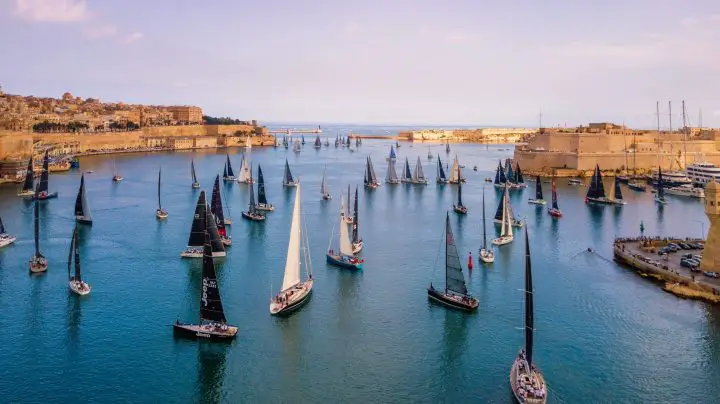
What Are Sailboat Types?
Sailboats are boats that are propelled by the wind. Sailboats use wind power instead of a motor or oars to move the boat. It should be noted, though, that nearly all modern sailboats have a motor as well. It comes in handy when docking in tight marinas and if the wind dies!
A sailboat has one, two, or three hulls. It has at least one mast, or tall vertical spar, that holds up one or more sails. The sails harness the power of the wind to move the boat forward.
To get started, here are some sailing boat types and terms to give you an idea of the sorts of boats that are out there.
- Dinghies — a small open boat, usually for only one or two people
- Daysailors — boats designed to go out for a day trip
- Cruising Sailboats — boats designed to travel long distances that have accommodations for their crew to live aboard a long term
- Sloop — the most common type of sailboat, with one mast and two sails (a jib and a mainsail)
- Ketch, yawl, or schooner — types of sailboats with two or more masts
- Monohull — a boat with only one hull
- Catamaran — a boat with two equal-sized hulls in the water that are connected together by a bridge deck
- Trimaran — a boat with three hulls in the water, the center of which is much larger than the outer two
What Does a Sailboat Look Like?
There are many different types of sailboats, so they look a little different from each other. The basics, however, are the same.
Each sailboat has at least one hull that sits in the water. Part of the hull is visible above the waterline. Part of the sailboat hull sits below the waterline.
The part beneath the waterline might be relatively small, or it can be quite large. The rudder, the mechanism used to steer the boat, is also underwater.
The cockpit is where the helmsperson sits and steers the boat. On small boats, the cockpit takes up the entire boat. Cruising boats have interior accommodations as well as a safe cockpit.
Sailboats have at least one mast and at least one mainsail. As you get to know the different types of sailboats, you’ll see many different hull and sail configurations.
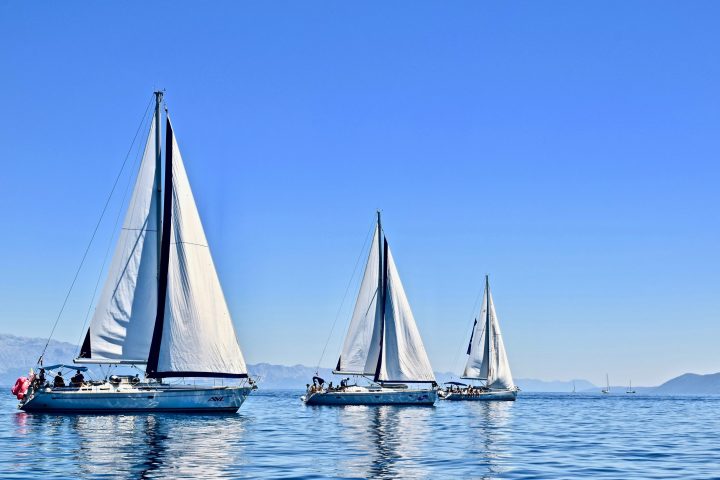
Different Types of Sail Boats
Sailboats come in all types of sailboat shapes and sailboat sizes . Sailboats can be classified by their hull shape, size, or sail plan. The sail plan is how many sails they carry on how many masts.
Hull shapes include monohulls, catamarans, trimarans, and sailing hydrofoils. A monohull has just one hull, a catamaran has two hulls, a trimaran has three hulls, and a hydrofoil lifts out of the water.
Sizes range from eight-foot sailboats to megayachts that are hundreds of feet long. Some sailboats are so small they are only suitable for one child who wants to go skimming across the lake. The largest pure sailing yacht in the world is the Black Pearl at 350 feet long (106.7 meters) long. Visit our Yacht vs Sailboat guide for a more definitive difference between the two and their sizes.
Sailboats also have different sail configurations or sail plans. For example, a sailboat with just one big sail on a forward-mounted mast is called a catboat. A boat with dozens of different sails on three masts is called a three-mast schooner.
Small sailboats are extremely popular and offer a lot of fun to the young and old. Most of the time, these boats are just used for daytime use in pleasant weather conditions. Kids often learn to sail in small monohull sailboats. Families might go for a picnic in a Hobie catamaran.
Yacht club members might race their 16-foot daysailors, while adventurous souls might take their 19-ft weekender and anchor in a calm cove for the weekend.
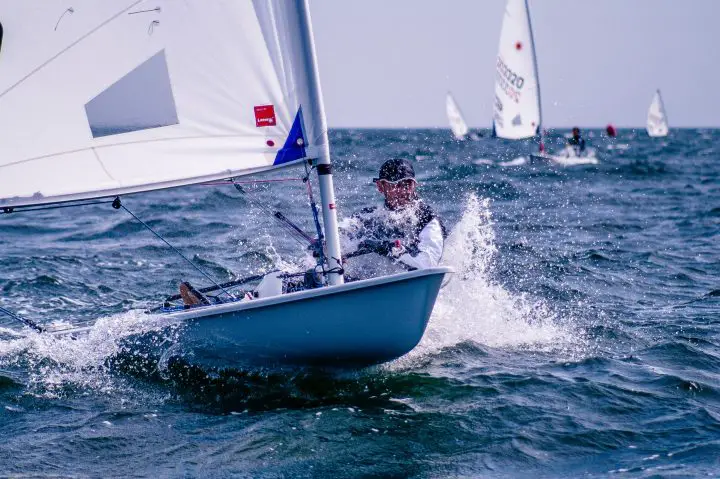
What is a Small Sailboat Called?
Small sailboats have different names, depending on the type of sailboat and the number of sail boat hulls. For example, the boat might be a monohull dinghy, small catboat, small catamaran, or daysailor.
Additionally, like every car on the road, every boat on the water is identified by its make and model. In small boats that are commonly raced, a certain make and model may set up a class of racing boats. Class racing means that all of the boats are identical, so the race is based solely on the skills of the skippers.
Sailing Dinghies
Kids and adults often learn to sail on sailing dinghies. Sailing dinghies can be as small as eight feet long. This small size makes it easy for kids to handle.
Some common sailing dinghies are Optis, Lasers, and Sunfish.
This size sailboat is also functional. They can be used to ferry sailors from their larger anchored boats to shore. The small size also helps sailors easily store their dinghy on larger boats. The word dinghy is often used to refer to any small boat used as a tender for a larger vessel, even if the tender is a motorboat.
Cat Rig Boats
A cat rig boat, or cat boat, is a type of sailboat that usually just has one large mainsail and a forward-mounted mast. Many smaller dinghies and training boats are catboats. A catboat has a free-standing mast with no standing rigging.
Small Catamarans
A catamaran is a boat with two hulls. The Hobie brand is synonymous with small catamarans, which are popular with families looking for a fun hobby. Hobie Cats are seen on the sand at beach resorts all over the world—they’re safe, fun, and fast.
Catamarans are faster than monohulls, and these boats are fun to race. Small catamarans are often used by families that live on the waterfront. Their lightweight makes them easy to drag to the waterfront and launch.
Small catamarans are also popular on beaches. Many beach resorts offer Hobie cats for rent. Small catamarans are between 12-20 feet in length. The hulls are joined only with spars and netting, so these fast and light open boats are not set up to carry a lot of people or supplies.
Daysailors are the ultimate fun boat. As the name implies, this type of sailing boat is used for day sailing. These boats are usually between 12 to 20 feet long. Some use these smaller boats for racing or overnight camping, but most sailors use daysailors for a leisurely sail.
Small Sailboats with Cabins
While most small sailboats just have a large open cockpit, several small yacht types have cabins. These cabins offer a chance for sailors to use a porta-potty or get out of the sun. Some small sailboats even have sleeping accommodations for overnight stays.
An excellent example of this is the Cape Dory Typhoon Weekender. This small sailboat is known as “America’s Littlest Yacht.” Down below, there are two small bunks for sleeping and enough space to have a small stove and a porta-potty. Most owners don’t stay aboard long-term, but the cabin is a useful place to stow items while sailing or to hide during a rainstorm.
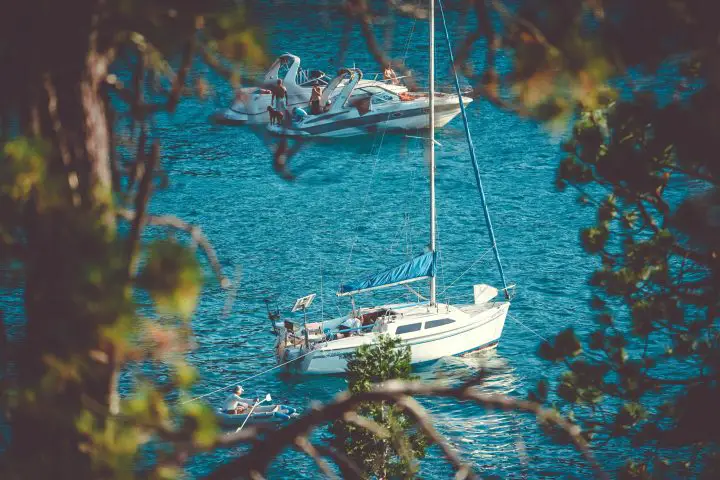
Cruising boats are boats that are capable of traveling long distances. Cruising boats have sleeping accommodations, cooking facilities, and bathroom facilities. These boats are like RVs for the waterway.
Cruising boats offer sailors the chance to live on their boats while sailing. Like RVs, cruising sailboats travel to different ports of call. Cruising sailboats are one of the more popular types of sailing boat. They offer adventurous sailors the chance to enjoy sailing as a sport while seeing new things.
Cruising boats are usually 30 to 50 feet long. Most cruising couples prefer a boat that is around 40 feet long since this provides enough space to live comfortably and enough storage space for all of their gear.
Monohulls are very popular cruising boats. These boats offer good storage, are safe, and are easy for a couple to handle together. Monohulls have different types of sail configurations.
Cruising Bermuda Rigged Sloops
Most monohulls are Bermuda rig sloops. This sail plan features one mast with a mainsail and a headsail. Bermuda rig sloops are easy to single-hand and very versatile. How many sails does a sloop have? A Bermuda sloop flies two sails at a time, which are the mainsail and a headsail.
However, the boat might have other sails onboard. For example, the captain might take down the jib in light winds and use a bigger genoa to capture more wind power. During a downwind sail with light winds, the captain might rig a large spinnaker, which looks like a huge kite, to keep sailing even in little wind.
Even within the sloop category, there are many variations in the design. A masthead sloop is one whose forestay (headsail) goes all the way to the top of the mast. In contrast, a fractional sloop’s forestay connects at some point lower. So a 3/4 fractional rig has a headsail that only goes up three-quarters of the way to the top.
Riggers and boat designers have a lot of tools in their toolbox from which they can make a boat faster or more user-friendly. The type of rigging and sail plan a boat is equipped with offers it performance improvements as well as functionality.
Cruising Cutter
A cutter is a sailboat with one mast, one mainsail, and two sails forward of the mast. The sail at the front of the boat is the jib, genoa, or yankee depending on its size and cut. The next sail in, the inner headsail, is called the staysail. Island Packets are popular boats with this sail plan.
Cutters are popular choices as cruising and bluewater cruiser boats because the staysail provides the skipper with many different sail options. They could fly all three sails fully, or they could fly a small partial mainsail and just the staysail for heavy winds.
Cruising Ketch With Mizzen Sail
Some cruising monohulls are ketches. A ketch can be easily identified by its two masts. The forward mast is the main mast with a mainsail. The aft mizzen mast is shorter and has a mizzen sail. This sail plan can make it easier to carry a big sail area and configure the sails for various sailing conditions.
A boat with more than one mast is called a split rig because the rig is split between two shorter masts instead of all mounted on one tall one. The advantage of a split rig is that there are more sails, each of which is smaller. That makes them easier to handle, and important consideration when you are sailing alone or with only one other person.
Cruising Yawl
A yawl is similar to a ketch and has two masts. However, the mizzen mast on a yawl is aft of the rudder post, whereas it is forward of the rudder post on a ketch. This mizzen mast location is even further back than a ketch’s. Yawls are one of the less popular types of sailboats. However, like the ketch, they offer diverse sail options and can keep sailing in many different types of weather.
On both ketches and yawls, the mizzen mast is shorter than the main mast. If the two masts are of equal height, or the forward mast is shorter, then you are looking at a schooner.
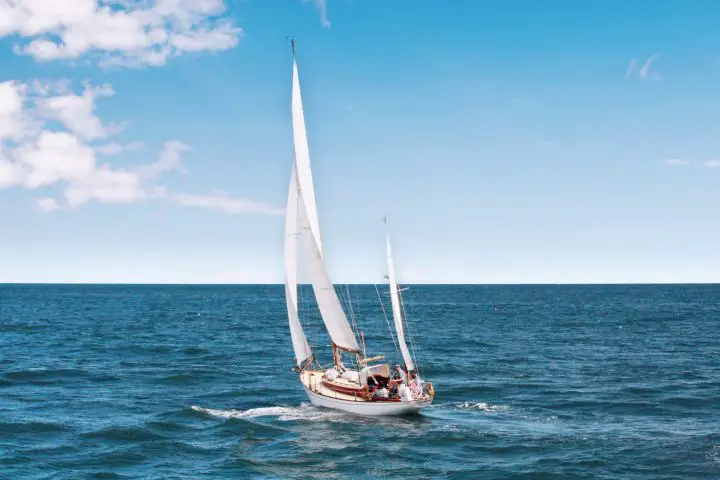
Cruising catamarans are one of the most popular classes of sailboats right now. This type of sailing boat has two hulls and offers sailors speed, space, and comfort. A cruising catamaran is usually between 40 and 60 feet long and 20 to 30 feet wide. The additional width offers cruise sailors huge amounts of space.
Cruising catamarans have excellent storage space and ample living accommodations if you intend to living on a boat . These boats are popular with couples and families and are often used to sail around the world on circumnavigations.
Cruising catamarans are usually fractional sloop rigs. They have one mast, a large mainsail, and a jib or genoa. In general, these boats are designed to be easy to sail and minimize complications.
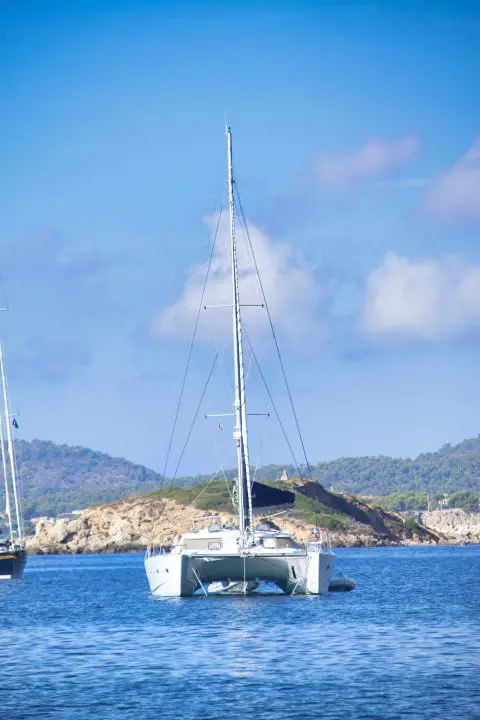
Trimarans are a type of sailboat with three hulls. Trimarans are known to be fast and are popular with racing sailors. However, they are also gaining popularity as cruising boats. These boats usually have fewer accommodations than cruising monohulls and catamarans. However, more modern trimarans like the Neel Trimaran have luxurious living spaces.
Types of Keel
Another way to classify the different types of sailing boats is by looking at the boat’s keel type. You can easily get an idea of different keel designs by walking around a boatyard. When a sailboat is in the water, it is hard to tell the shape of its keel.
The keel is the bottom part of the hull and is underwater. The keel is structurally essential. The keel’s weight helps the boat sail evenly and uprightly. The force created by the water moving over the keel counteracts the effects of the wind on the sails.
So a keel does two jobs for a sailboat. First, it provides a force that allows a sailboat to sail into the wind. Second, it provides stability. If storm-force weather conditions cause a monohull boat to roll, the weight in the keel will help the boat right itself.
Many older cruising boats had full keels. The keel shape runs the entire length of the boat. A full-keel boat is strong and easy to manufacture. Full-keel boats often have deeper drafts. The boat’s draft refers to the amount of water it needs to float. Full-keel boats can’t go into the shallow anchorages that catamarans or swing-keel boats can access.
Captains often report that full-keel boats are harder to maneuver in tight places such as marinas. Full-keel boats lack quick maneuverability. They have a reputation for being slower than more modern designs, but they make up for this by providing a very comfortable and safe ride in rough weather.
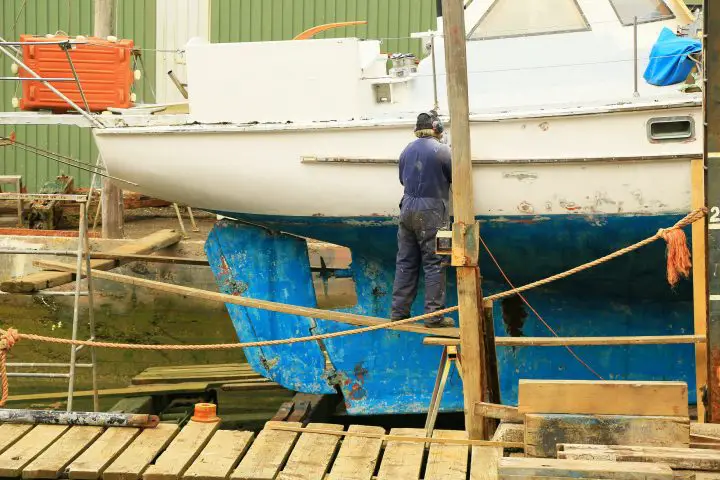
A boat with a fin keel has a smaller underwater profile than a boat with a full keel. This smaller keel resembles a fish fin. Captains find fin keel boats easier to maneuver. Fin keels use their shape to create very effective forces underwater. That makes them very good at countering the forces on the sails, meaning that fin keels sail upwind very well.
A boat with a bulb keel has a torpedo-shaped bulb on the bottom of a fin keel. Bulb keels offer improved stability. Bulb keels have shallower keels than a fin keel boat. The bulb also lowers the center of gravity in the boat, making it more stable overall.
A wing keel features a keel with a small wing on either side of the keel. Viewed from above, the keel looks like it has a set of small airplane wings.
Similar to a bulb keel, wing keel boats often have a shallower draft than fin-keel boats. However, the additional shape causes drag and can reduce sailing performance in some circumstances.
A centerboard is common on small daysailors that are launched and retrieved from trailers. Deep keels make getting those boats in and out of the water difficult. By chopping off the keel, you can make a sailboat as easy to launch as a powerboat.
Related: Best Trailerable Sailboats
But of course, a sailboat needs to have a keel. A centerboard is a simple swinging fin keel that can be raised or lowered. This provides some excellent benefits if the sailor on board likes to explore areas with shallow water.
Many bigger boats have centerboards, too. A boat with a centerboard can be seen as the best of both worlds. A centerboard boat has a fixed shallow draft keel. However, the captain can deploy the centerboard when sailing in deeper waters. The centerboard adds depth to the keel and offers increased stability and performance.
A modification of the centerboard is the swing keel — a ballasted keel that can be retracted like a centerboard . These are rare. They’re used on large cruising boats where the crews want the option of accessing shallow waters. In England, this type of boat is used and can be dried out when the tide goes out.
Racing Sailboats
Yacht racing is a popular sailing sport. It’s a great way to get out on the water while competing. In fact, racing is a great way for sailors to hone their sailing skills. Sailors have to pay close attention to weather conditions and manage their sails effectively to maximize their speed.
Sailors can race any boat with sails. Kids race sailing dinghies against each other. Club racers sail daysailors or catboats. Catamarans and trimarans are also popular race boats. Several classes of boat races in the Summer Olympics.
Hydrofoil Sailboats
A hydrofoil is a unique and modern type of racing sailboat. A hydrofoil can be a monohull, catamaran, or trimaran. A hydrofoil has wing-like foils on the hull’s underside.
As the sailboat speeds up, the hydrofoils lift the hull out of the water, and the hydrofoil sailboat almost appears to be flying above the water.
Because the hull is now out of the water, drag, and resistance are minimal, and the sailboat can sail even faster. For example, a dinghy that usually goes four knots can accelerate to 12 knots when fitted with a hydrofoil.
Most hydrofoil sailboats are catamarans and trimarans. The added width of these multihull sailboats gives the hydrofoil sailboat more stability.
Traditional Sailboats
Traditional sailboats are the type of sailboats used to transport people and goods before modern transportation options were available. Before the railway, cars, and airplanes, a tall ship sailboat was used to ship cargo and people across oceans and from port to port.
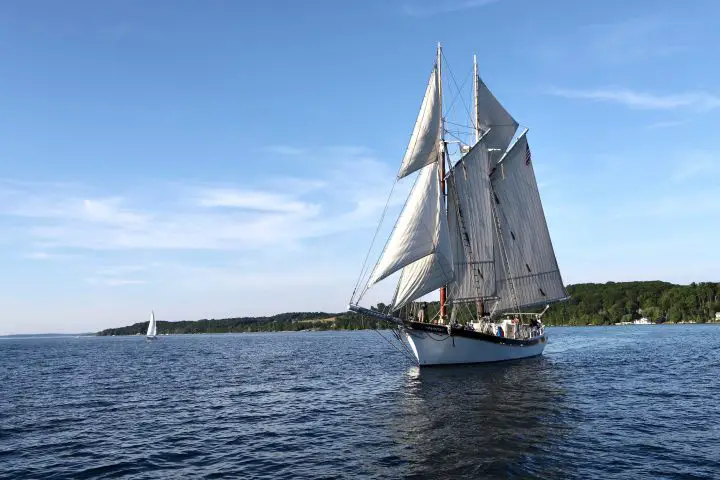
A gaff rig refers to the gaff, which is the upper spar on a square-shaped sail. Gaff rigs can be used with any mast configuration, but this feature is usually seen on traditional boats like a catboat, tall ship, or schooner.
A schooner has at least two masts. They are different from other mast configuration designs with two spars in that both masts are equal in height, or the forward mast is shorter. Schooners are faster than most traditional boats and were often used to transport perishable goods such as fruit.
Schooners were also popular race boats in the early 20th century. For example, first America’s Cup races were won by schooners.
Today, schooners are usually used as charters for vacations or youth sail training programs. But there are a few cruising boats out there that feature schooner rigs.
Any way you divvy it up, there are tons of different types of sailboats out there. With a little research and a little looking, you’re sure to find one that suits your style and boating plans.
What are the classes of sailboats?
Sailboat styles can be classified by hull type, use, or sail plan. The types of sailboat hulls include monohulls, catamarans, and trimarans. You can also categorize the kinds of sailboats by their use. For example, sailors use their boats for daysailing, cruising, and racing. Finally, different kinds of sailboats have different sail plans. A sailboat might be a sloop, ketch, yawl, catboat, or schooner. The term “classes” has a particular meaning in sailing, however. Class racing is the competitive racing between boats of the same make and model—boats of the same “class” or of “one design.” There are hundreds of different classes of sailboats out there. Some of the most popular classes include the Laser and Sunfish classes.
What is a small 2 person sailboat called?
A small two-person sailboat is a dinghy. These small boats are fun to sail on protected waters. Many kids learn to sail in a sailing dinghy. There are dozens of makes and models of sailing dinghies available, some are used in Olympic sailing racing while others are just rowboats with sail rigs attached.
Matt has been boating around Florida for over 25 years in everything from small powerboats to large cruising catamarans. He currently lives aboard a 38-foot Cabo Rico sailboat with his wife Lucy and adventure dog Chelsea. Together, they cruise between winters in The Bahamas and summers in the Chesapeake Bay.
Leave a comment
Your email address will not be published. Required fields are marked *
Save my name, email, and website in this browser for the next time I comment.
The simplest entrance to the world of sailing
Types of Sailboats – The Ultimate Guide
There exist many different sailing boats types and they can be classified by various criteria. This blog post discusses the most common types of sailboats (both modern and traditional). Sailboats are classified by:
- the number of hulls
- construction material .
Types of Sailboats by Size
Sailboat division by size could be as follows:
- Sailing dinghies (small)
- Cruising sailboats (mid size)
- Tall ships (large).
Dinghies are small sailing boats, typically up to 6 meters long (approximately 20 feet). They are open (i.e. they don’t have a cabin) and most often don’t have an engine. Operated by a crew of one or two persons, they are used for shorter (day) sailings in coastal regions. There are many different types of sailing dinghies and they could be divided to traditional dinghies (typically made out of wood) or modern dinghies (typically made out of fiberglass ). Most modern dinghies are allowed to capsize (i.e. overturn) and recover as an integral part of their use.
Here are some of the most popular types of modern dinghies:
- Optimist – small single-handed dinghy for young people under the age of 15
- Laser – single-handed dinghy, an Olympic class since 1996
- 420 – 4.2 meters long double-handed dinghy used for racing and teaching
- 470 – 4.7 meters long double-handed dinghy, an Olympic class since 1976.
Remark: The term dinghy can also refer to any small boat carried by a larger boat in order to facilitate access to/from the shore.
Cruising Sailboats
Cruising sailboats are typically 6 to 20 meters long (approximately 20-60 feet), but can be even longer. They have cabins which allow for onboard sleeping and longer cruises that might last an arbitrary number of days. Also, they normally have either an outboard or an inboard engine which is used for leaving from and returning to the berth, as well as to provide propulsion when there is not enough wind. As opposed to sailing dinghies, cruising sailboats can be safely sailed during the night and are not intended for capsizing. Different cruising sailboat types are listed below by the rig type.
Remark: The term cruising sailboat is used for mid-sized sailboats, since nowadays sailing is practiced mainly for pleasure and sport, be it cruising or racing. However, it should be clear that mid-sized boats were historically used for work, trade or even military purposes.
Tall ships are large sailing boats, typically over 40 meters long (approximately 130 feet). They use traditional sails which are set on multiple masts (2 to 5). When talking about tall ships first thing that comes to mind might be old wooden ships that sailed the oceans from 15th to 19th century and were used for trade and military purposes. However, there also exist modern tall ships that are built from modern materials and are used for tourism (cruising) or training (navy cadets). For more information, check out Wikipedia’s Tall ship article.
Rig is the name for the arrangement of masts and sails on a boat. There are basically two main rig types:
- Fore-and-aft rig.
Square rig is a traditional rig typically used on tall ships. It is characterized by the sails being set perpendicular to the length of the boat (or transversely to the sailing direction). This type of rig is efficient when sailing downwind, but is unable to sail upwind (against the direction of the wind) or it performs poorly when attempting to do so. Today, square rig is used only on tall ships.
Fore-and-aft rig is characterized by the sails being set along the length of the boat (or longitudinally to the sailing direction). This type of rig is capable of sailing both upwind and downwind. All the modern sailboats (other than tall ships) are fore-and-aft rigged.
Some important fore-and-aft rig types are:
- Bermuda rig.

Lateen rig is a traditional rig type originating from the Mediterranean. It consists of a triangular sail hanging down from a spar (pole) which is hoisted on the mast at a certain angle. Lateen rig can still be seen today on smaller, wooden traditional boats. For instance, in certain places along the Croatian Adriatic coast, sailing regattas of traditional lateen-rigged boats are regularly organized.
Gaff rig is characterized by the four-sided mainsail which is hoisted along the mast and stretched between the two spars: upper one called the gaff and lower one called the boom. Gaff-rigged boats also carry a foresail called a jib. They may also carry a topsail which is hoisted above the gaff. Nowadays, gaff rig has been largely superseded by the newer Bermuda rig.
Bermuda Rig
Bermuda rig is by far the most popular type of rig on modern sailboats. It is characterized by the two triangular sails: mainsail and jib. Mainsail is hoisted along the mast and stretched along the boom (see our post: Parts of a Sailboat ). Some racing boats may carry a square top mainsail, but cruising sailboats will in most cases carry a triangular-like mainsail. Advantage of Bermuda rig over other rig types is sail efficiency and ease of sail handling. Bermuda rig is sometimes referred to as the Marconi rig.
Remark: There exist more fore-and-aft rigs, e.g. lug rig, gunter rig and others.
Cruising Sailboats by Rig Type
Cruising sailboats are fore-and-aft rigged boats with one or two masts. Older boats were mostly gaff-rigged and they might still be seen today, while modern and new build boats are almost exclusively Bermuda rigged. The most common single-masted cruising sailboat types are:

The most common two-masted cruising sailboat types are:

Single-masted
Sloop is a boat with a single mast. In this blog and in Your First Sailing Handbook the most widespread modern type of sailing boat is considered and that is a Bermuda rigged sloop.
Cutter is a boat with a single mast that normally sails with two or more foresails (jibs) simultaneously. It is more demanding for sailing than sloop, as there is one additional sail to handle. However, cutters offer some advantages (primarily for offshore sailing) as discussed in this Cutter or sloop rig? article. The term cutter might also refer to:
- a small, light sail- or oar-powered boat carried by a larger vessels
- a fast and agile official vessel used by the authorities to enforce law (e.g. US Coast Guard cutter)
- a fast boat from the 18th century carrying both fore-and-aft and square sails.
Ketch is a boat with two masts, the taller foremast (mainmast) and the shorter after mast (mizzen mast). Ketch is characterized by the rudder post being positioned abaft the mizzen mast.
Yawl is a boat similar to a ketch, the difference being that the rudder post is positioned forward of the mizzen mast. Also, yawl’s mizzen mast is typically shorter than that of a ketch.
Schooner is a boat with two or more masts, where the foremast is no taller than the after masts. In case of a two-masted schooner, taller aftermast is called the mainmast.
Why Sloops are so Popular Nowadays
Cutters, ketches, yawls and schooners were once popular because they could have the same sail area as sloops with the individual sails being smaller and thus easier for handling. However, development of modern equipment made sail handling much easier irrespective of the sail size. This is one of the reasons why sloop has become the most widespread cruising sailboat type today. Another reason is that rigs with two masts are more expensive to build and maintain. Finally, sloops generally perform better when sailing upwind. For more information see the following post discussing two-masted sailboats .
.Modern sloops can be categorized to cruisers, racers and performance cruisers. Cruising sloops sacrifice sailing performance for comfort, meaning that the interior is well equipped but heavy, while sail handling is easy but suboptimal in terms of sailing efficiency. On the other hand, racing sloops usually have bare interior (in order to reduce weight), but large cockpits to give the crew enough space to handle many different sails and work with many lines. Finally, performance cruisers usually offer a good trade-off between cruisers and racers, providing good comfort below the deck and decent sailing performance above the deck.
Types of Sailboats by the Number of Hulls
All the cruising sailboat types mentioned above are monohulls (they have one hull). However, sailboats may have more than one hull and they are called catamarans (in case of two hulls) or trimarans (in case of three hulls). Catamarans and trimarans are jointly called multihulls. Multihulls are typically single-masted and Bermuda-rigged, while being built from modern materials like fiberglass .

Dinghy catamarans are usually very agile and fun for sailing, but they require a skilled crew. Due to their low weight, they heel easily during sailing, resulting in one hull being raised above the water, which in turn reduces water resistance and allows the boat to sail faster.
On the other hand, majority of cruising catamarans are heavy and don’t heel much during sailing in normal conditions. They might not be as fun for sailing as monohulls, but they offer a lot of comfort since their interior is quite spacious. Compared to similarly equipped and sized monohulls, cruising catamarans have poorer performance upwind, but are usually faster downwind.
There also exist performance catamarans and trimarans which are built for speed and they are much faster than monohulls of similar size. Such boats are not widely available for chartering since they require a skilled crew.
Types of Sailboats by Construction Material
Main part of any boat is its hull and it can be constructed from different materials. Trade-off has to be made between strength and weight. Generally speaking, you want the sailboat to be strong and safe, while at the same time you want it to be light and fast. Main boat building materials are:
- Composite materials.
Traditionally, sailboats of all sizes were made out of wood and there is still a fair amount of wooden boats sailing today. Even though wood does not have favorable characteristics like modern composite materials, many owners prefer wooden boats for aesthetic and nostalgic reasons. Also, there are still new wooden sailboats being built either for private owners (often dinghies or smaller cruisers) or as a part of maritime heritage preservation projects. Wooden boats are very nice and appealing, especially if maintained properly, however that requires a lot of time and dedication.
Sailboat’s hull can also be constructed out of metal, most often steel and aluminum. Steel is very strong, but heavy, while aluminum is much lighter, but not as strong as steel. Precautions must be taken to prevent corrosion of both materials. Steel suffers from rusting, while aluminum suffers from galvanic corrosion.
Composite Materials
Vast majority of modern sailboats is made out of fiberglass, a composite material also known as glass-reinforced plastic or glass-fiber reinforced plastic. As the name suggests, this material is made from fine fibers of glass which are interwoven into fabrics and then reinforced with resin. Fiberglass is easily molded to form hulls and decks of different shapes. This allows fiberglass boats to be mass produced simply and cheaply, which is one of the reasons for their popularity. Fiberglass is very durable, so fiberglass boats have long life expectancy with relatively easy and simple maintenance. This is because fiberglass does not rot like wood, nor does it suffer from corrosion like steel and aluminum.
Modern high performance racing boats are typically made from carbon fibers which is a short name for carbon-fiber reinforced plastic. This technology is very similar to fiberglass, with the glass fibers being replaced by the carbon fibers. In comparison, carbon fiber technology offers much better strength-to-weight ratio, but it is also much more expensive than fiberglass. High price is the main reason hindering mass production of carbon cruising sailboats.
Vedran Bobanac
Vedran Bobanac has been sailing since the age of 10, while he has been working as a skipper and as a sailing instructor for almost 20 years now. He also holds PhD degree in electrical engineering and he enjoys using his technical knowledge, as well as pedagogical skills to teach sailing and publish sailing handbooks .
- Types of Sailboats
- Parts of a Sailboat
- Cruising Boats
- Small Sailboats
- Design Basics
- Sailboats under 30'
- Sailboats 30'-35
- Sailboats 35'-40'
- Sailboats 40'-45'
- Sailboats 45'-50'
- Sailboats 50'-55'
- Sailboats over 55'
- Masts & Spars
- Knots, Bends & Hitches
- The 12v Energy Equation
- Electronics & Instrumentation
- Build Your Own Boat
- Buying a Used Boat
- Choosing Accessories
- Living on a Boat
- Cruising Offshore
- Sailing in the Caribbean
- Anchoring Skills
- Sailing Authors & Their Writings
- Mary's Journal
- Nautical Terms
- Cruising Sailboats for Sale
- List your Boat for Sale Here!
- Used Sailing Equipment for Sale
- Sell Your Unwanted Gear
- Sailing eBooks: Download them here!
- Your Sailboats
- Your Sailing Stories
- Your Fishing Stories
- Advertising
- What's New?
- Chartering a Sailboat
The Different Types of Sailboats
If you’re a sailboat fanatic like me, all types of sailboats will attract your attention. Some more so than others admittedly, but all will have something about them that catches your eye.
If you’re not a fanatic (not yet, that is) but just an interested observer, then the first thing you’ll notice about a sailboat will be how many masts it has and the configuration of its sails - in other words, its 'rig'.
This observation alone will enable you to identify the five main types of sailboats — sloops, cutters, ketches, yawls and schooners - all of which are described here.
But apart from the various rig types, you can describe types of sailboats from a different viewpoint - sailing dinghies, dayboats, motorsailors, monohulls, catamarans and trimarans.
Let's make a start with the various rig types...
A single-masted sailboat with just two sails — a foresail (aka headsail or jib) and a mainsail — is a sloop, the purest type of sailboat.
The sloop rig can also be described as a Bermuda rig, Bermudian rig or Marconi rig.
Read more about sloops...
Examples of Sloops
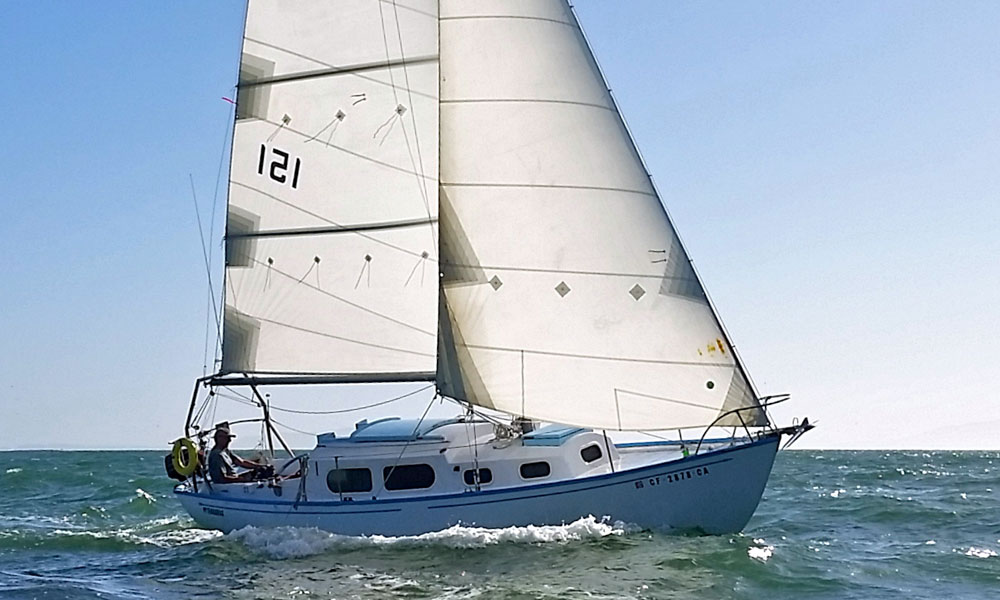
If a sloop has an additional sail between the headsail and the mainsail, then it's no longer a sloop - it's a cutter.
Some cutters - like the one shown here - have the foresail set forward on a bowsprit, with the inner forestay permanently rigged to the stemhead where the foresail otherwise would be, or to a central chainplate further aft on the foredeck.
Read more about cutters...
Examples of Cutters
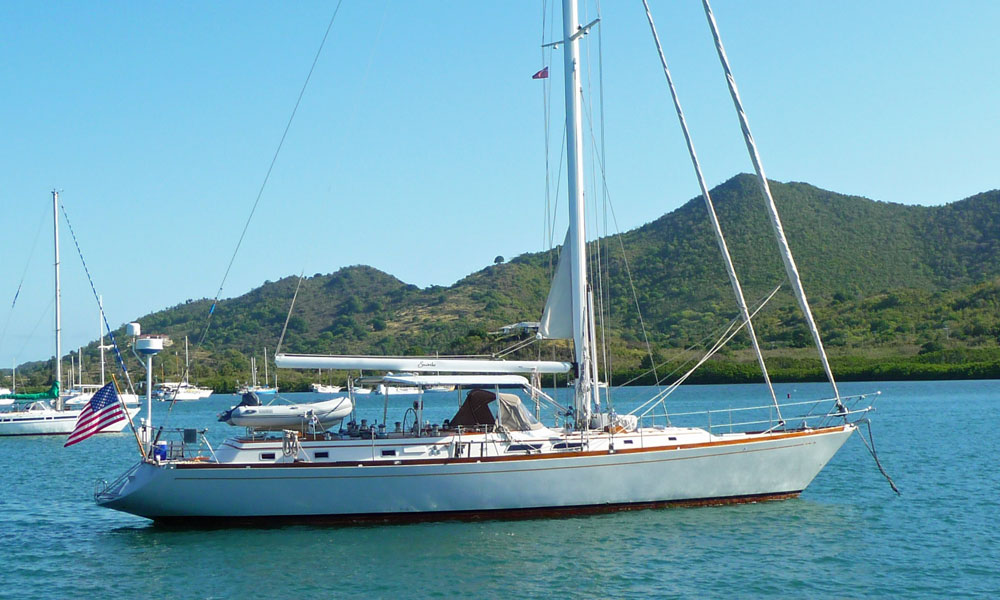
The following boats may look like cutters with their double headsails, but they're not cutters at all...
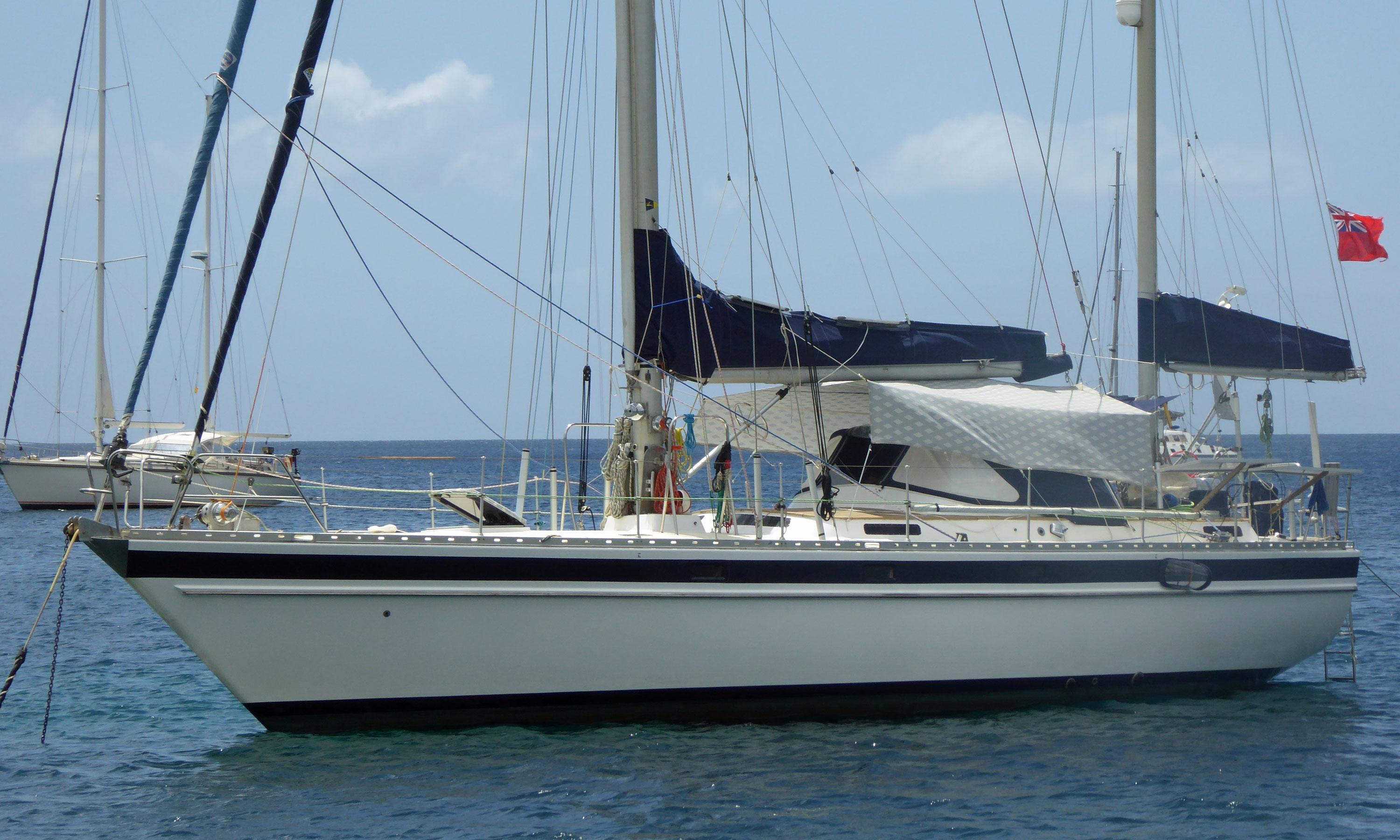
To find out why, click here...
A ketch is a two-masted sailboat, a main mast forward and a shorter mizzen mast aft.
But not all two-masted sailboats are ketches — they might be yawls (see below).
A ketch may also sport a staysail, with or without a bowsprit, in which case it would be known as a cutter-rigged or staysail ketch.
Read more about ketches...
Examples of Ketches
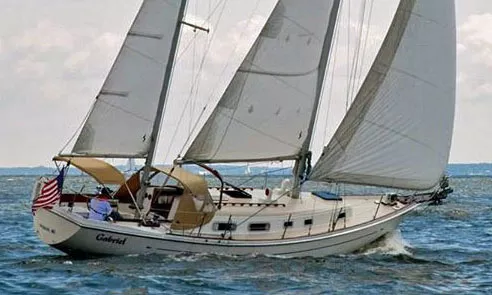
Note that the Ocean 71 and the Irwin 52 are cutter-rigged, and are traditionally referred to as Staysail Ketches .
Cat Ketches
Cat-ketches are recognised by the lack of any standing rigging to support their pair of unstayed masts.
And yes, if the after mast is taller than the foremast then it's called a cat- schooner sailboat.
Read more about cat-ketches...
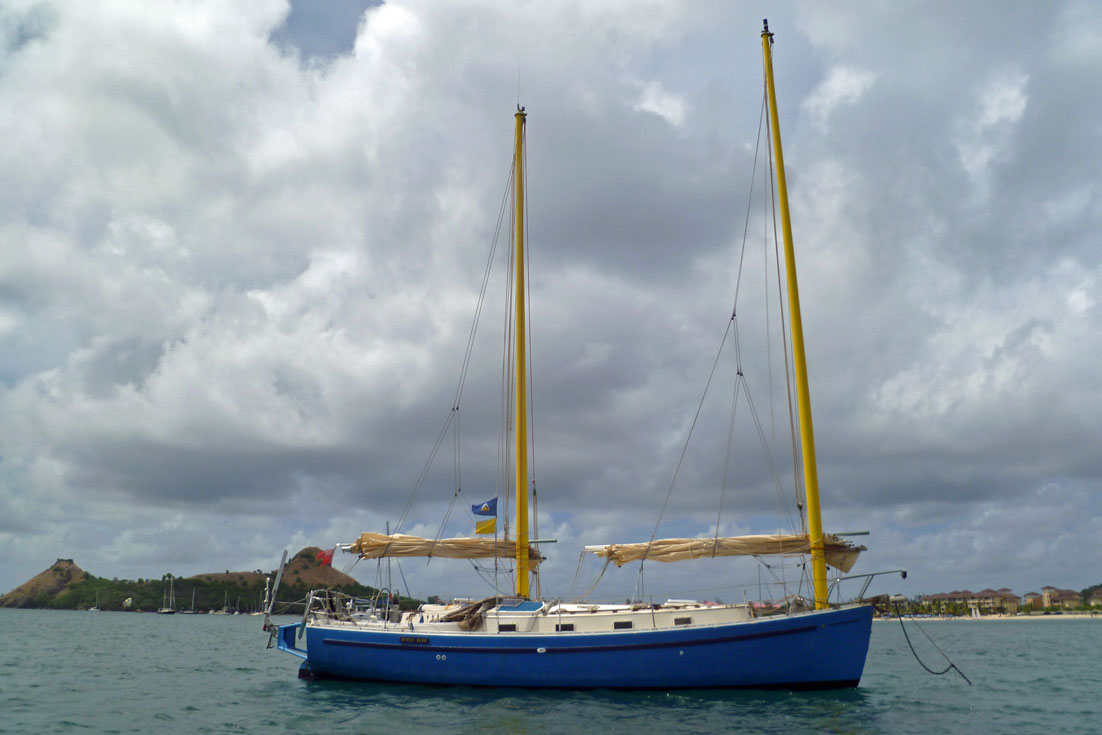
Yawls have their origins as old-time sail fishing boats, where the small mizzen sail was trimmed to keep the vessel steady when hauling the nets.
Much like a ketch, the difference being that the yawl has the mizzen mast positioned aft of the rudder post whereas the ketch has its mizzen mast ahead of the rudder post.
You’ll not be surprised to learn that a yawl with a staysail is known as cutter-rigged yawl.
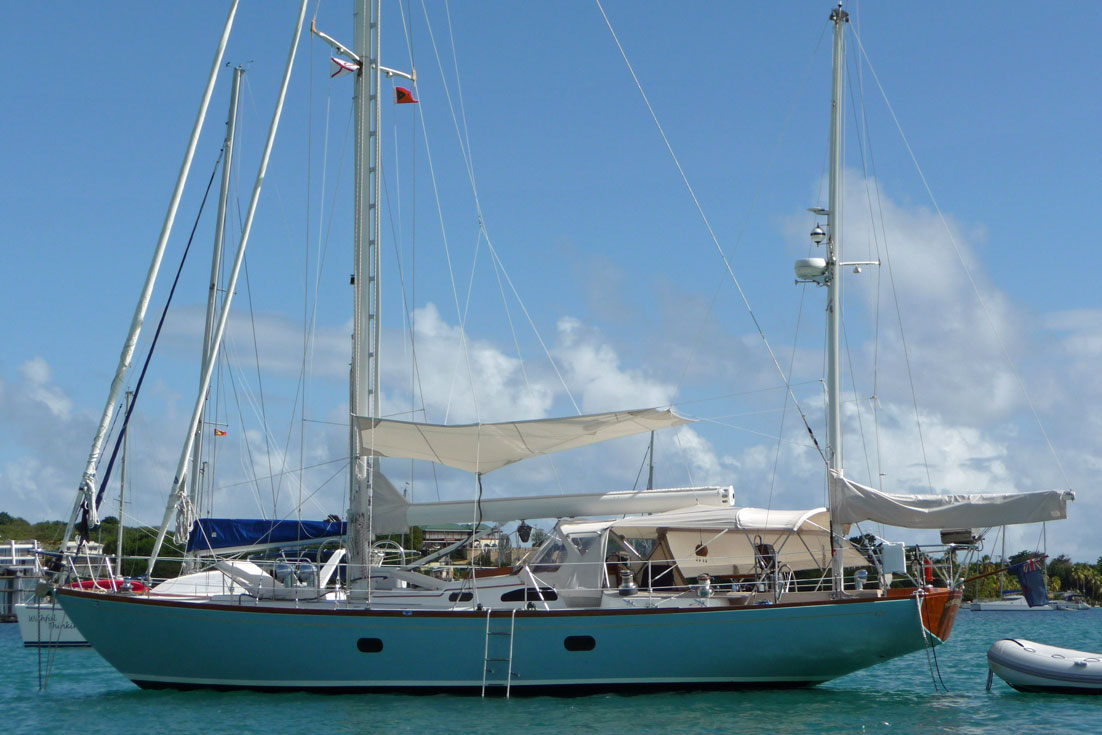
A schooner is a two-or-more masted sailboat, in which the aft-most mast - the mainmast - is the same height or taller than the foremast.
The one shown here is gaff cutter rigged, with a topsail set on the mainmast.
Many sailors agree that of all the different types of sailboats, a schooner under full sail is one of the most beautiful sights afloat.
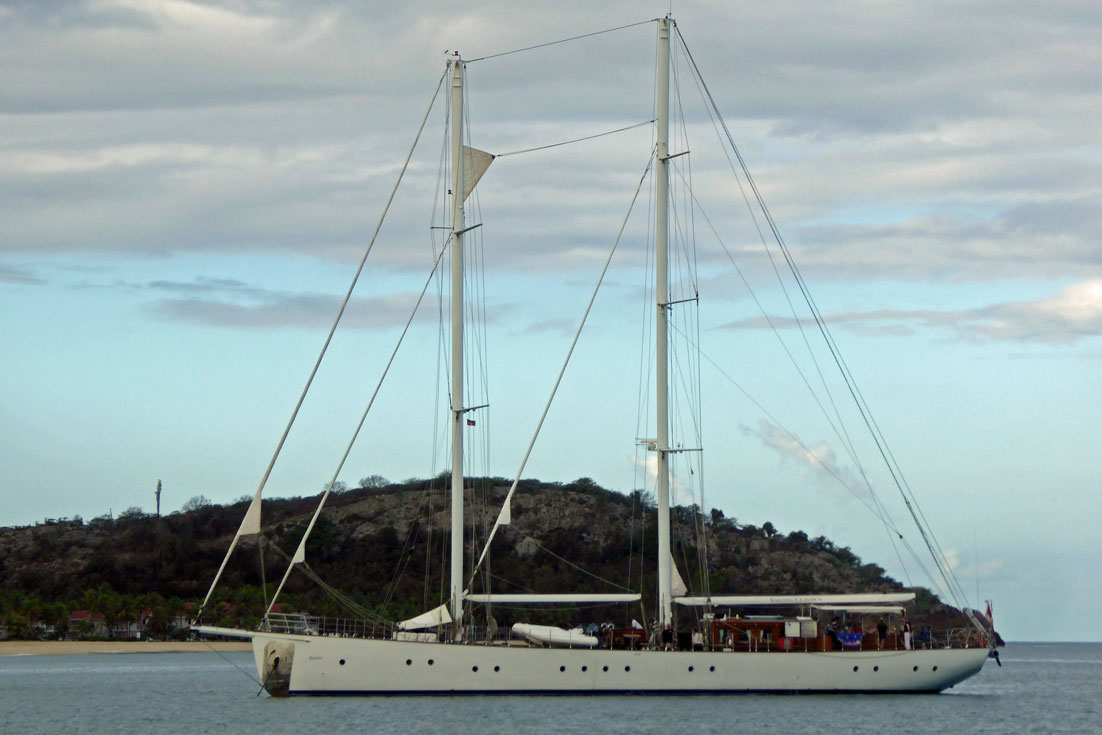
Gaffed-rigged sailboats, or 'gaffers', have their mainsail supported by a spar - the 'gaff' - which is hauled up mast by a separate halyard.
Often these types of sailboats are rigged with a topsail, as shown here and in the gaff schooner above, which really adds some grunt in light airs.
All this comes at a price of course, both in terms of material cost and weight aloft, which is why very few modern yachts are fitted with gaff rigs these days.
All artwork on this page is by Andrew Simpson
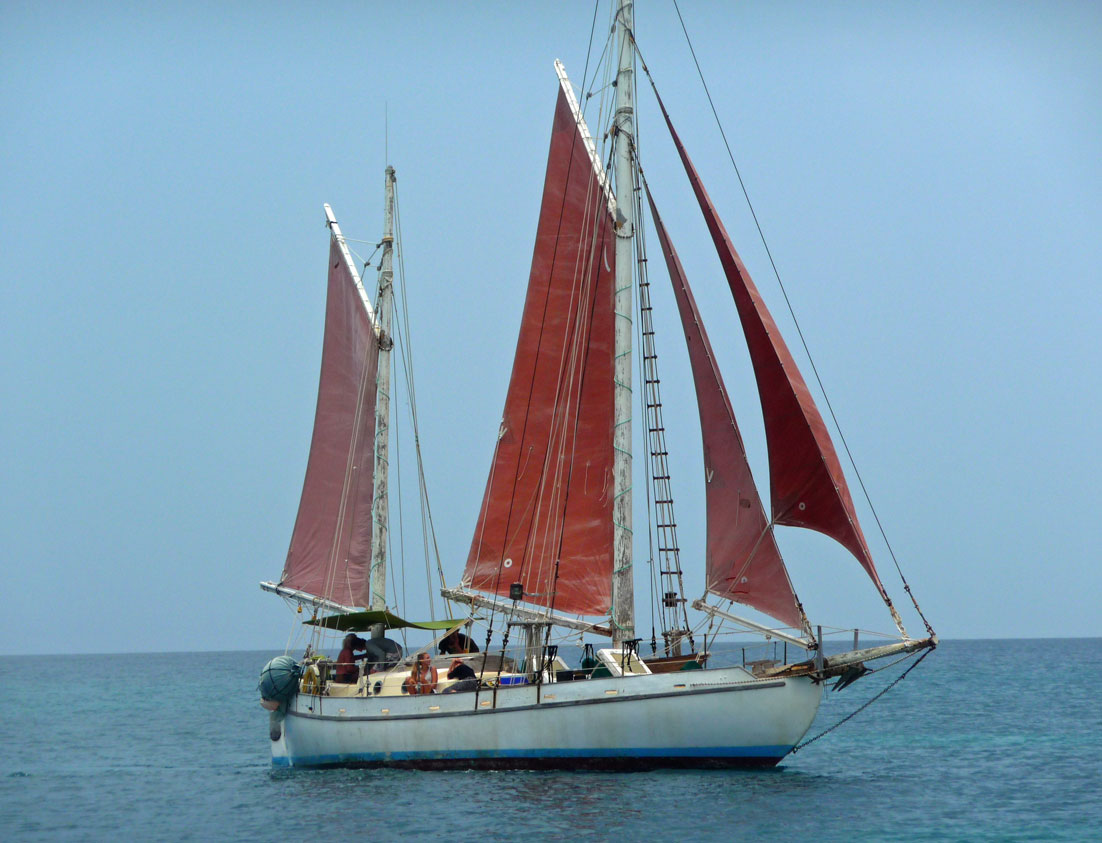
Examples of the Various Types of Sailboats...
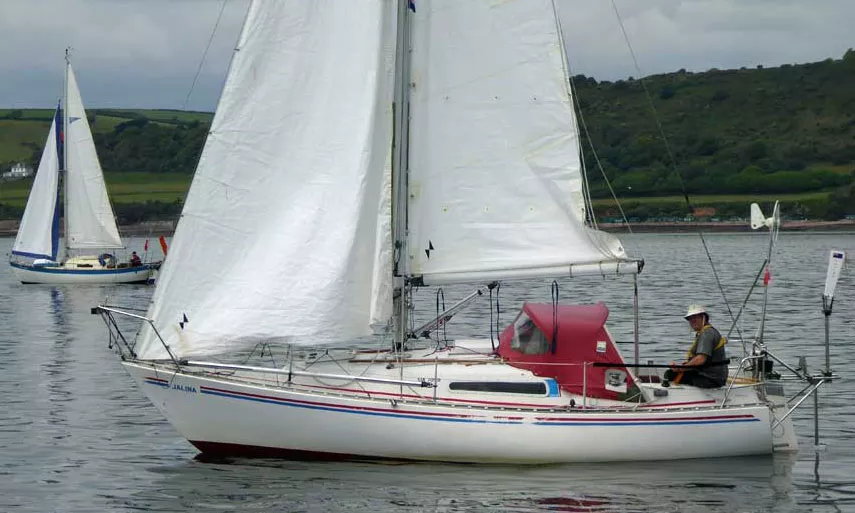
Other Types of Sailboats
The seven sailboat rig variations shown here are the most popular types of modern cruising boat rigs, but there are other rig versions which were once found on commercial, fishing, and naval sailing vessels.
They include:
- Full square-rigged sailing vessels
- Barkentines
- Brigantines
And you can see examples of them here ...
In this article I've said that ketches, yawls and schooners with two headsails can be called cutter rigged. This is a commonly used description but strictly speaking, there's only one rig that can accurately be called a cutter - and that's a single-masted sailboat with two headsails. My thanks to 'Old Salt' for drawing my attention to this!
Recent Articles
The CSY 44 Mid-Cockpit Sailboat
Sep 15, 24 08:18 AM
Hallberg-Rassy 41 Specs & Key Performance Indicators
Sep 14, 24 03:41 AM
Amel Kirk 36 Sailboat Specs & Key Performance Indicators
Sep 07, 24 03:38 PM
Here's where to:
- Find Used Sailboats for Sale...
- Find Used Sailing Gear for Sale...
- List your Sailboat for Sale...
- List your Used Sailing Gear...
Our eBooks...

A few of our Most Popular Pages...

Copyright © 2024 Dick McClary Sailboat-Cruising.com

Boats for Sale
Guide to the different types of sailboats.
Sailing is a wonderful hobby that is appropriate for a wide range of ages and ability levels. Sailing is the art of controlling and maneuvering a boat with the power of sails. Sailors need to learn about the power of wind and water, as well as understand the basic function and operation of a sailboat. A sailboat is a small to mid-sized boat that is powered by the use of sails, some more modern designs are also powered with a small motor, but this is not characteristic of most sailboats. The dual forces of hydrodynamic and aerodynamics combine to provide a sailboat with the ability to move through water. A sailboat may have one or more sails attached to the mast and/or a boom. Sails may also be attached to winches, mechanical devices used for winding, or to cleats that are used for tying. Learning how to maneuver the sails and steer the sailboat takes time and attention; for the safety of those onboard and fellow sailors, it is important that each sailor understand the proper way to maneuver and operate a sailboat.
There are many different types of sailboats. Sailboats can be categorized into a few different types, depending upon the number and location of sails, as well as the number of masts. Here is a brief introduction to the different types:
A catboat is a single-sail boat with one mast set up near the front of the boat. The origin of the catboat can be traced back to New York in the 1840s. Its easy operation and large capacity helped the sailboat gain popularity among sailing enthusiasts. The catboat has a broad beam, a centerboard and a single mast and sail. However, any sailboat with a single sail carried forward is referred to as a catboat. Popular catboats include the Beetle Cat, Barnegat Bay and Sanderling.
- Association for Catboat Sailors
- What is a Catboat
A cutter is a sailboat with one mast and more than one headsail. According to Frank Sargeant in The Complete Idiot's Guide to Boating and Sailing , a cutter has a mast stepped amidships with two sails that are set up forward of the mast. Usually, the staysail is directly in front of the mast. The cutter is ideal for small crews or groups of people and most cutters can be easily managed without the need for complicated tackles or winches.
- What is a Cutter
- Peterson Cutters
A dhoni, or doni, is a handcrafted, sailboat with either a motor or lateen sails. Popular in the Maldives, this boat is used for transportation and even, for staying aboard comfortably. Traditionally, this boat was built of coconut palm wood and used by Maldivian fishermen. Today, the dhoni is typically built using fiberglass, are generally motorized with a steering wheel and are furnished as well. According to the FAO, the motorized fishing vessels or masdhoni are fitted with satellite navigation systems, hydraulic line haulers, sonars, fish finders and have room for accommodation as well.
- Association for Wooden Boats
- About the Dhonis of Maldives
A smaller version of the sailboat, the dinghy has three or less sails - the mainsail, jib and spinnaker. These small boats are easy to handle and fun to sail, making them popular with youngsters. Dinghies are further divided into different types such as catamarans, skiffs, classic dinghies, cruising dinghies, high performance dinghies, racing dinghies and sports dinghies.
- Types of Dinghies
- Dinghy Sailing Races
Fractional Rig Sloop
A fractional rig sloop is a sailboat in which the headstay is attached to the mast at some point lower than the masthead. This enhances performance in certain conditions but may make the fractional rig sloop a little difficult to handle, since the bend of the mast has an impact on the mainsail and bending the mast perfectly requires a fair amount of skill. However, the fractional rig requires fewer sail changes and lesser experienced sailors may benefit from setting up a masthead rig or one in which the headsail reaches all the way to the top of the mast.
- Definition of a Fractional Rig
A ketch is a sailboat that has two masts and two sails. The second mast is called a mizzen and the sail is called the mizzen sail. The second mast is shorter than the main mast and is located forward of the rudder. Smaller and narrower in size than other sailboats, ketches were traditionally used for trading purposes and for bombing in the 17th century.
- What is a Ketch
- Ketch Sailing Guide
A schooner is a large sailboat and generally, has two or more masts with the aftermost mast being taller than or equal to the height of the forward mast. The schooner rig is made up of the bowsprit, fore and main mast and their sails. Freight schooners may have three or more masts. Schooners were introduced by the Dutch and later adopted in North America to carry cargo and for fishing. One of the most popular schooners is the Clotilde, the last ship to bring African slaves to the U.S and the USS Hannah, the first armed American naval vessel.
- About the Arctic Schooner
- Sailing the Schooner
A sloop is the most common type of sailboat. It has a single mast and a fore-and-aft rig. The position of the mast is determines whether a sailboat will be termed a sloop or not. The forestay on the sloop runs to the outboard end of the bowsprit, rendering the bowsprit fixed and non-retractable. The Bermuda sloop is the name given the contemporary yacht due to the Bermuda rig, which is ideal for upwind sailing.
- Sloop Glossary
- Sailing on a Sloop
Similar to a ketch, the yawl is a sailboat with two masts and the mizzenmast is shorter than the main mast. However, the mizzenmast on a yawl is not forward of the rudder as in the ketch, but aft of the main mast. Moreover, it is used for creating balance rather than for propelling the vessel. Originally, the yawl was developed for the purpose of commercial fishing however, in the 1950s and 60s; yawls were developed for racing, a tradition that continues in many places even today.
- Yawl Sailing Association
- Concordia History
Misc. Sailing Sites
- International Sailing Federation
- American Sailing Association
- Sailing for the Blind
- Training for Sailing
- Sailing Magazine
- Disabled Sailing Association
- Sailing School
Connecting with Marinesource.com
Copyright 1992-2024 MarineSource Network, Inc. All Rights Reserved.
- Articles and Guides
Types of Sailboats: Dive into the World of Sailboats
29th oct 2023 by samantha wilson.

Sailing is a wonderful hobby that can bring a lifetime of relaxation, adventure, and fun. It offers the chance to learn new skills, spend quality time with the whole family, to explore new destinations and take part in a whole host of different activities. There are many types of sailboats for sale, so before you venture down the road of buying your first sailboat , it’s important to understand the different types of sailboats and which one will be best for you and your family. With everything from tiny dinghies up to enormous superyachts , the range is huge.
Here we’ll explore the different sailboat types and uses, look at their pros and cons, and how to choose the right one.
Different Types of Sailing Boat by Hull
With so many different sailboat variations, sailboat uses and styles of sailboat, there are different ways we can identify them, and one way is by hull type. There are three categories; monohulls (with one hull), catamarans (with two hulls) and trimarans (with three hulls).
Monohull sailboats
Monohulls are the most common type of sailboat and are designed with a single hull, and have a long, narrow shape which makes them fast and easy to maneuver. Monohulls are typically designed for recreational sailing, and are great for long-distance cruising, coastal sailing, and racing. As they can be relatively inexpensive to buy and easy to maintain, monohulls are often one of the most popular types of sailing boats for beginners. As the broadest range of sailboats, monohulls come in all shapes and sizes, but can also have vastly different keel types. See our comparison between monohull and catamaran sailboats .

Examples of monohull keels include:
Full keel consists of heavy ballast which runs along the bottom of the hull and keeps the boat centered in the water
Cutaway keel
Cutway keep works in the same way as a full keel but has a section cut away to allow for better maneuverability in shallow waters
Fin keel or wing keel
These are often bolted on to the hull and can have a heavy bulb or wing at the bottom for additional stability
Swing keel, lifting keel, daggerboard or centerboard
All of these are identified by their ability to be retracted into the hull, allowing for access to shallow water and additional speeds
Shallow planing hull:
Usually found on types of small sailing boats and dinghies, it allows them to surf on waves and enter shallower water.
Catamaran sailboats
Catamarans are two-hulled sailboats with a deck or trampoline in between that are typically wider and more stable than monohulls. They also provide more space and storage, and are great for sailing in shallow waters. Popular choices for those wanting to go fishing , cruising and racing, catamarans are gaining in popularity particularly because of their increased stability which is less likely to cause seasickness. Because of their lack of deep, heavy keels (not necessary because of their two-hulled stability) catamarans are known for their speeds and make for popular daysailers and charter boats.

Trimaran sailboats
Trimarans are three-hulled sailboats that are usually faster and more stable than monohulls. They have a long, narrow shape, and they provide a good amount of space and storage. Trimarans are great for racing and long-distance cruising, and they are often used for fishing and recreational sailing. With a higher purchase price and less availability on the market, they are still fairly uncommon compared to monohulls and catamarans although larger trimaran yachts are gaining popularity thanks to their stability and speed. See our comparison guide between trimarans and catamarans .

Different Types of Sailing Boats
There are many ways to categorize sailboats, from their rigging to their mast configuration, their rudder type, hull type or by the different classes of sailboat.
Another way to identify or categorize sailboat types is by their rigging. This refers to the configuration of the mast (or masts) and sail (or sails) and there are several types depending on what they’re used for.
These are some of the most common sailing yacht types:
Sloop are the most common type of sailboat on the water, and are characterized by a single-mast rig which frequently has a triangular mainsail and a headsail. They make for one of the most popular types of sailing boats for beginners as well as seasoned pros as they are easy to learn to control and maneuver, fun to sail and can be used for all types of sailing in different conditions. Sloops can get to great speeds with their rig configuration and offer good windward performance and as such they are popular racing boats as well as the perfect multi-purpose, easy maintenance leisure yacht. On the downside, sloops can be easier to capsize than some other sailboats and they require a tall mast to accommodate the two sails.
While it might seem as though a cutter and sloop are barely distinguishable, a closer look shows that in fact the rigging is quite noticeably different. Yes, both types have a single mast, but a cutter has a two headsails, the additional one known as a staysail. This additional sail offers better control and more stability than a sloop and its singular jib sail, as well as being better at performing in adverse weather. The other difference worth noting is that many cutters have a spar extending from the bow, known as a bowsprit which increases the amount of sail area. The downsides to a cutter for some people is the rigging is more complex than that on a sloop.
Schooners are probably the most easily identifiable type of sailboat to grace our seas. For centuries these multi-masted sailing yachts have transported sailors, soldiers, goods and passengers around the world, their multiple sails offering excellent offshore handling and the ability to withstand powerful sea conditions. They have a minimum of two masts, but can have many more, with two almost identical sized sails in the foresail and mainsail. Better suited to experienced sailors with a crew, they have a complex rigging with multiple sail options allowing for precise control offshore.
Ketch and Yawl
Similar in appearance and handling, the ketch and yawl are characterized by their two masts, with the mainmast being taller than the mizzen mast. The two differ in that the ketch has the mizzen mast is forward of the rudder post, while the yawl has its mizzen aft of it. In general, ketch and yawl sailboats have shorter masts and smaller sails, making them slower than a sloop or cutter but more able to withstand rough sea conditions. Check our guide: Ketch vs Yawl
Daysailer and Dinghy
At the smaller end of the sailboat classification list are daysailers and dinghies. A dinghy tends to be under 28 feet in length and usually dual powered with a small outboard engine. Perfect for short cruises in protected water s they are great beginner yachts and easy to handle and rig. While usually slightly larger than a dinghy, the daysailer is, as the name suggests, perfect for short coastal cruising, have a single mast and can be either monohull or multihull. Both are a broad categorizations based on usage and size rather than shape or rigging.

Racing Sailboats
The sport of racing sailboats dates back centuries and is today as popular as ever. There is no one type of racing sailboat, and the term in fact covers a broad spectrum of yachts, from one-man dinghies all the way to 100-foot yachts. In fact, any sailing yacht can be raced and there are many classes of sailboats and competitions around the world. Keel boats such as sloops and cutters are popular for racing, as they can sail quite close to the wind, but you’ll also find multihulls and the ultra-fast foiling hull boats which rise out of the water onto a narrow foil and can reach speeds well in excess of 50mph.
Motorsailer Vs Sailboat
While many sailboats also have engines, the motorsailer is a different and easily identifiable style of yacht. It uses a combination of wind power and engine power, and in some cases resembles a motorboat in style more than a classic yacht shape. The motorsailer offers great opportunities for varying types of cruising such as coastal voyages, as well as living onboard, and is a reliable and easy-to-handle yacht popular with families. On the downside, a motorsailer does tend to come with a higher price tag than sailboats of the same size and they aren’t usually as fast or efficient as a either a full powerboat or sailboat.
Best Types of Sailboat by Activity
With so many variations, styles and types of sailboat on the market, it makes sense that they are designed for different activities and uses. Whether you want to sail around the world , enjoy a spot of day sailing or want something easy to handle, then you need to find the right kind of boat for your needs.
Best sailboat for stability
When it comes to stability, the answer to which sailboat is best isn’t as clear cut as it might at first seem. The multihulls are the clear winners in temperate conditions, the trimaran taking first place thanks to its wide beam and triple hull configuration. A close second is the catamaran, also known for its lack of rolling, which is gaining popularity with those prone to seasickness who are looking for a yacht for day sailing or coastal cruising.
However multihulls tend to be less stable when it comes to rougher sea conditions, and it’s impossible to right a capsized catamaran or trimaran. Monohulls with deep displacement hulls are by far the best choice in these instances, their design allowing them to keel far over in rough weather without capsizing.
Best sailboat for Offshore Cruising
When adventure is calling and you want to head further offshore or embark on blue water cruises , then you need a yacht that is up to the challenge . The most important aspect of offshore cruising is experience and preparation, and there are many boats out there that can cross oceans if they’re properly equipped and handled. The simple rigged sloop, cutter or ketch are popular options. With easy handling qualities and good windward performance, a simple sloop is a good choice, while the cutter (similar in many ways) has even better rough weather performance qualities thanks to its additional headsail. The ketch, although slower, can be more stable in rough weather and has shorter and therefore stronger masts.
While it’s not a beginner’s sailboat, a classic schooner is probably the best sailboat for offshore cruising as it allows for precise handling even in big seas, as well as being fast and powerful. They have a deep displacement keel, which means they are more stable in rough weather too.
Best sailboat for a day
More simple rigged sailboats tend to be the most popular day sailers, with the sloop, ketch, yawl and cutter top of the list. The idea of a simple rig makes using them coastally or in inland waters fun and fuss-free, and they make for great beginner boats . Likewise, on very protected waters such as lakes or coastal areas, smaller dinghies can great day boats too.
Best budget sailboat
When it comes to budget, dinghies top the list of the cheapest sailboats. With or without an engine, they tend to be small and simple, without cabins, heads, instruments or other luxuries to add to the cost. Sloops, ketches and cutters too can be found on a budget, especially on the second hand market. But it’s important to look at more than the purchase price when buying a second hand boat, and consider the condition, repairs and maintenance that might need doing. Check out our guide Buying a Cheap Boat: Is it a Good Idea?
If you’re considering buying a sailboat then Rightboat.com has one of the biggest collections of new and used boats for sale in the world. From dinghies to sailing superyachts and everything in between we work with the best brokers in the business as well as private sellers offering you the biggest choice.
Written By: Samantha Wilson
Samantha Wilson has spent her entire life on and around boats, from tiny sailing dinghies all the way up to superyachts. She writes for many boating and yachting publications, top charter agencies, and some of the largest travel businesses in the industry, combining her knowledge and passion of boating, travel and writing to create topical, useful and engaging content.

More from: Samantha Wilson
Related Articles and Guides
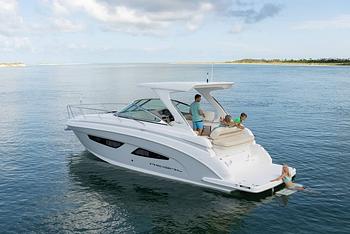
6th Sep 2024
The Best Mini Yacht Brands for Cruising and Luxury
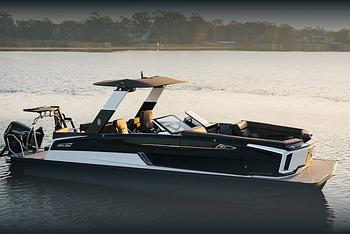
16th Aug 2024
Best Luxury Pontoon Boat Brands Have it All: Glamor, Speed, Fishing, Waterslides...
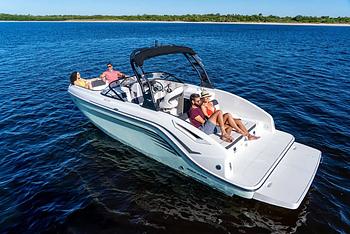
10th Aug 2024
Deck Boat vs. Bowrider: Which Runabout is Best?

19th Jul 2024
The World’s Best Yacht Brands

- Explore Rightboat
- Boats for Sale
- Boating Articles
- Buyers Guide
- About RightBoat
- Sell Your Boat
- Boat Selling Advice
- All manufacturers
- All categories
- Are you a broker/dealer?
- Learn more about the Rightboat:HUB
Enter your email to keep up to date with the latest news
Join for free
Sign up now for free and discover how easy it is to keep up to date with THE latest boats for sale. Find your right boat, and tailor your voyage to finding your next boat.
Benefits of becoming a member:
- Set up tailored alerts
- Personalise your experience
- Download full specifications and broker details
- Keep tabs on your favourite boats
Are you a broker? Join as a Broker
Rightboat - join for free.
Do you have an account already? Login
Save this search
Save your search and receive new boats in your email..
You can unsubscribe from your alerts whenever you like. By pressing the button you accept the Legal Terms and conditions
- Search Please fill out this field.
- Newsletters
- Water Sports
The Various Types of Sailboats and Rigs
Aditya Adjie / EyeEm / Getty Images
The Modern Sloop
The most common type of small-to-midsize sailboat is the sloop. The rig is one mast and two sails. The mainsail is a tall, triangular sail mounted to the mast at its leading edge, with the foot of the sail along the boom, which extends aft from the mast. The sail in front called the jib or sometimes the headsail, mounts on the forestay between the bow and the masthead, with its trailing corner controlled by the jib sheet.
The Bermuda or Marconi Rig
These tall triangular sails are called the Bermuda rig, or sometimes the Marconi rig, named for their development more than two centuries ago in Bermudan boats. Because of the physics of how force is generated by wind blowing past a sail, tall thin sails generally have more power when the boat is sailing into the wind.
Racing Sloop
Gail Oskin / Getty Images
Here is another example of a sloop with a Bermuda rig. This is PUMA Ocean Racing's il Mostro, one of the fastest monohull sailboats in the world, in the 2008/2009 Volvo Ocean Race. The sails are much bigger than found on most cruising sailboats, but the general rig is the same. In both of the sloops shown so far, the jib reaches to the top of the masthead. These are sometimes called masthead sloops.
Fractional Sloop Rig
Ahunt [CC0] / Wikimedia Commons
Here, notice a small racing dinghy with a sloop rig. This is still a Bermuda rig, but the mainsail is proportionally larger and the jib smaller, for ease of handling and maximum power. Note that the top of the jib rises only a fraction of the distance to the masthead. Such a rig is called a fractional sloop.
KenWiedemann / Getty Images
While a sloop always has two sails, a cat-rigged boat generally has only one. The mast is positioned very far forward, almost at the bow, making room for a very long-footed mainsail. The mainsail of a cat rig may have a traditional boom or, as in this boat, a loose-footed mainsail attached at the aft corner to what is called a wishbone boom.
Compared to Bermuda Rigs
A primary advantage of a cat rig is the ease of sail handling, such as not having to deal with jib sheets when tacking. Generally, a cat rig is not considered as powerful as a Bermuda rig, however, and is more rarely used in modern boats.
Cat-Rigged Racing Dinghy
technotr / Getty Images
In this photo, there is another cat rig, which works well on small racing dinghies like this Laser. With a small boat and one sailor, a cat rig has the advantages of being simple to trim and very maneuverable when racing.
John White Photos / Getty Images
A popular rig for midsize cruising boats is the ketch, which is like a sloop with a second, smaller mast set aft called the mizzenmast. The mizzen sail functions much like a second mainsail. A ketch carries about the same total square footage of sail area as a sloop of the equivalent size.
Make Sail Handling Easy
The primary advantages of a ketch are that each of the sails is usually somewhat smaller than on a sloop of equivalent size, making sail handling easier. Smaller sails are lighter, easier to hoist and trim and smaller to stow. Having three sails also allows for more flexible sail combinations. For example, with the wind at an intensity that a sloop might have to double-reef the main to reduce sail area, a ketch may sail very well under just jib and mizzen. This is popularly called sailing under “jib and jigger”—the jigger being an old square-rigger term for the aft-most mast flying a triangular sail.
While a ketch offers these advantages to cruisers, they may also be more expensive because of the added mast and sail. The sloop rig is also considered faster and is therefore used almost exclusively in racing sailboats.
Public Domain
A yawl is very similar to a ketch. The mizzenmast is usually smaller and sets farther aft, behind the rudder post, while in a ketch the mizzenmast is forward of the rudder post. Aside from this technical difference, the yawl and ketch rigs are similar and have similar advantages and disadvantages.
Tomás Fano [ CC BY-SA 2.0 ], via Wikimedia Commons
A typical schooner has two masts, and sometimes more, but the masts are positioned more forward in the boat. Unlike in a ketch or yawl, the forward mast is smaller than the aft mast (or sometimes the same size). One or more jibs may fly forward of the foremast.
Traditional Schooners
While some modern schooners may use triangular, Bermuda-like sails on one or both masts, traditional schooners like the one shown here have gaff-rigged sails. At the top of the sail is a short spar called the gaff, which allows the sail to extend back along a fourth side, gaining size over a triangular sail of the same height.
Gaff-rigged schooners are still seen in many areas and are well loved for their historic appearance and sweeping lines, but they are seldom used anymore for private cruising. The gaff rig is not as efficient as the Bermuda rig, and the rig is more complicated and requires more crew for sail handling.
Schooner With Topsail and Flying Jibs
Print Collector / Getty Images
Above is another gaff-rigged schooner that is using a topsail and several flying jibs. Tacking or gybing a complicated sail plan like this takes a lot of crew and expertise.
Square-Rigged Tall Ship
Bettmann / Getty Images
In this illustration, notice a large three-masted square-rigger flying five tiers of square sails, several headsails, and a mizzen sail. Although this is a modern ship, one of many still used around the world for sail training and passenger cruise ships, the rig is essentially unchanged from centuries ago. Columbus, Magellan, and the other early sea explorers sailed in square-riggers.
Generating Power
Remarkably efficient sailing downwind or well off the wind, square sails do not generate power from their leading edge as in the Bermuda rig, which has become predominant in modern times. Thus, square-riggers generally do not sail upwind. It was due to this limitation that the great trade wind sailing routes around the world were developed centuries ago.
Related Articles
More related articles.

Types of Sailboats: A Comprehensive Guide
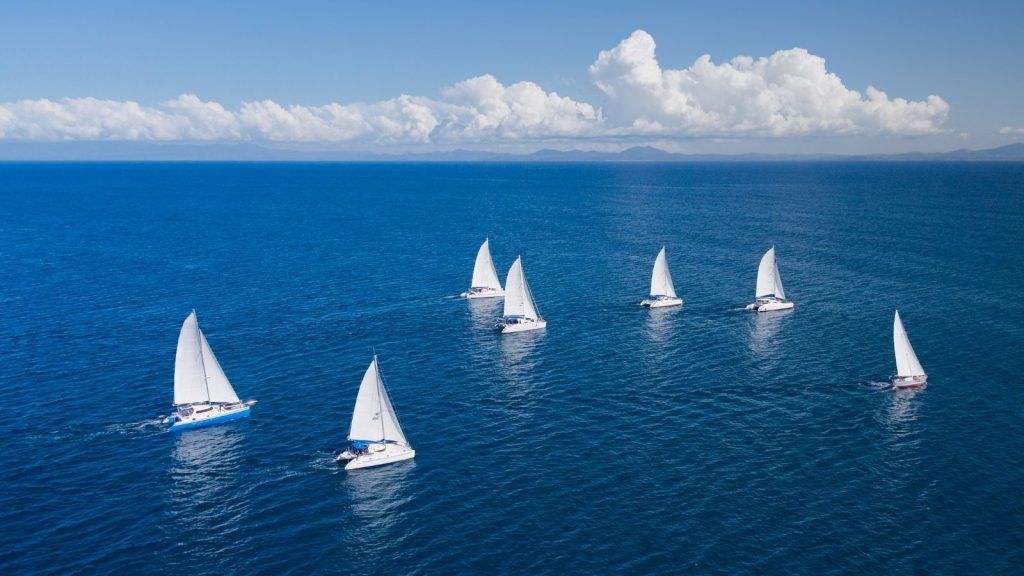
Sailboat types differentiate by design and use. Sailboats come in a vast variety of shapes and sizes, so let’s divide them by hull types, rig types and their primary use.
The sailboat is a water vessel propelled by the wind. It is usually smaller than a sailing ship but has the components that keep it propelled in water. When someone talks about sailboats, many people would not know he/she isn’t talking about one set of sailboats.
Unknown to many people, there are several types of sailboats. Each set of sailboats are different from others according to their classifications. We can classify the types of sailboats according to their hull types, rig types, and primary use. Let’s take a glance at the types of sailboats.
Sailboat Hull Types
This classification of sailboats bases on the number of hulls the sailboat has. The hull is the part of the sailboat that rides on and in the water. The hull does not include the sails, masts, equipment, or machinery. Here are the types of sailboats under this classification.

Monohulls are like every other water vessel with only one hull. They are the most conventional type of sailboat in this category. They may have a swing, full, cutaway, bolted on fin keels.
Monohulls can enter shallow water and move faster downwind. They usually have large beams that provide them with stability while sailing.

The multi-hull vessel is the type of sailboats with two or more hulls. Multihulls come in all shapes and sizes.
Catamarans (often nicknamed “cats”) or twin-hulled sailboats have two hulls instead of one like the ones in monohulls.
Catamarans do not have deep and heavy keels, making them sail faster off the wind.

They have designs for general cruising as they offer more interior deck space with easier motion. There is also an increased level of stability in catamarans.
The number of hulls ranges from 3 to 5, with three hulls as the most common. Some people refer to sailboats with three hulls as trimarans.
They are extremely stable due to their number of hulls. A trimaran is a multihull boat with a main hull and two side hulls (smaller outrigger hulls used for stability) linked to it.

More giant multi-hull crafts with 4 or 5 hulls are challenging to manufacture, hence used for commercial purposes.
These commercial sailboats also get decorated to make them look more attractive. Multi-hull vessels with more than three hulls usually had the opportunity to be decorated by general contractors for commercial use.
Sailboat Rig Types
These sailboat classifications depend on the type of rig the sailboat has. The rig consists of cables and chains, ropes, masts, shrouds, braces, sheets, and other components that support a sailboat. Let’s take a look at the types.
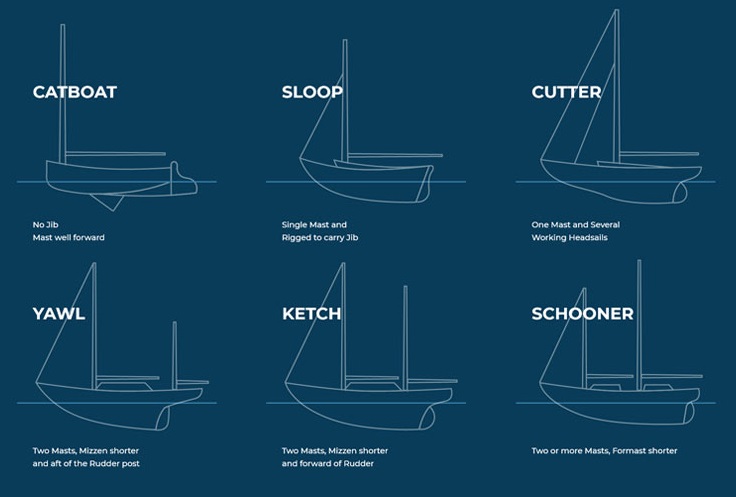
The sloop is a sailboat with one mast, one mainsail, and one headsail. The mast supports the mainsail and headsail during sails. The two-sail configuration allows added maneuverability. There is also a fractionally-rigged sloop with one of its sails lying below the mast’s top.
Cutters are medium-sized sailboat types with three sails. The sail gets mounted on the mainmast located near the ship’s stern to allow the use of more extensive sales. The design of cutters explains their agility and speed. They have two or more headsails, making them flexible for varying wind conditions.
Ketches and yawls
The ketch has two masts; the primary mast is at midship, while the second one is behind it at the aft. The secondary mast is smaller than the primary mast and helps improve the craft’s speed during sails.
The schooner is a sailboat with two or more masts; the mainmast and the foremast. The foremast is slightly shorter than the mainmast, located at the craft’s fore. If there are additional masts, they get a position whereby they become shorter than the mainmast.
Sailboat Types by Primary Use
There is also a classification of sailboats according to their uses. Although all sailboats have general services, they also have their specialization area. Let’s take a glance at the types of sailboats according to their primary use;
Day cruisers: Day cruiser sailboats are usually shorter than 30 feet and have designs for afternoon sailing. They may or may not have a cabin with amenities.
Racer/cruiser: They are usually lightly built cruisers with amenities. Some typically use it for cruising and racing. It can also serve a weekend cruising purpose.
Sailing dinghies: Sailing dinghies are small sailboats that can accommodate only one or two people. They are most useful in teaching new sailors how to sail.
Sailing cruisers: Sailing cruisers can either be multi-hulls or monohulls designed for weekend or longer cruising.
Racing sailboats: Racing sailboats have designs that help accommodate larger boat crews. They often have fin keels for more effortless sailing performance.
There are different types of sailboats, and these types have their classification. Each classification, like hull types, rig types, and primary use, shows the type of sailboat you have. You can decorate your sailboat by hiring a general contractor for the task. Doing this will give you a personalized feeling when sailing.
Check out some tips for buying a sailboat and make the ocean dream tour come true.

Now that your boat is all ready for sailing, you will want to find the perfect marina for the adventure of your life.
Is there any place that you always wanted to visit and enjoy from the depths of the blue sea? Spain, Croatia, Italy, France, Greece, or any other exotic destination?
If the only thing stopping you is the dread of reservations or not being able to make up your mind on a certain location, no need to trouble yourself as we have the solution for you.
Exploring the world has never been easier with the marina reservation platform that connect boaters to marinas for all their reservation needs. What are you waiting for? Sail on!
Leave a Comment Cancel Reply
Your email address will not be published. Required fields are marked *

IMAGES
VIDEO
COMMENTS
Learn the names and features of 17 common sailboat types, from dinghy to tall ship, with pictures and examples. Find out how to identify a sailboat by its hull, keel, sail plan, and rigging.
A sloop is a sailboat with one mast and two sails, a mainsail and a headsail. Learn about different types of sailboats, such as fractional rig sloop, cutter, ketch, schooner, yawl, and cat, and how they are used for sailing.
Learn about the different types of sailboats, their hulls, rigs, and uses. Find out the pros and cons of monohulls, multihulls, sloops, cats, ketches, and more.
A partial list of sailboat types and sailing classes, including keelboats, dinghies, and multihull (catamarans and trimarans). Find out the names, years, designers, builders, and notes of various sailing boats, from Olympic classes to development classes.
Learn about the different types of sails and rigs for sailboats, from mainsails and headsails to spinnakers and gennakers. See pictures and diagrams of sail shapes, parts, and functions for various conditions and boats.
Learn about the basics of sailboat design, including hull types, keel types, and mast configurations. Explore the different rig types and sail types used on various sailboats and how they affect sailing performance and handling.
Learn about the different types of sailboats based on their hulls, keels and masts. Find out the advantages and disadvantages of monohulls, catamarans, trimarans, bilge keels, centerboards, daggerboards, fins, full keels, wings, sloops, schooners, cutters, ketches and catboats.
Learn about the factors that determine the types of sailboats, such as hull, keel, mast, and sails. Discover the most common types of sailboats, including cruising, racing, daysailers, catamarans, and trimarans, and their advantages and disadvantages.
Learn about different sailboat types by hull, rig and use, from monohulls to trimarans, from sloops to schooners. Find out how sailboats are designed, built and used for sailing dinghies, day cruisers, racing, cruising and more.
The hull is the body shape of the boat: the part that floats in or on top of the water surface and provides the boat's buoyancy. While most sailboats use the same hull design, there are many different types, all with different properties. The type of hull affects your boat's performance, handling, stability, and safety.
Whether you're new to sailboats or already an American Sailing Association (ASA) certified skipper, knowing the difference between the different types of vessels is essential. We'll provide you with a basic understanding of the different types of sailboats, the advantages of each, and which type of voyage they're best used for.
Learn about the different types of sailing boats, such as monohulls, catamarans and trimarans, and their features, such as keel, rudder and mast configurations. Find out how sailing boats are used for cruising, racing and leisure activities on various waters.
Learn about the different types of sailboats based on their hull and keel design, such as monohulls, catamarans, multi-hulls, dinghies, cutters, sloops, catboats, ketch and schooners. Find out their features, advantages and disadvantages, and how they are used for sailing competitions, cruises and recreation.
Monohulls. Think classic sailboats - these are the most common, offering stability and a variety of keel types. Imagine a deep keel slicing through waves, providing a smooth ride, or a shallow draft monohull skimming across shallow bays. These trusty vessels are the workhorses of the sea, offering stability that makes them a favorite among ...
Learn about different types of sailboats, their hull shapes, sizes, and sail plans. A sailboat is a boat that uses wind power to move, and it can have one, two, or three hulls and one or more masts.
Learn about different types of sailboats by size, rig type, number of hulls and construction material. See pictures and descriptions of dinghies, cruising sailboats and tall ships.
A schooner is a two-or-more masted sailboat, in which the aft-most mast - the mainmast - is the same height or taller than the foremast. The one shown here is gaff cutter rigged, with a topsail set on the mainmast. Many sailors agree that of all the different types of sailboats, a schooner under full sail is one of the most beautiful sights afloat.
Learn about the various types of sailboats, such as catboat, cutter, dhoni, dinghy, fractional rig sloop, ketch, schooner, sloop and yawl. Find out their features, history, popularity and sailing tips.
Different Types of Sailing Boat by Hull. With so many different sailboat variations, sailboat uses and styles of sailboat, there are different ways we can identify them, and one way is by hull type. There are three categories; monohulls (with one hull), catamarans (with two hulls) and trimarans (with three hulls). ...
Knowing the different Sailboat Types is important when learning to sail. In this section, know what the basic Sailboat Types are and learn the features of each. Below are some examples: Catboat. The catboat has a single mast well forward. This design of the sail plan emerged in the 19th century in North America and was used for fishing and ...
The Modern Sloop. The most common type of small-to-midsize sailboat is the sloop. The rig is one mast and two sails. The mainsail is a tall, triangular sail mounted to the mast at its leading edge, with the foot of the sail along the boom, which extends aft from the mast. The sail in front called the jib or sometimes the headsail, mounts on the ...
There are different types of sailboats, and these types have their classification. Each classification, like hull types, rig types, and primary use, shows the type of sailboat you have. You can decorate your sailboat by hiring a general contractor for the task. Doing this will give you a personalized feeling when sailing.